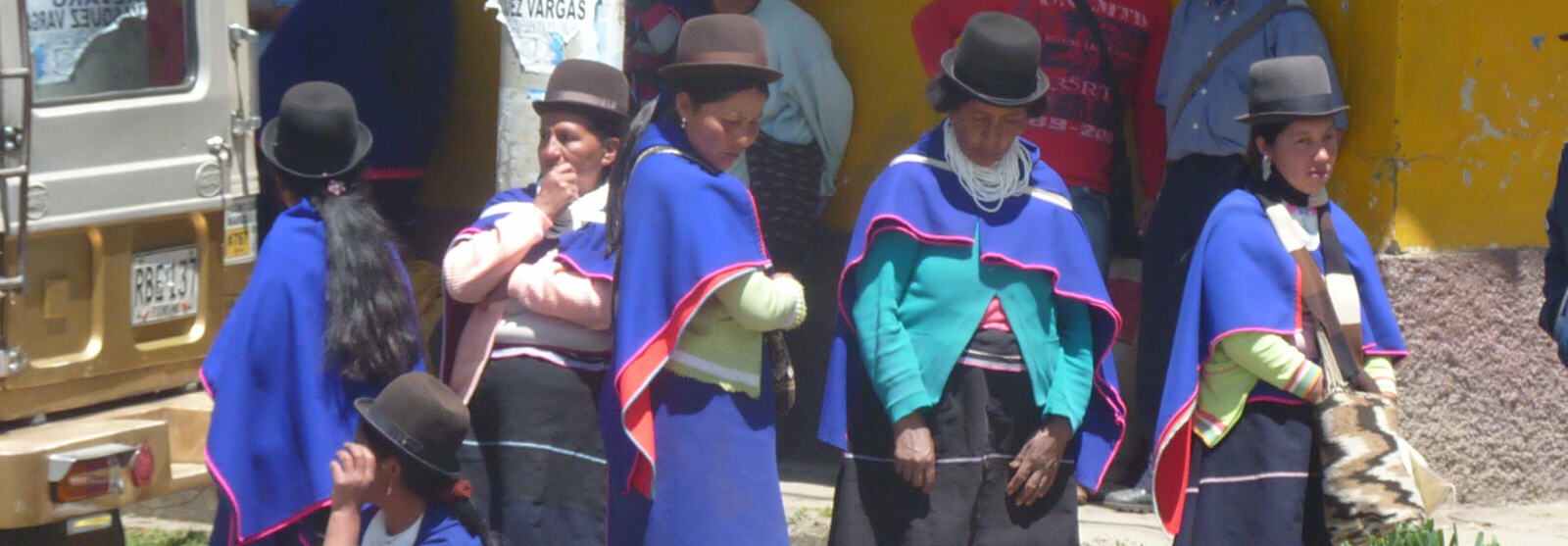 |
Our third Big Bus Ride through South America
October-November 2015
|
From the Atlantic via the Pacific to the Caribbean; starting in Argentina, through Bolivia, Peru and Ecuador to Colombia. Total distance by bus and car (not including the flights) 4500 miles, 7200 km (more than London to Moscow and back). Red lines are our overland route, blue lines are flights. |
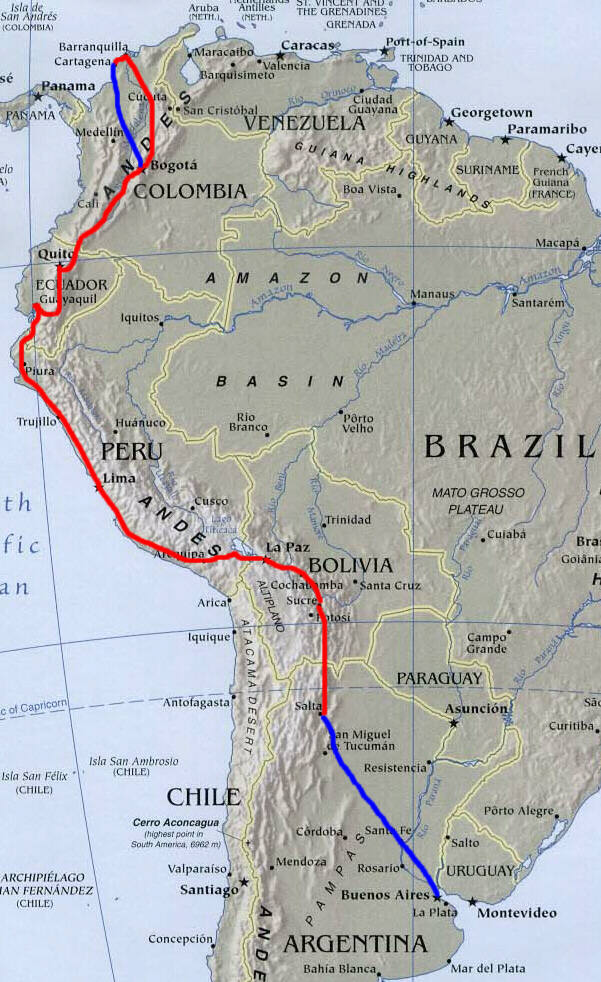
|
Buenos Aires, Argentina
|
Weds 7th - Thurs 8th Oct. After a stressful day trying to get packed in time we relaxed in the Aspire lounge at Heathrow terminal 5. Then we had a 13-hour flight to Buenos Aires but it was pleasant enough. We got a taxi to Obelisco Centre Suites, where we had a nice spacious suite with a view of the Obelisk from our balcony on the 7th floor. |
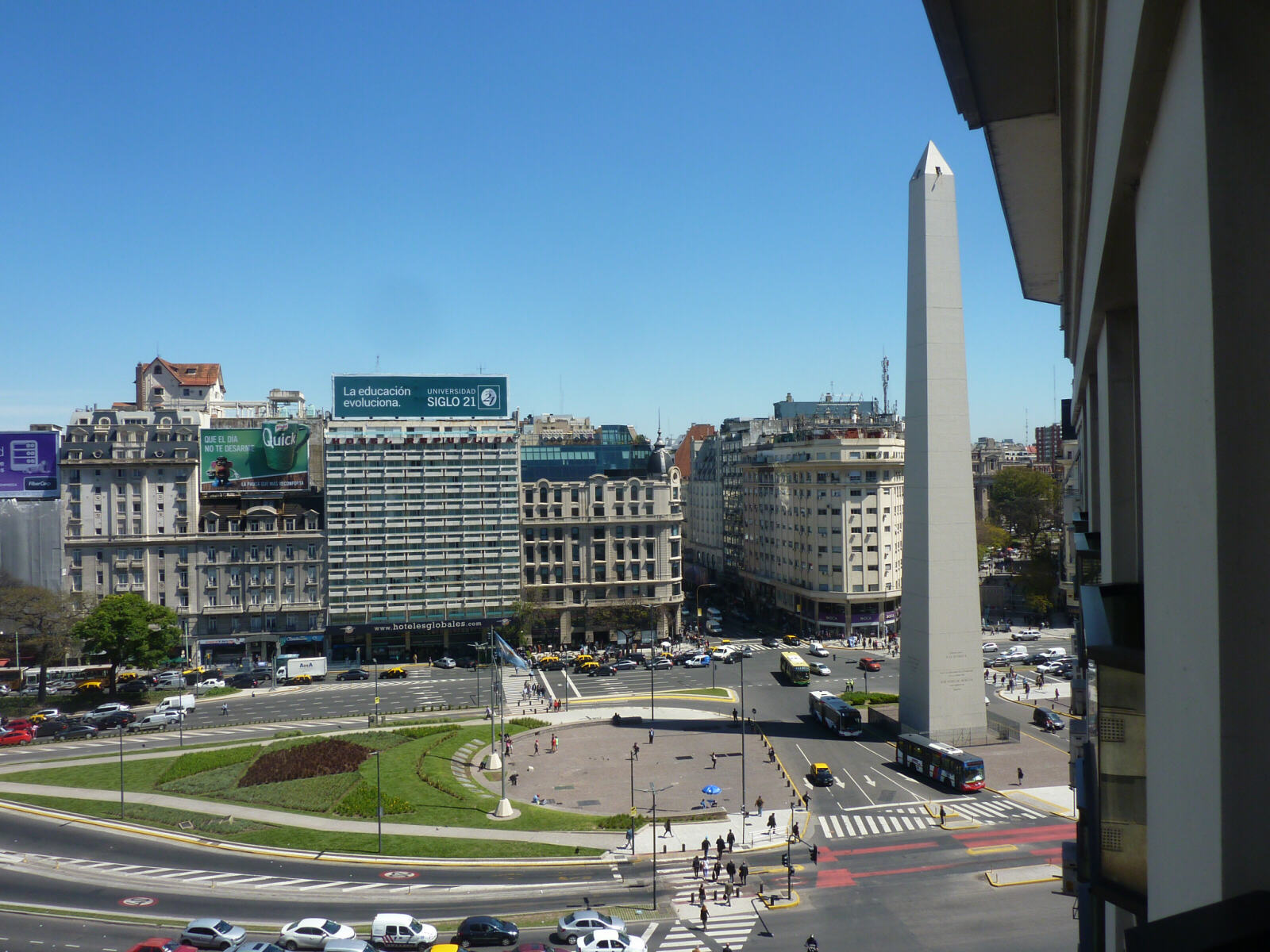
|
We walked up and down the huge Avenue 9 July until we got our bearings and went four blocks up the road to Museo del Jamon restaurant, one of our favourites from our last visits in 2002 and 2003, where we had a wonderful lunch of hand carved prosciutto and cheeses with glasses of wine. Feeling pretty sleepy (I blame it on jet lag but the wine might have exacerbated it) I went to a café opposite the hotel and watched the world go by over a Macchiato while Sheila had a snooze in the hotel. In the early evening (BA doesn´t get going until late but we were too tired to adjust today) we strolled along the pedestrian Lavalle Avenue past all the barbecue restaurants and settled on a nice corner restaurant where we had pizza and empandas with a very nice litre bottle of Stella Artois noir with an ice bucket to keep it cool.
Fri 9th. We set out on a walking tour of the shops because Sheila needed some retail therapy (so soon!). We went down Avenue Libertad past parks, monumental theatres and government buildings to the up-market (with prices to match) Recoleta district and Patio Bullrich, a shopping mall in an elegant classical-style building. Then via Plaza San Martin to Florida, a lively pedestrianised street with lots of shopping opportunities. Luckily Sheila didn´t buy much and we turned into Lavalle, the other busy pedestrianised street with lots of restaurants, intending to return to Valerio, the place where we had black beer last night, to find to our dismay that it was closed due to some problem with the gas supply to the kitchen. We ended up in Café Parisien in a nice location for people-watching but with very sub-standard empanadas. They eat late in BA so we whiled away the early evening reading and dozing, then about 8:30 we went to an old favourite from our previous visits, La Estancia grill-barbecue restaurant, and had a wonderful steak with ´provincial´ french fries and various sauces with more black beer. Argentina is famous for its grasslands, cows and steaks and we weren´t disappointed. |
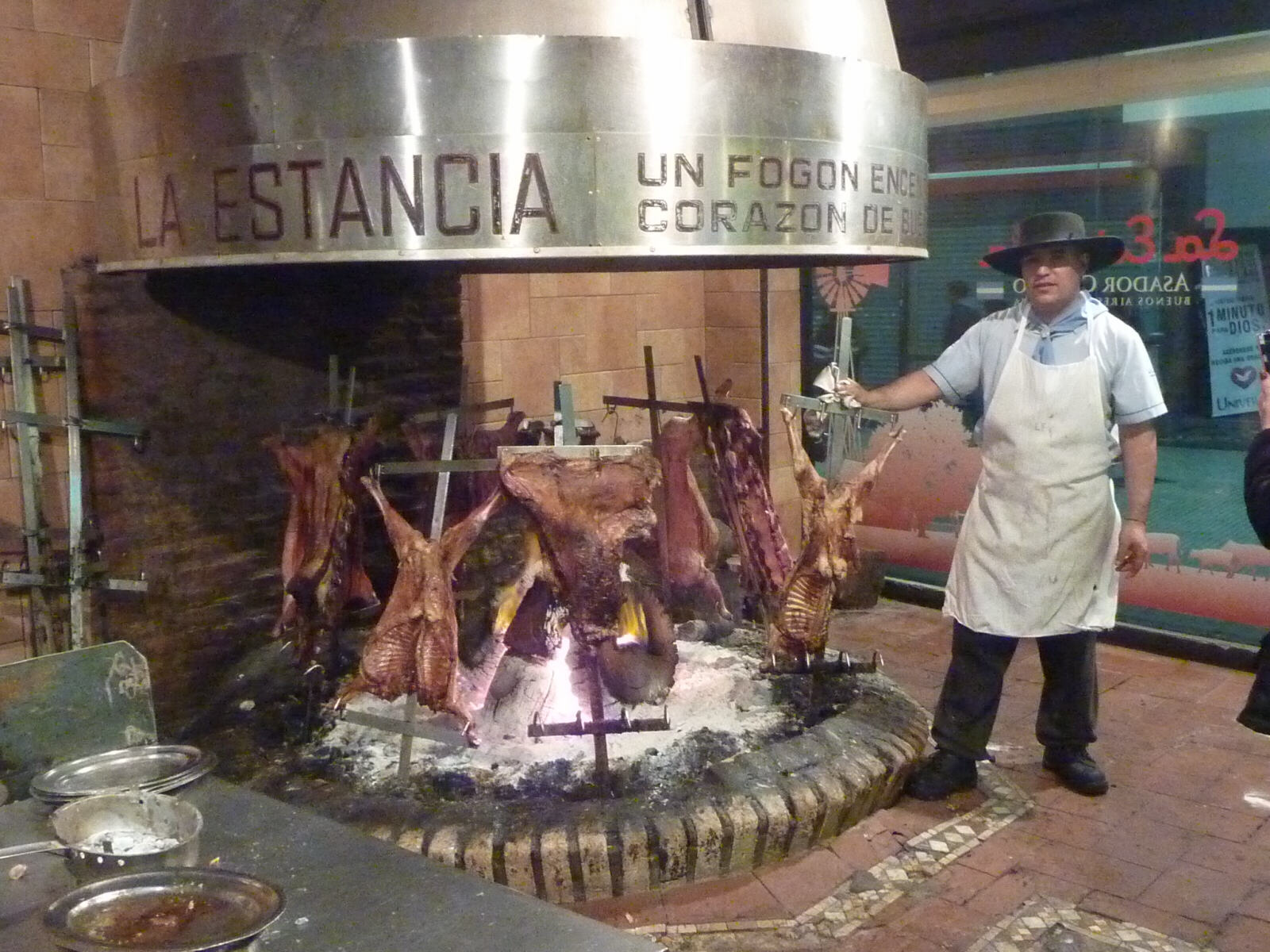
|
Sat 10th. What a busy day! After breakfast we walked all the way down Lavalle, pausing only to buy some fridge magnets in a souvenir shop, to Puerto Madero, the former docks where the red-brick warehouses have been converted to upmarket restaurants. For 25 pence each we looked around the Uruguay, a tall ship that, amongst other things, rescued some stranded scientists from Antarctica in 1903.
We got a taxi to Caminito street in La Boca, the lively old port district with colourful painted old workers´ houses, now cafés, restaurants, artists´ studios and souvenir shops. The Pope and Maradona shared equal billing in front of a souvenir shop (first picture), but the lady in the upstairs window looks more disreputable (second picture). The dog (third picture) appears to be a fan of the Argentina football team. We had a coffee in a colourful little café and a tasty hot dog from a street vendor and stopped to watch the open-air tango shows on the pavements in front of the cafés. |
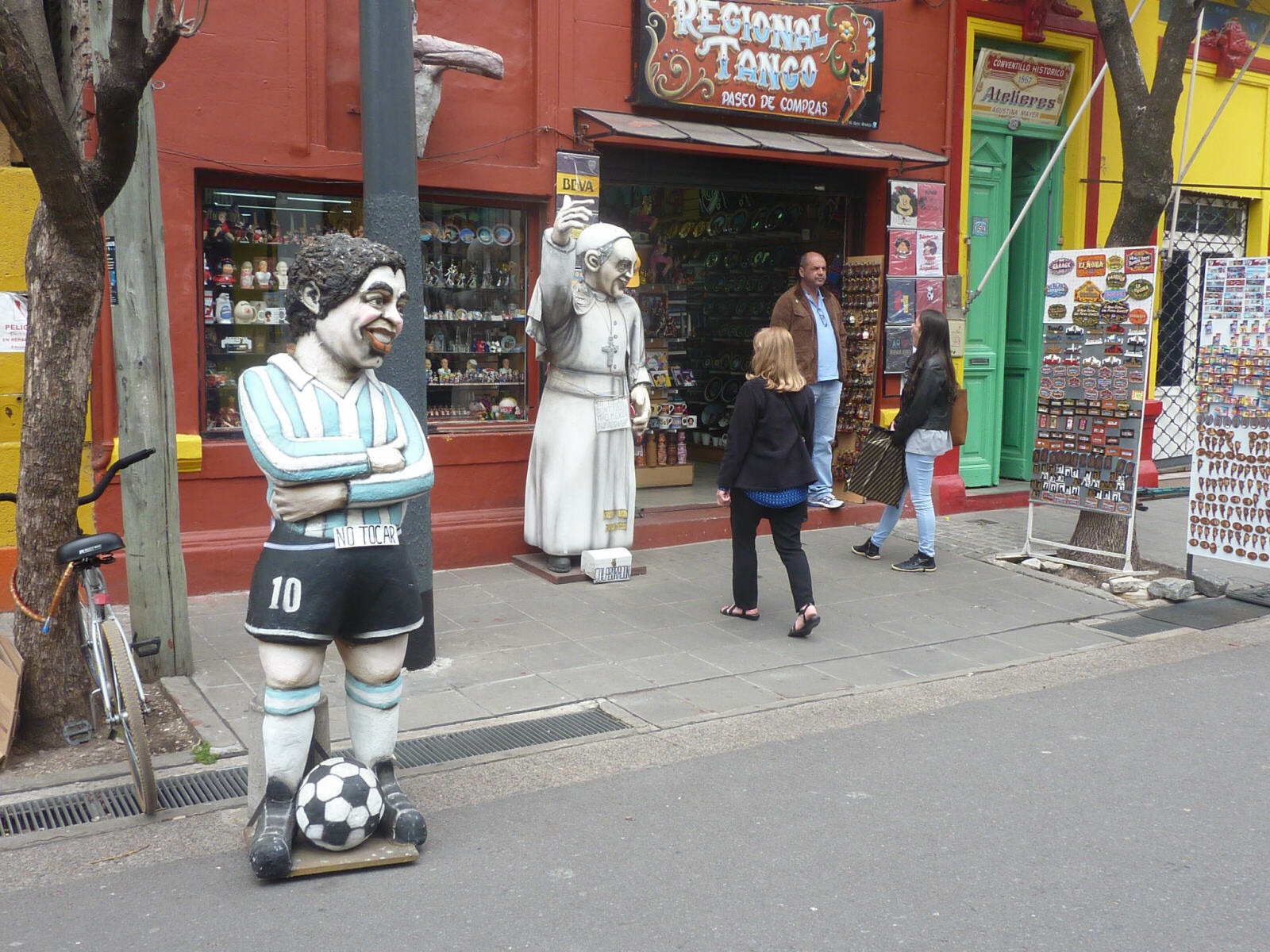
|
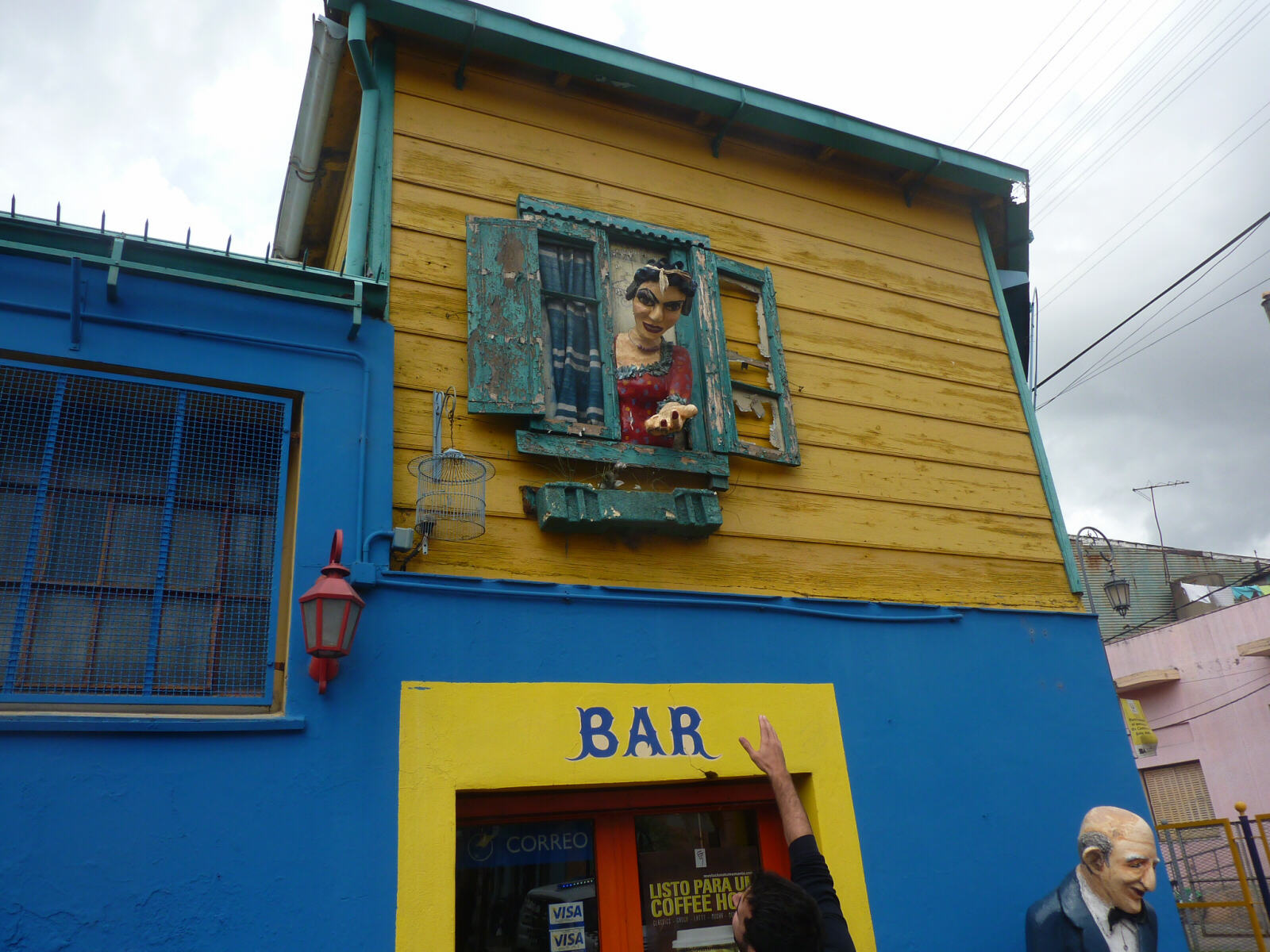
|
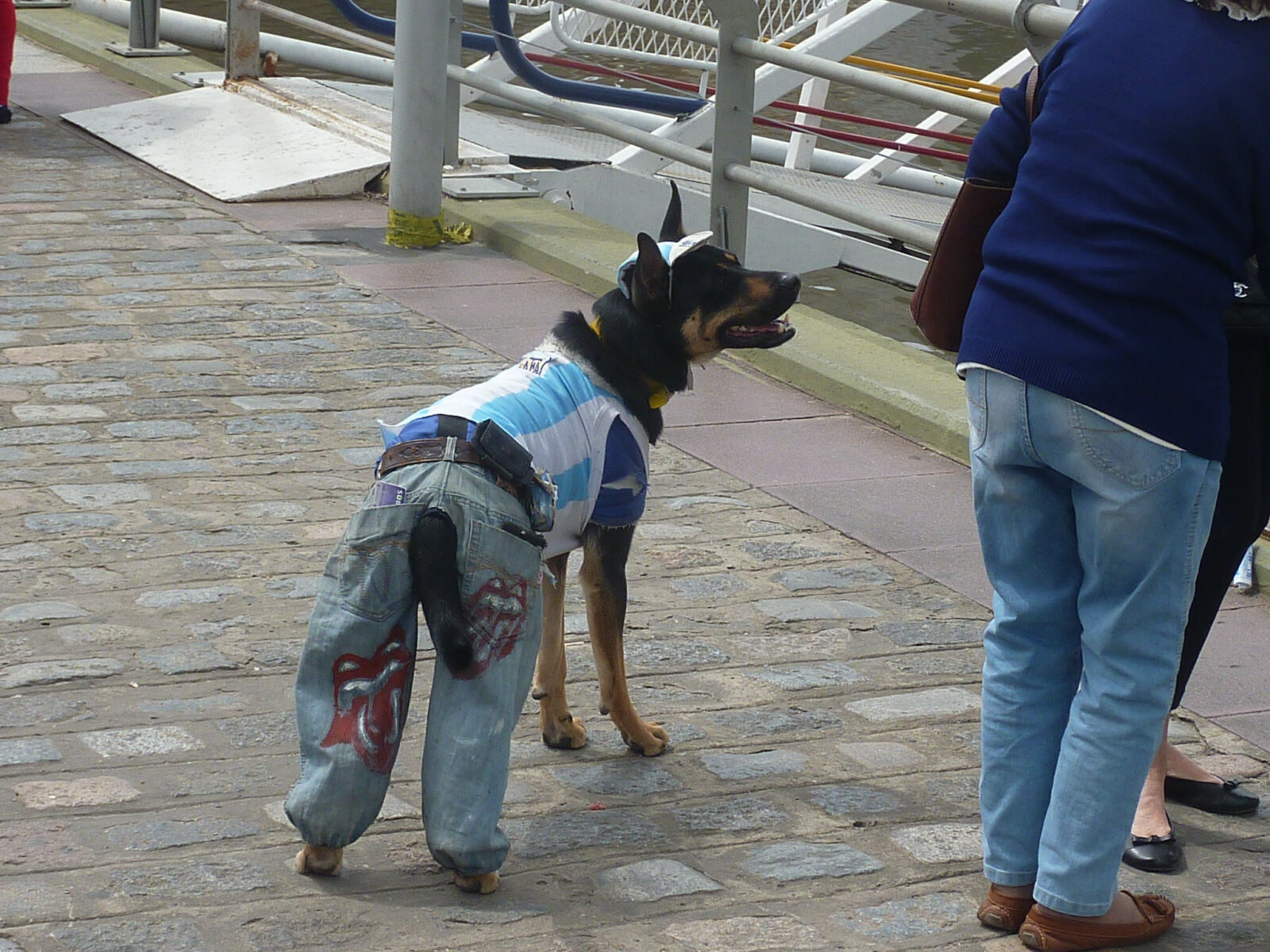
|
We got a taxi back to the centre intending to have some lunch but when the traffic became gridlocked we got out and discovered that the roads were closed because of a carnival procession. For six hours we watched the colourful dancers in fantastic costumes, each group accompanied by its own marching and dancing brass band. We started on the street alongside the start of the procession, briefly in a bus shelter while a short, sharp shower went over, then followed the procession along the avenue to the Obelisk to find that it was passing right by our hotel, so we continued with a grandstand view from our balcony. |
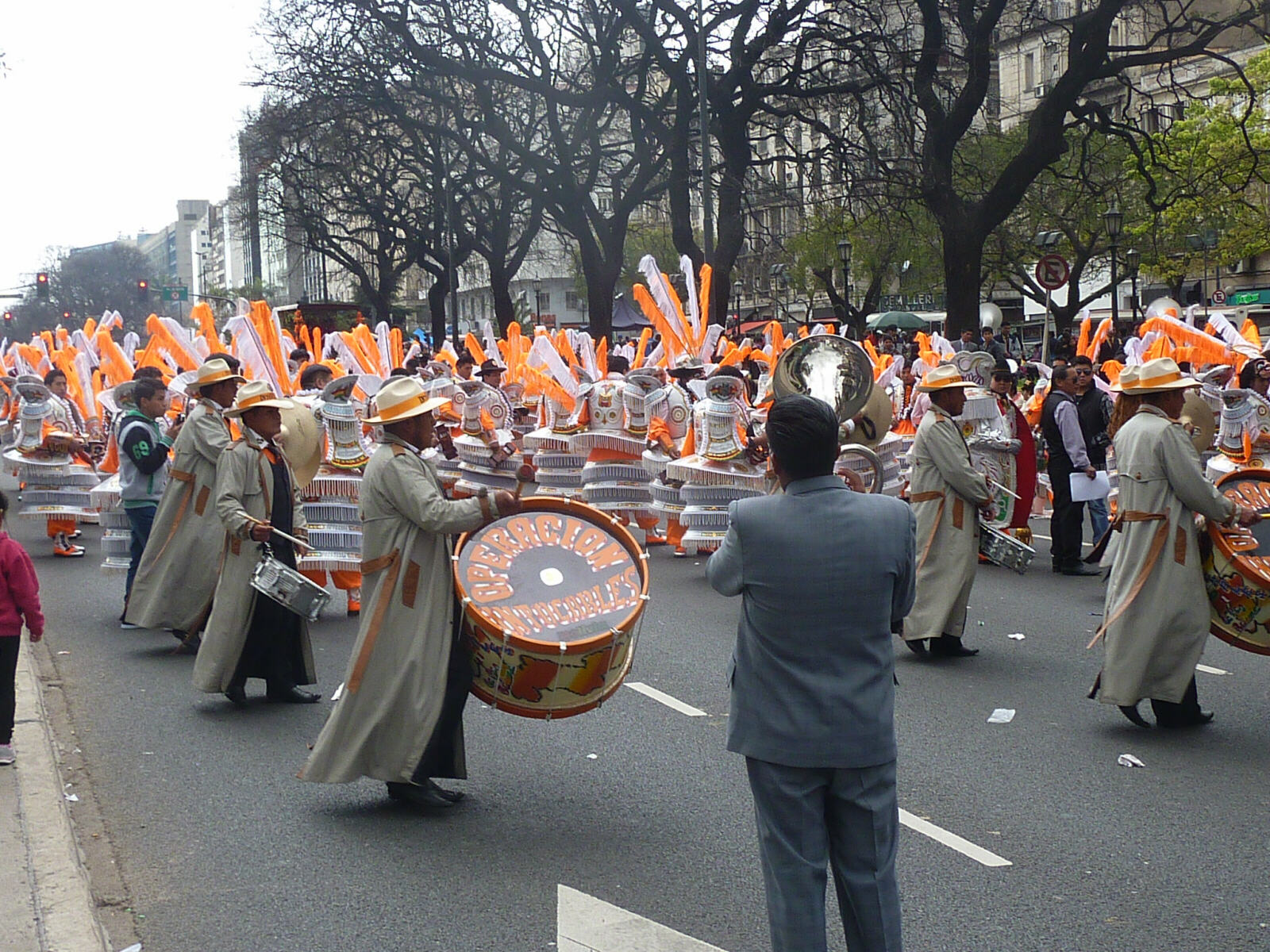
|
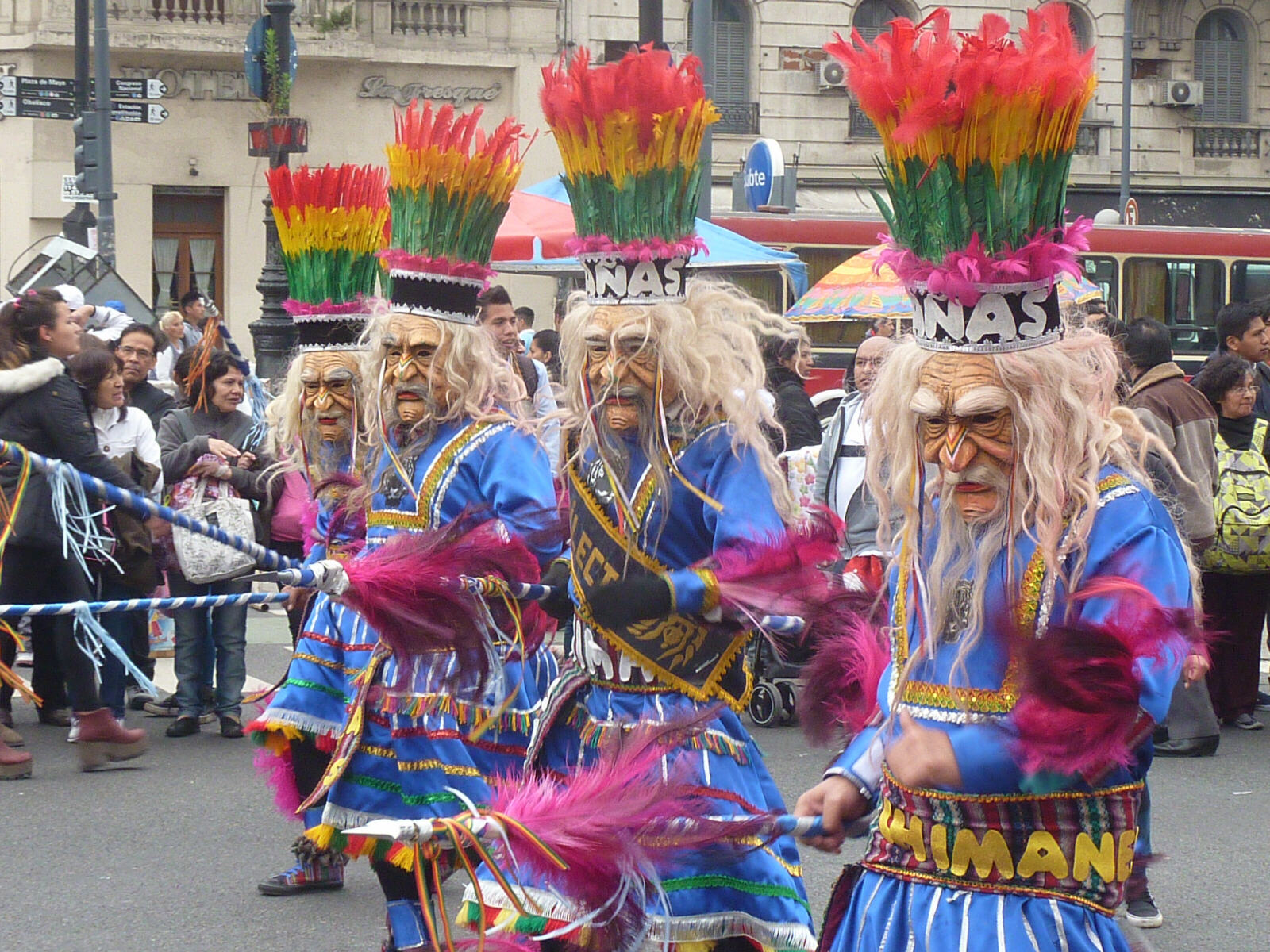
|
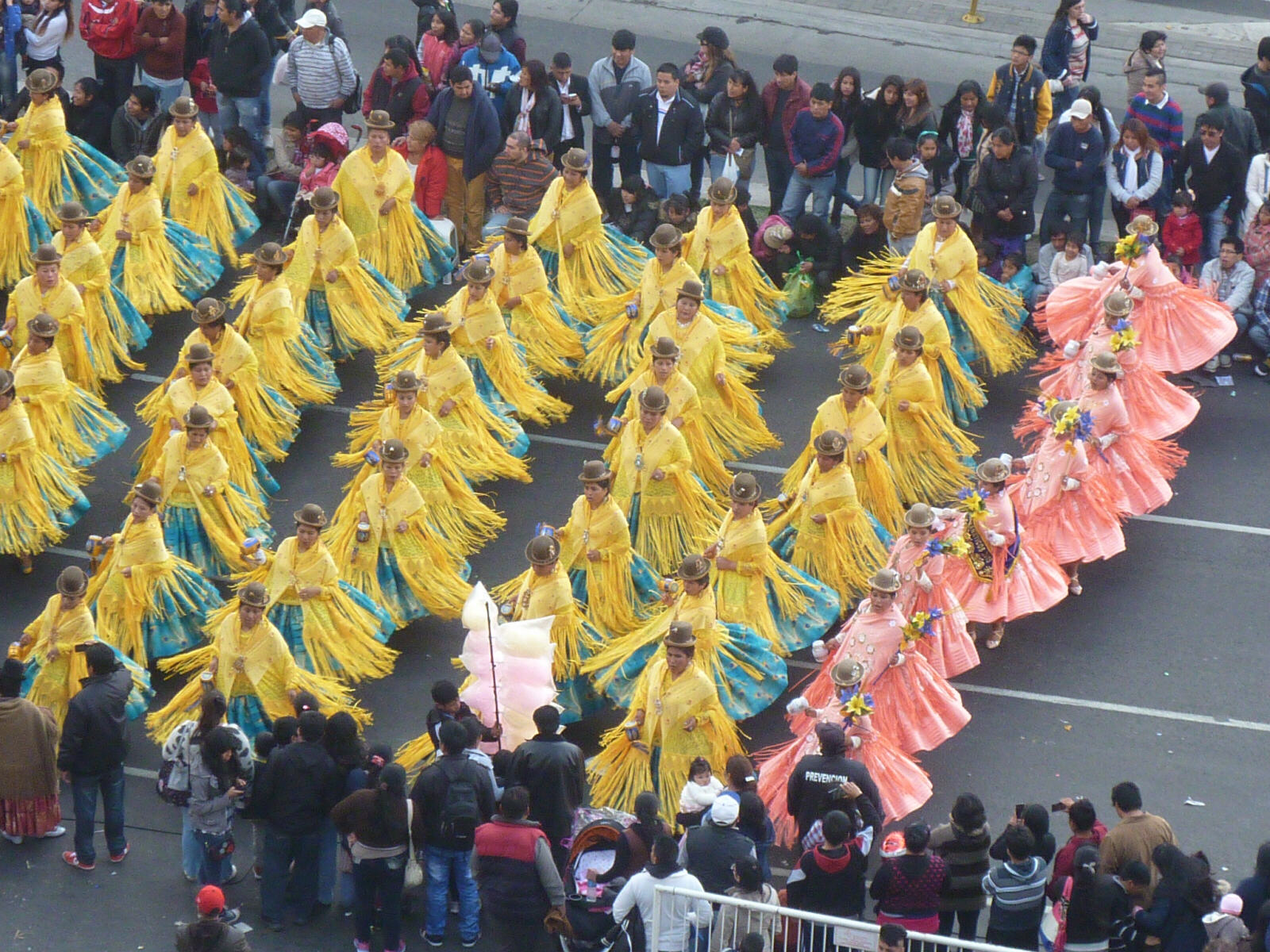
|
Finally at 8pm we had to go out for a meal (still very early by BA standards), so we walked alongside the procession for a while then went to La Estancia for another wonderful steak with all the trimmings. When we got back to the hotel at 10:30 the carnival was still in full swing and it carried on until about midnight.
Sun 11th. By contrast, a very quiet day. Rain was forecast although we didn´t see much of it, so we went for a big late lunch of steak and fried egg at Valerio, with black beer of course, and spent the rest of the afternoon flopping around in our room.
Mon 12th. After another stroll round sightseeing and almost shopping (most shops don’t open until well after 10am) we got a taxi to Jorge Newbery airport, a pleasant modern terminal with a view of the sea (or rather the river Plate estuary) and a two-hour flight to Salta. |
Salta, Argentina
|
We had booked Posada de las Nubes (hotel of the clouds) which was a nice quiet place in an old-fashioned single-storey house with amazingly high ceilings and rooms around a small courtyard garden. It was a little way away from the city centre where we stayed on previous visits but near another pedestrian street with bars and restaurants which didn´t open until later, like most things in Argentina. We had a dark beer in Café del Tiempo, a bar on the corner which was just getting set up for the evening. Nearby was one of our old favourites, Jose Balcarce restaurant, but we found to our dismay that it´s closed all week for ´remodelling´ (the nice man we met there said actually the roof of the old building was leaking and they´ve had to refit all the kitchen). He directed us to ´their other restaurant´ a few blocks away but it didn´t look nearly as nice so we went to the nearby Café del Tiempo, another branch of the place where we had a beer, but this was much more atmospheric and a restaurant rather than bar, and we had delicious steaks there.
Tues 13th - Wed 14th. The weather was much improved so we strolled around the shopping streets and the squares, looked in the magnificent cathedral and booked our bus to Bolivia. We went back to our old favourite from previous visits, Casa Moderna, an old-fashioned deli and restaurant, with the walls covered in shelves with hundreds of bottles of wine, liqueurs, etc. We had the platter of meats and cheeses which was absolutely delicious. For pudding we had a quarter kilo tub of dulce de leche ice cream from the shop near the hotel (a scoop just isn´t enough for Sheila) and then after a snooze and a cup of coffee we sat in the chairs in the garden outside our room in the sunshine, watching the man watering the beautiful-smelling jasmine and climbing roses.
|
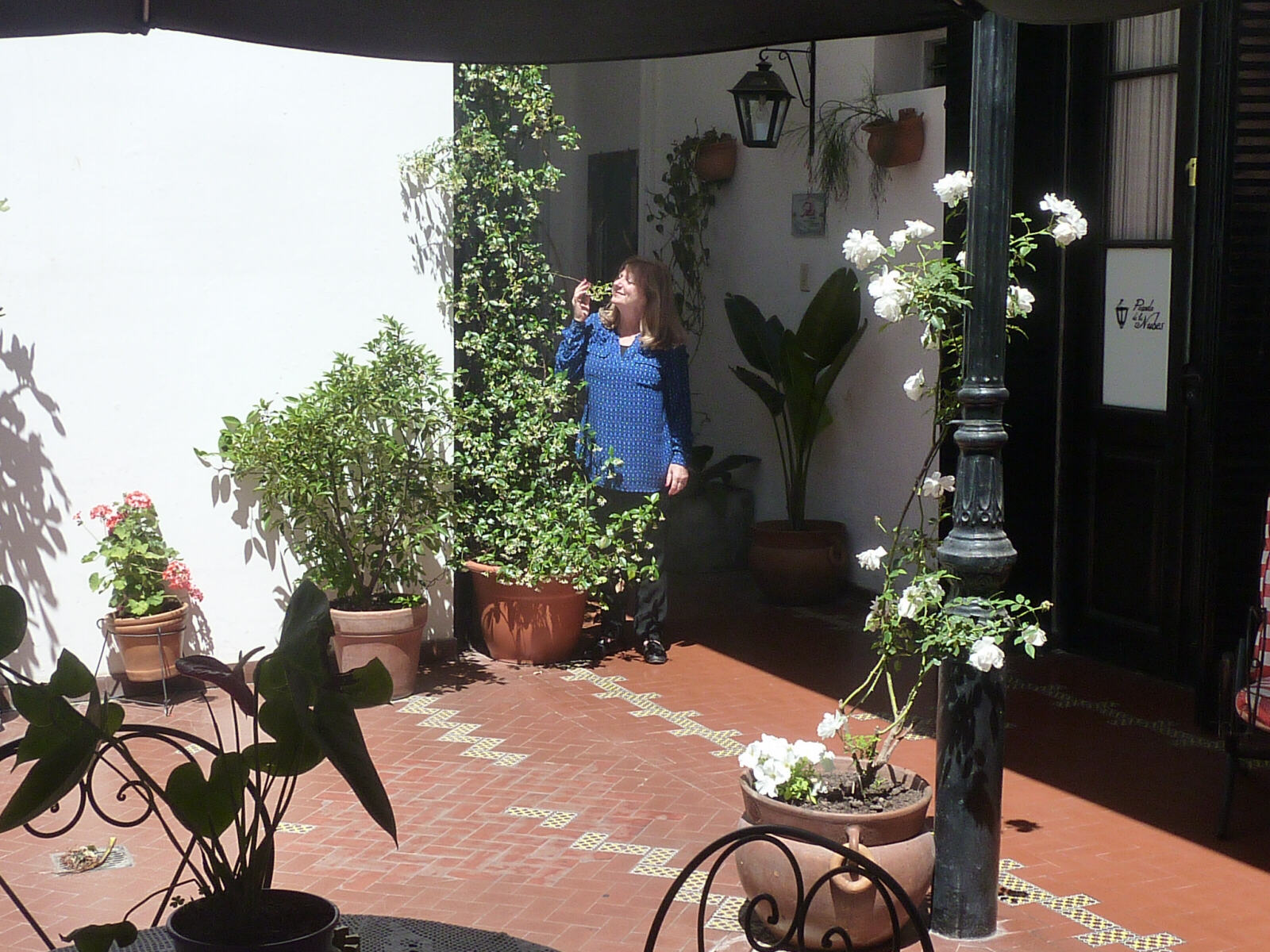
|
Sheila had a first ‘go’ at the beauty salon, I’m sure there will be more of that to come. After a bit more strolling around in the warm evening we went to the nearby Adelina restaurant for delicious llama steak and filet mignon in a green onion sauce, with nice wines from Cafayate vineyard that we visited some years ago.
Thurs 15th. After saying goodbye to Luciana, the nice lady at Posada de las Nubes, we got a taxi to the bus terminal and got the 10:30 Balut bus for La Quiaca and the Bolivian border. The bus was very comfortable and luckily we had the front seats upstairs with a panoramic view of the ´coloured canyons´ as we passed through Jujuy and Humahuaca. |
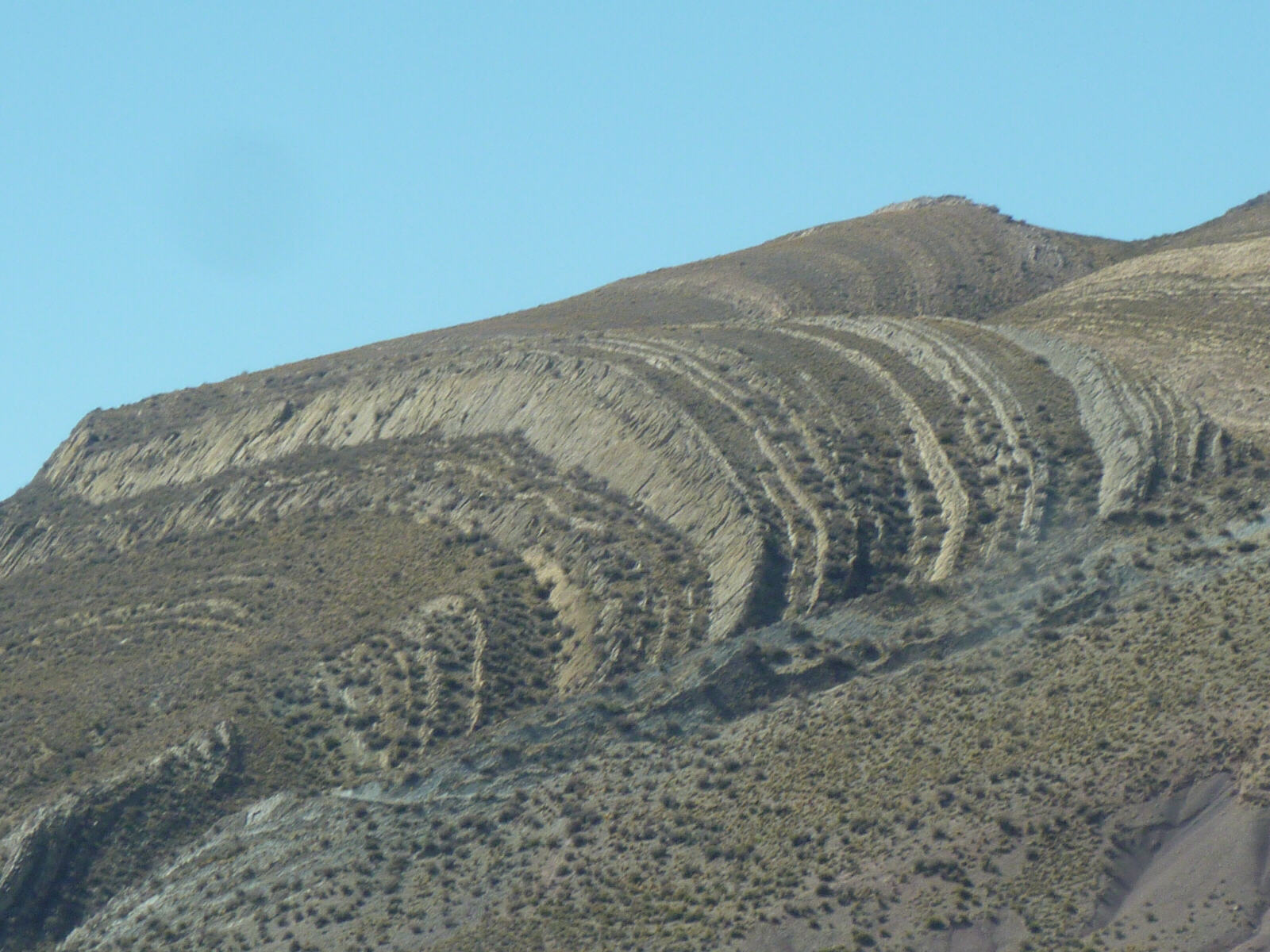
|
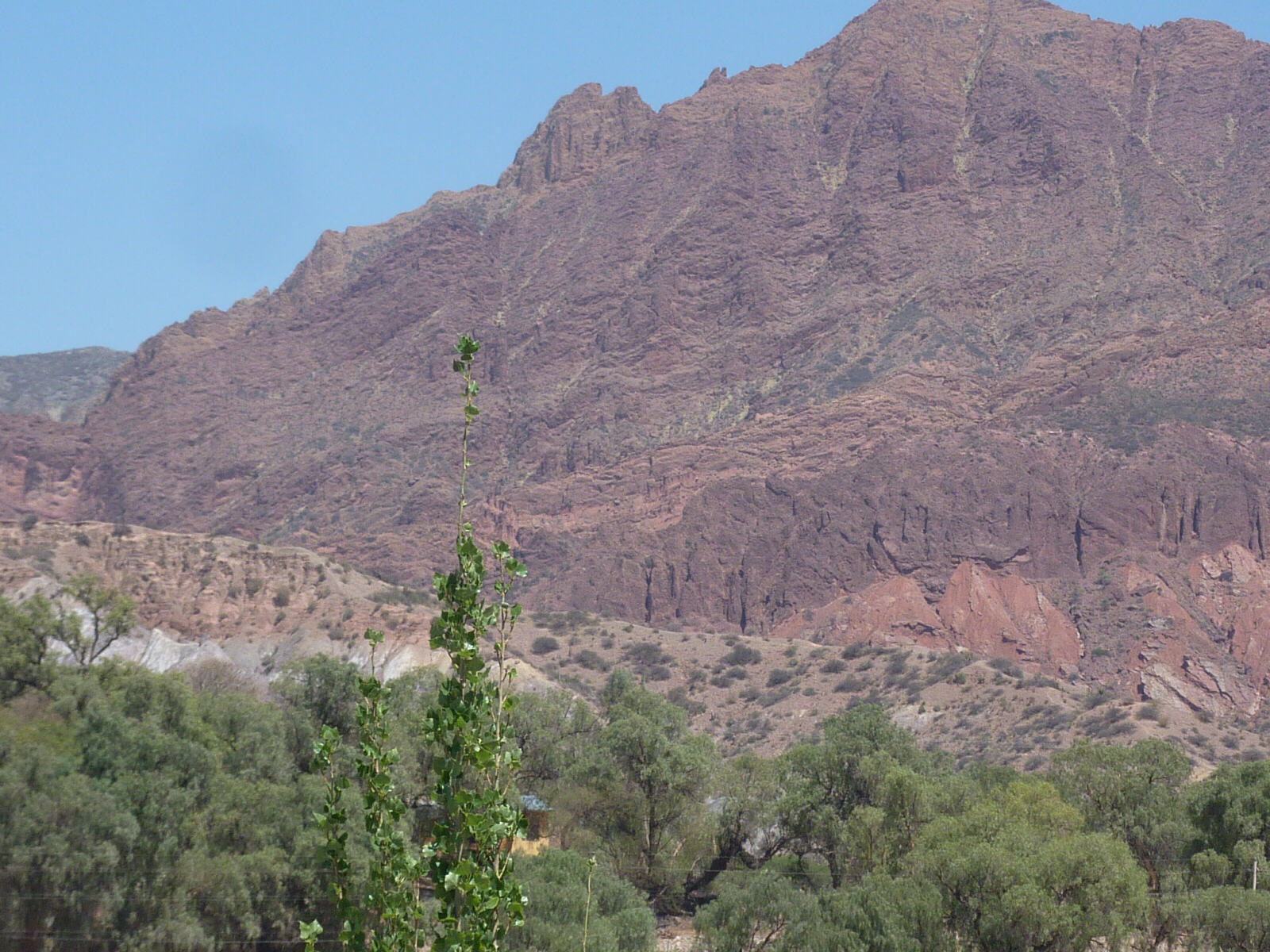
|
Argentina-Bolivia border
|
We were on schedule to arrive and get through the border in daylight when the first problem arose – some protestors blocked the road then stood around not visibly protesting for an hour while a queue of traffic formed and a couple of police who arrived stood around with them. Despite this we got to La Quiaca on the Argentine side of the border in daylight but in the rush to get off the bus Sheila left her handbag behind and when she went back for it, the bag was there but her expensive smart phone wasn´t. We eventually found a police station and tried to report the loss but they didn´t speak English so there was a lengthy wait until a very nice lady interpreter arrived. With her help we went through a lengthy procedure to get a loss report form and it looked like we would never get to Bolivia, but eventually it was done and we got a taxi the short distance to the border post. We were stamped out of Argentina very smoothly and walked across the bridge into Bolivia, but couldn´t find the Bolivian immigration office. Eventually we were directed back to the Argentina side and found it next door to the Argentina one. At last, with all formalities completed we walked across the bridge again and were really in Bolivia. There were several money change offices right there with what turned out to be reasonable exchange rates, so we changed our left-over Argentine money to Bolivianos, then got a taxi the short distance to the main square where the first hotel we tried was full, but we got a room at the nice Hostel Plaza opposite. We went round the corner and had a bottle of beer with tasty but picky chicken and chips. Everything does seem cheaper here than in Argentina, which several people had predicted. It´s been a 25-hour day (Bolivia is one hour behind Argentina) and it felt like it, so we collapsed into bed. We hadn´t realized how much altitude we´d gained (we were at 3,500 metres, over 10,000 feet, about the same as Lhasa in Tibet) and we started feeling breathless with headaches and tingling fingers and toes so we didn´t sleep very well.
Fri 16th. In the morning, after a Diamox pill for the altitude and a bit of breakfast, everything looked much better in the bright sunshine and the view of the park from our window. We went towards the bus terminal to enquire about a bus to Sucre but noticed some long-distance share taxis and before we knew it we´d agreed to have the whole car for the 8-hour drive all the way to Sucre for 1200 Bolivianos, £120.We went through spectacular arid mountains and colourful canyons and dusty mud-brick villages. We had read reports from a few years ago that the road was terrible – unsurfaced, dusty and pot-holed, but in fact it was an excellent new, smooth, surfaced road with markings and cats eyes all the way. It was only as we bypassed Potosi town through a devastated area of huge silver mines, stripped mountains and lorries belching black smoke that the surface deteriorated briefly to bumps and potholes. Our very good driver chewed coca leaves to stay awake (we declined his offer to share) as we dozed in the hot sun. We stopped for lunch in a village somewhere and had big, delicious, cheap chicken and potato empanadas sitting on plastic stools outside the municipal market. |
Sucre, Bolivia
|
When we stopped in the main square of the historic centre of Sucre we intended to go to the Grand Hotel on the other side of the square but we were guided by bystanders into the nearby Capital Plaza Hotel. It had a very nice reception area and English-speaking staff so we booked a room without seeing it first – this was a mistake because, like many hotels in town only the front rooms have windows and we got a large but windowless room at the back with a rather smelly drain in the bathroom. In fact it grew on us because it had a bath (not just a shower), a separate sitting area and plenty of room so we quite liked it after a while. We went to the nearby Joy Ride café for a cup of tea, but we liked the music and their menu so much it turned into a steak with Roquefort sauce, a steak with pepper sauce, two different types of black beers and two Bolivian red wines. Afterwards we went for a walk round and there was a carnival atmosphere in town, with a brass band playing in the bandstand, another band and a procession going along the streets and long queues everywhere, which we found was because on this particular Friday all the museums are free and everyone wanted to go there.
Sat 17th. After nice fried eggs for breakfast at the Capital Plaza in their very grand dining room we spent most of the day walking around the shops and the market looking for a new phone for Sheila. After about three hours we eventually bought one from the first shop we had looked in. |
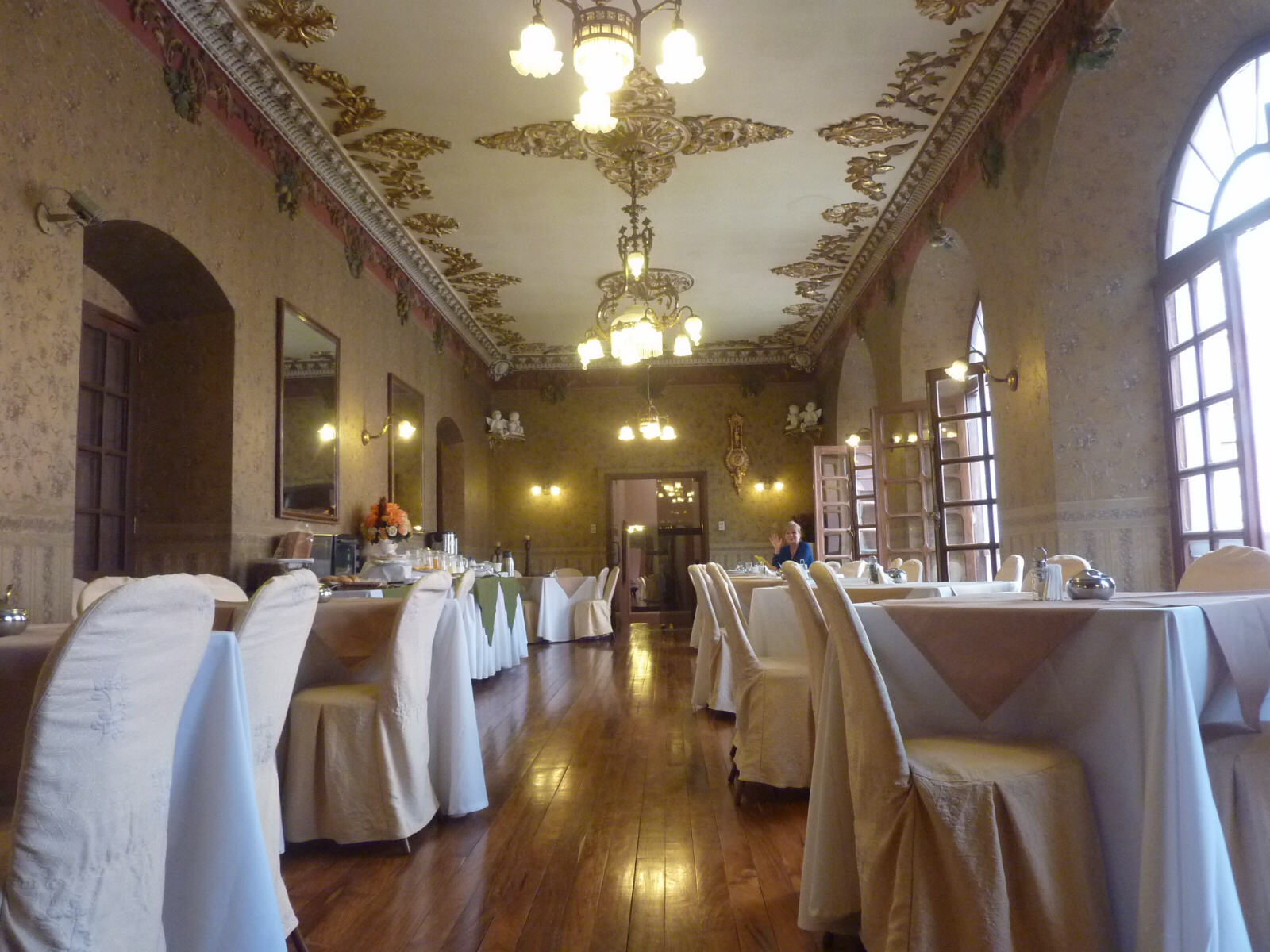
|
In the evening we went back to Joy Ride café and had different dishes – medallions of beef with sauces and salad, and chili con carne with all the trimmings, which was just as delicious as yesterday. The town seemed much quieter tonight, nothing like the festive Friday we had yesterday. |
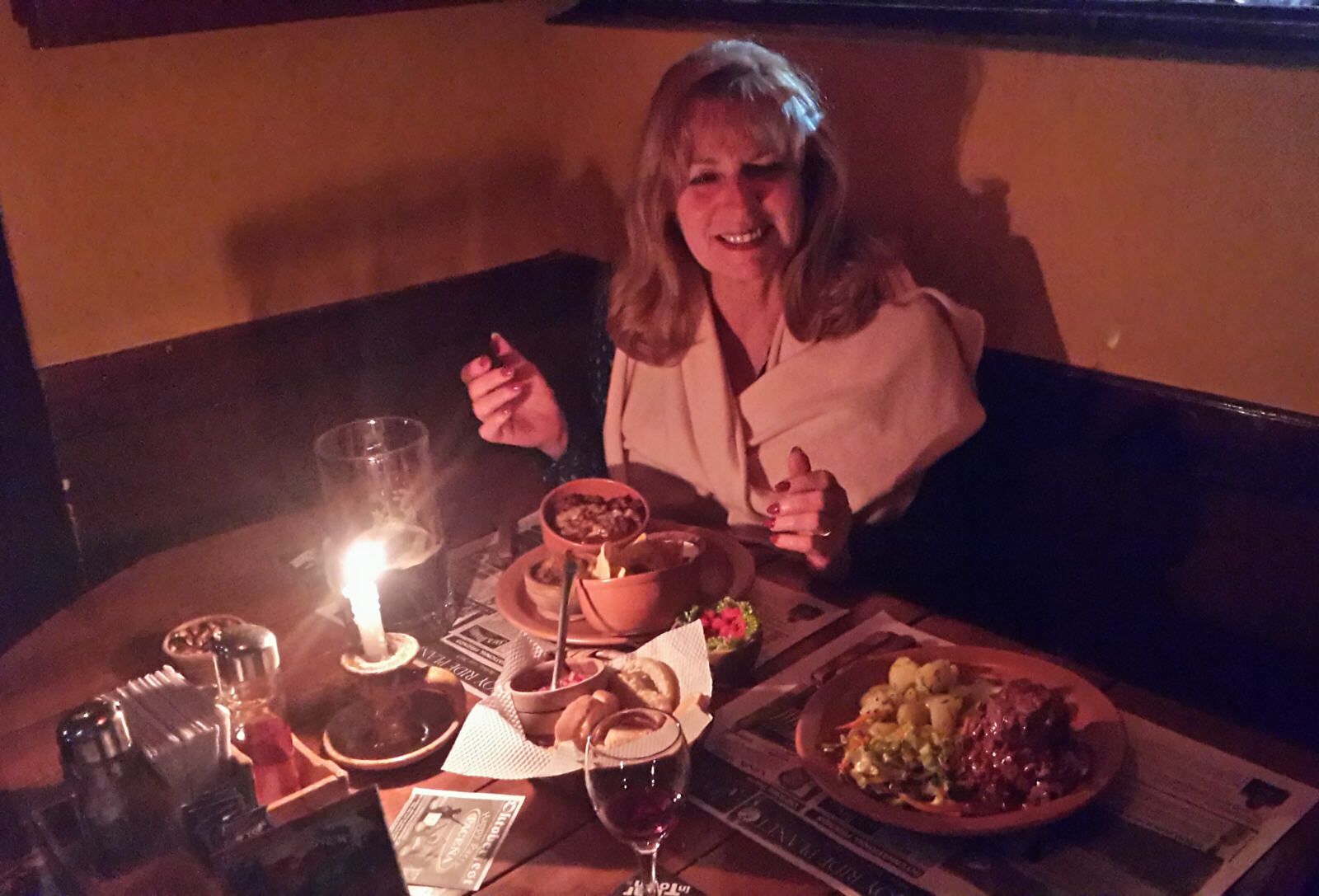
|
Sun 18th. After another nice breakfast and a lazy morning we checked out of the Capital Plaza (480 Bolivianos, £48) and walked across the square to the Grand Hotel (180 Bolivianos, £18), in a characterful old building where we got a pretty, colourful room opening onto the beautiful garden. We walked over to the central market where we had a chorizo sausage and salad sandwich for lunch (never eat the salad or ice cream they say, but we don´t listen!) and bought a big bunch of fragrant sweetpeas to put in the room. We walked all the way up the hill to the Recoleta district and had a bowl of soup in Mirador Café with a fabulous view of the rooftops and churches of Sucre and the surrounding mountains. |
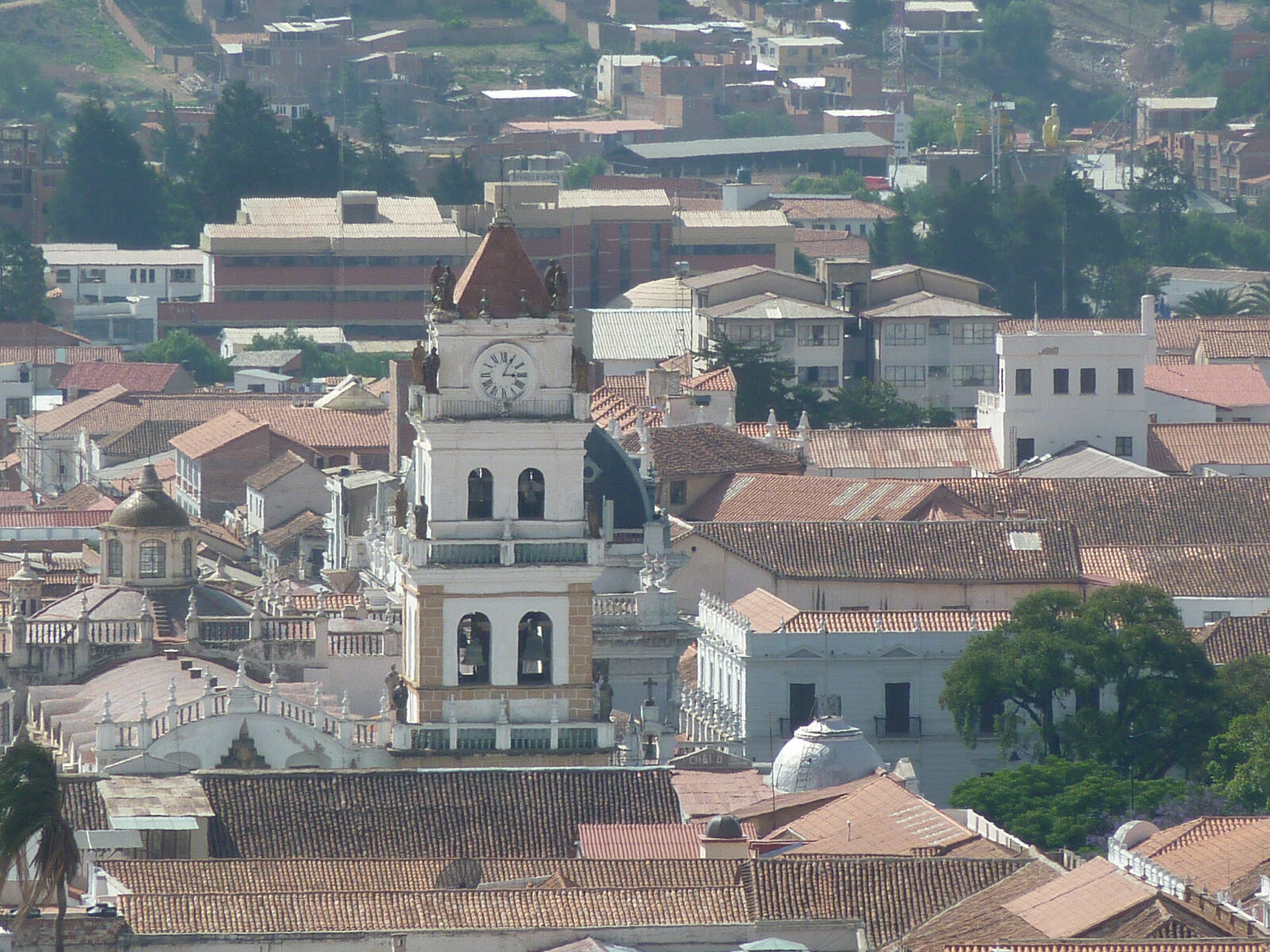
|
On the way back we stopped at Condor Café to exchange two books for one in their book exchange. While Sheila rested after these exertions I walked down through some picturesque parks to the old train station which was all boarded up with an old steam loco quietly rusting in the grounds. The streets outside the station had been cordoned off and a go-kart race was in full swing. On the way back I stopped for a cup of tea in Cosmo Café. We went back yet again to Joy Ride café for black beers and a big plate of pique macho, piled with beef, frankfurter sausages, slices of boiled egg and chips, with fiery hot peppers which sort out whether you are macho or not (and we're not).
Mon 19th. We got a taxi to the bus station and booked our ´full sleeper´ seats for the overnight bus to La Paz tomorrow – it sounded like a comfortable bus, we shall see! We got a taxi back (which came a much quicker way although the price was the same) and went to Abis café on the square for a tasty, filling brunch of bacon omelette and steak sandwich with fried onions and peppers. We went to look in the cathedral by the main square but it was closed, so we had a quiet day and after collecting the laundry we put in on Saturday (a huge carrier bag full, washed and ironed for less than £5) we were drawn inexorably back to Joy Ride café and had their best meal of all, filet mignon wrapped in bacon with roquefort sauce and a salad of leeks, peppers, sweet corn and palm hearts. On our way back to the hotel we sat on a bench in the square to watch the break dancers who were very entertaining.
Tues 20th. We went out for a nice fried eggs breakfast at Abis café, watching the protestors in the main square with banners and a marching band, but it still wasn´t clear what they were protesting about. We had to check out at midday so we left our cases and spent some time struggling with the internet (why are all these keyboards sticky, do people dip them in jam?) Then we went for a coffee at the friendly Condor Café just up the road. We posted a letter at the P.O. (for £3!), had a look round the market with colourful vegetable stalls and meat stalls, one with cows´ noses (nothing else, just the noses – there Heston Blumenthal, make something with that!) .... |
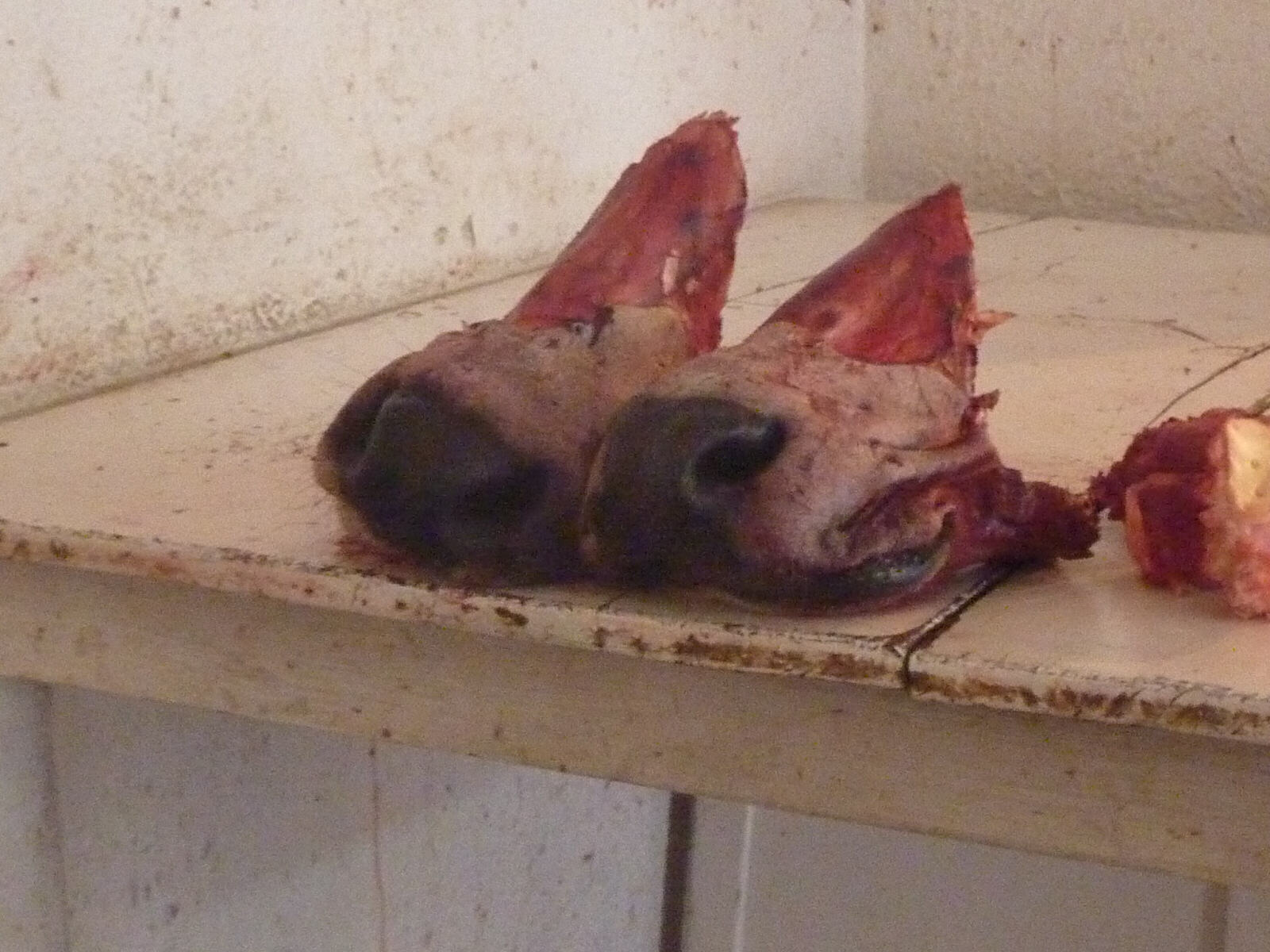
|
.... then came back to Abis café for an early dinner of steak sandwich and a big salad, and sat in a window seat watching a violent thunderstorm shake and drench the trees in the square and anyone who ventured by.
|
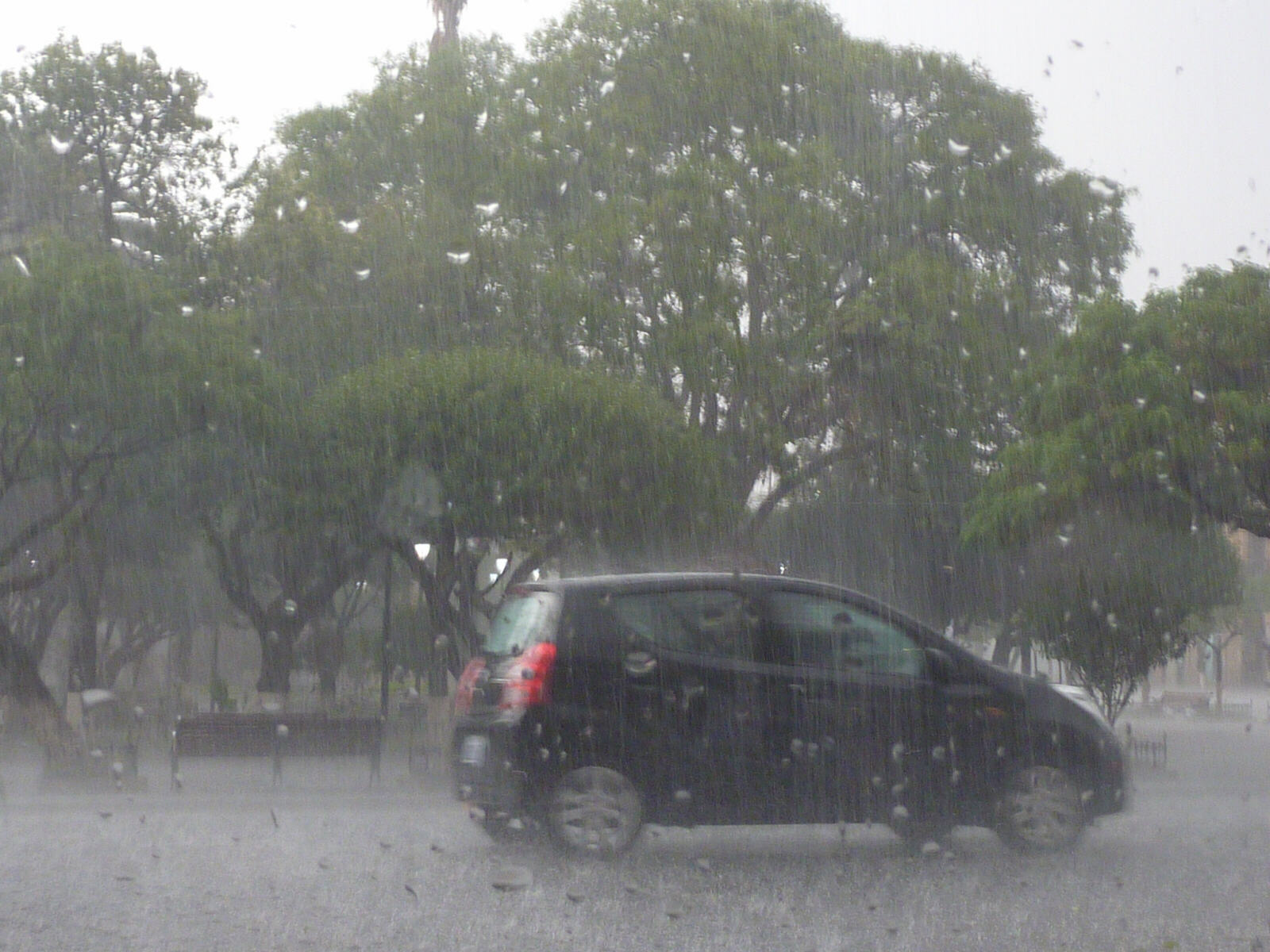
|
We got a taxi to the bus terminal and got snarled up in traffic so we were in a rush when we got there but our bus was not even at the stand so we had to stand around and wait. Our bus was ´full cama´ meaning seats that recline nearly to horizontal and they were very wide and comfortable and a blanket was provided for when it got cold later in the night (140 Bolivianos, £14 each). With no fuss or fanfare the bus set off – they didn´t even check our tickets – the lights went off, there was no film or loud music and everyone went to sleep – bliss (and so unusual). |
La Paz, Bolivia
|
Weds 21st. Again the roads seem much improved and it was a smooth ride with only one 15-minute stop, none of the turning off to go to the bus station in every little town we passed like in Argentina. The sun came up and we arrived in La Paz 11 hours after we set off, pretty much on time. We had pre-booked a hotel and showed the address and map to a taxi driver but he hadn´t a clue where it was so he passed us to another driver who set off confidently – meaning at extremely high speed and with no allowance for pedestrians or other cars – the driving here is much more crazy than anywhere else so far. This driver also didn´t have a clue and couldn´t read a map, so took us way out of the way to a BandB where the lady spoke good English. She phoned our hotel who gave him directions, but when we arrived at the hotel of course the driver demanded extra money because he got lost, we refused and in the end the hotel receptionist very kindly paid the difference. The hotel, Boutique el Consulado, was lovely and because we were early we elected to have one of our free breakfasts now, sitting in the conservatory surrounded by the nice garden, a little haven surrounded by skyscrapers. The Consulado was in an historic old house and we had booked the Presidential suite, a large room with a high ceiling, big furniture with lots of storage space and a very comfy bed. The friendly hotel staff recommended a couple of nearby restaurants so we went for lunch to the up-market Vienna restaurant where we had a goulash soup and a plate of German sausages, all very tasty. We were tired after the bus ride so we enjoyed our spacious room until we went up the road for dinner to La Tranquera, with a very friendly maître d´ from Cape Verde, and we had extremely tasty llama steak and llama kebab on sizzling platters (we had to wear bibs to avoid being splashed and burned by hot sizzle) with soup and salads from the salad bar. This was accompanied by Bolivian black beer and red wine of course. |
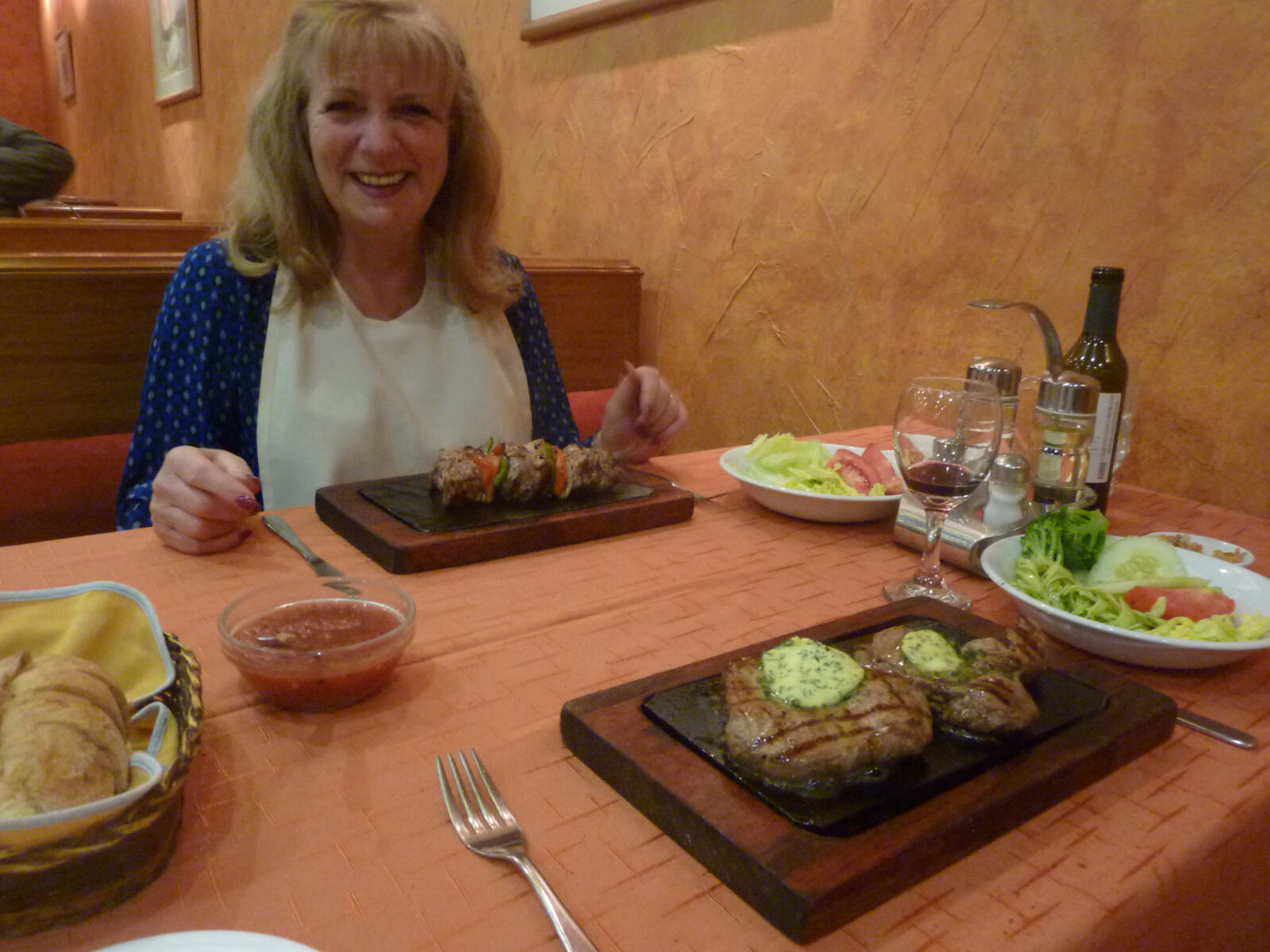
|
Thurs 22nd. Over breakfast we had a very interesting chat with a businessman from Ecuador who gave us lots of good tips about the places we plan to go to, including to get past Latacunga in Ecuador as quickly as possible because a nearby volcano was erupting! Then we went on a walking tour of central La Paz, along the main central avenue, up to Plaza Marillo, the city centre square, into the cathedral, along the pedestrianised Commercio street and past San Francisco church towards the ‘witches’ market’. We usually avoid English and Irish pubs on holiday but Sheila had just washed her hair and at this point it started to rain, so we dashed inside the nearby English Pub and sat chatting with the English bartender, English owner and Scottish and Swiss guests over a cup of English breakfast tea and two huge tasty home-made soups. We decided to come back the witches’ market (and probably the pub) tomorrow, and went back to enjoy luxuriating in our big hotel room for the rest of the afternoon. We went back to the witches’ market area and booked two separate hotels and nearly a third one for tomorrow night (Sheila likes to have lots of options). Then we looked in St Francisco church which was now open (it had been closed this afternoon) and Sheila lit some candles as she always does. |
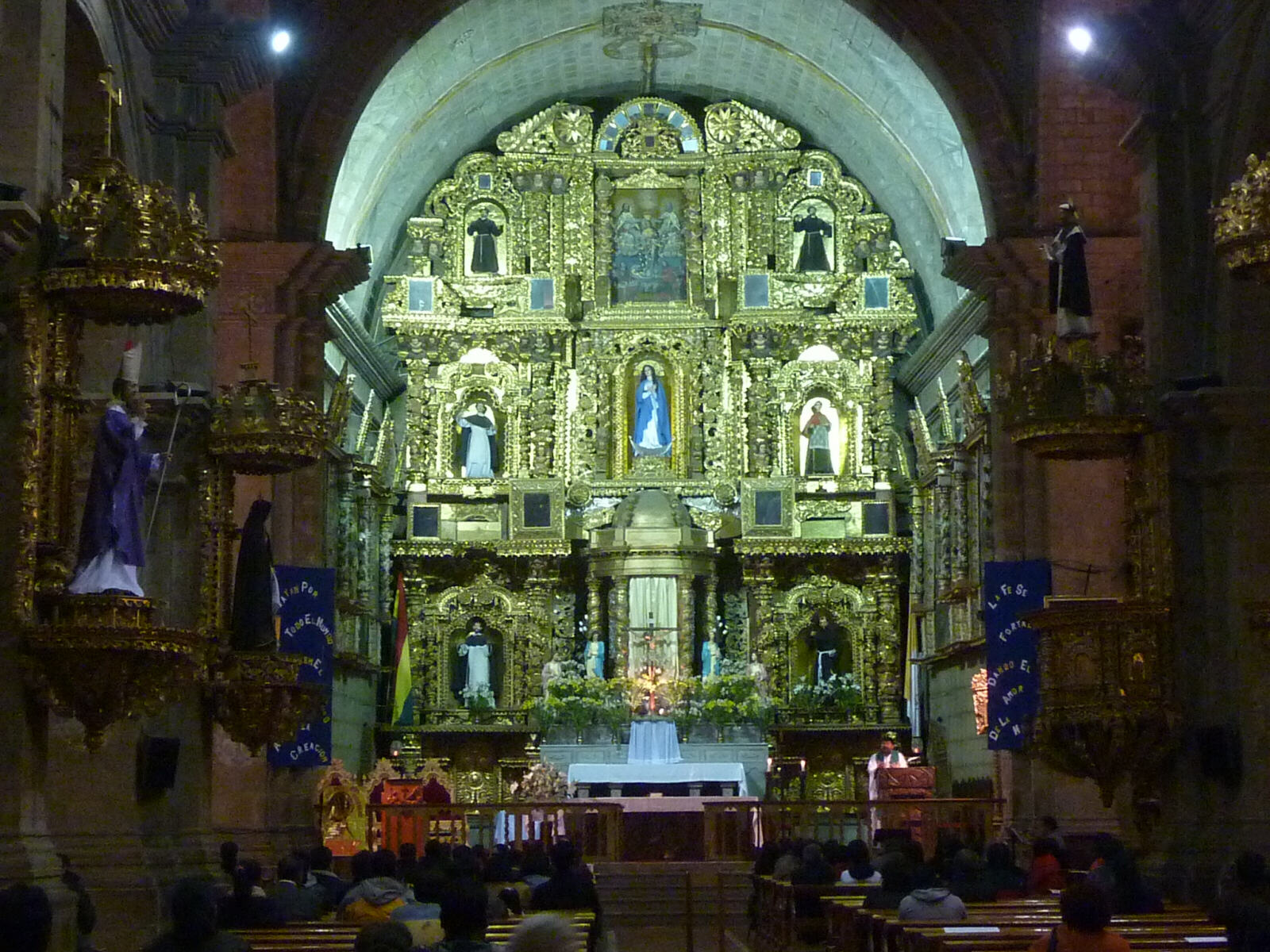
|
The hillsides above the centre of La Paz are covered in the poorer barrios and shanty towns. |
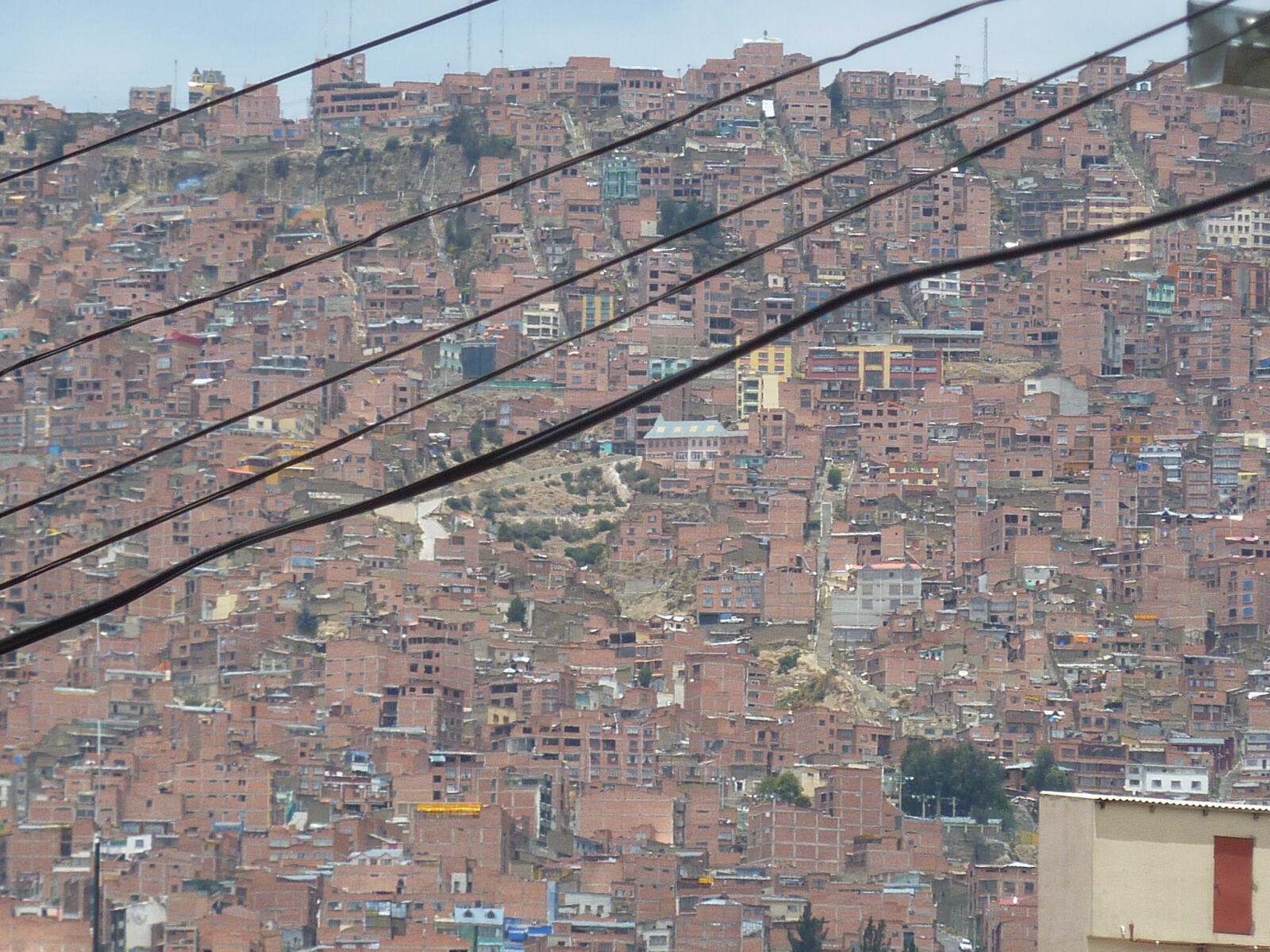
|
Then we walked all the way down the main avenue of the city to the statue of Simon Bolivar and went back to the same restaurant as last night for another delicious llama steak, this one in a leek and cream sauce.
Fri 23rd. Reluctantly we checked out of the Consulado (because it was fully booked tonight) and checked into the Hotel Sagarnaga in an interesting area full of restaurants, hotels and souvenir shops. We went back to the English Pub for a lunch of tasty tomato soup and huge chicken, bacon and guacamole baguette. We had a look at the witches’ market but it was very touristy so we walked all the way down to Simon Bolivar’s statue for a dulce de leche ice cream and walked back to the hotel for a rest. In the evening we returned to the English Pub for very traditional English food – shepherd´s pie and a chicken curry – followed by Cadbury’s fruit and nut in the hotel; sometimes you have to have comfort food!
Sat 24th. We spent most of the day wandering round the shops, some of which were already closed for the weekend, and admiring the wall art. |
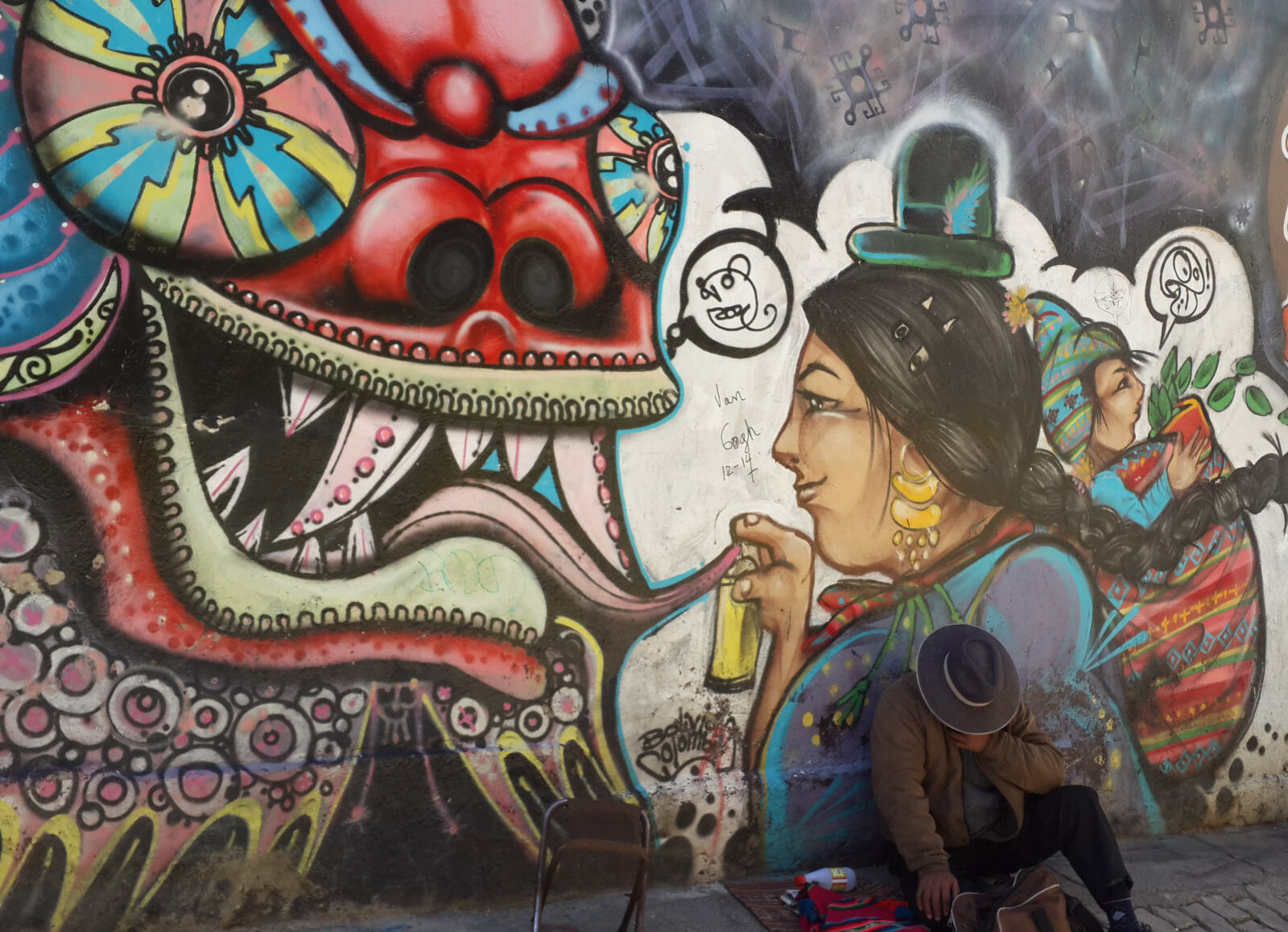
|
We went and explored the colourful Rodriguez market sprawling along a group of streets, with interesting ladies in bowler hats and colourful dresses selling flowers, fruit and veg, meat, fish and all sorts of other stuff. |
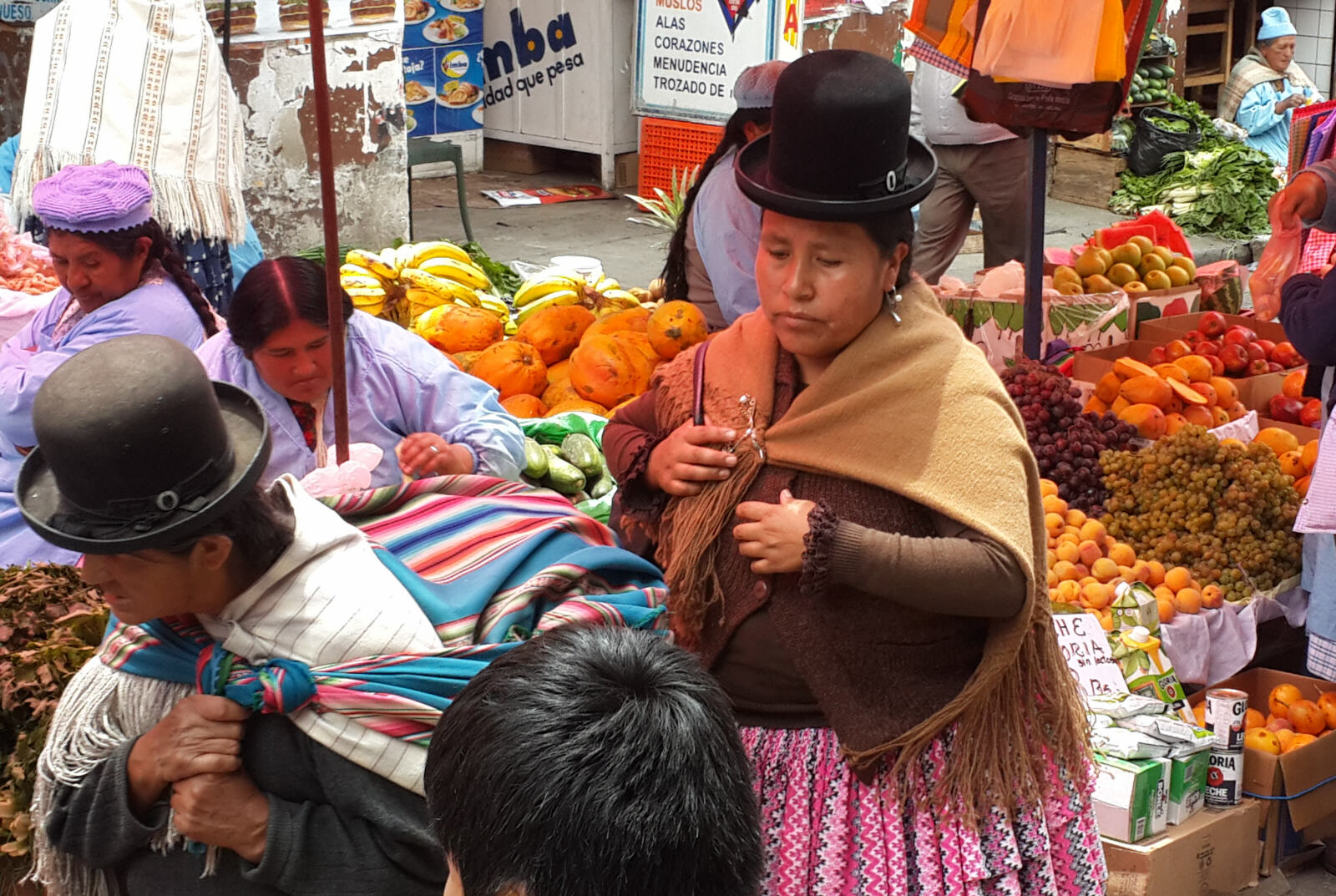
|
For lunch we had Swedish meat and potato hash with fried eggs on top, then went and did yet more shopping. After a brief rest we went back to the English Pub for filling big bowls of leek and potato soup with garlic bread. |
Copacabana, Bolivia
and Puno, Peru
|
Sun 25th. We were up early for the 7:30 tourist bus to Copacabana on Lake Titicaca and it was indeed full of tourists, all swapping stories of places they´d been. We stopped for a short ferry ride then arrived at Copacabana about midday. We had intended to stay for a day but a quick look round revealed that it´s just a small seaside resort a bit like Blackpool but with a couple of llamas instead of donkeys (unlike its namesake in Rio de Janeiro). |
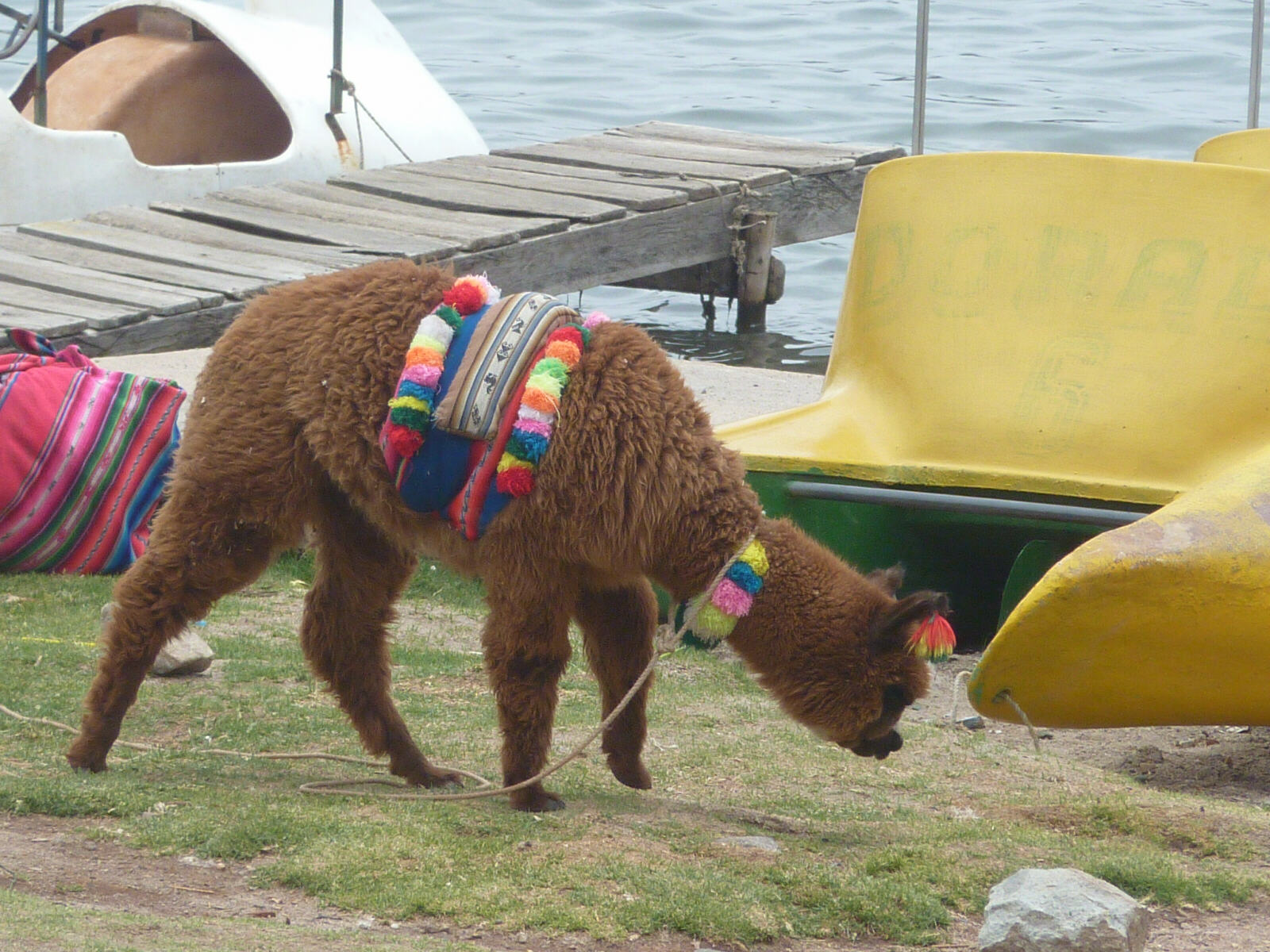
|
So we hastily bought tickets on the same bus which was continuing to Puno in a short while, ate a takeaway hamburger sitting in the bus company´s office and carried on. It was only a short ride to the Bolivia – Peru border where several coaches had arrived at the same time so there was a long queue to the immigration office but once we reached the front the formalities were quick and simple. We arrived in Puno bus station around 4 pm and a very helpful lady called Victoria in one of the tour offices rang around to try to find out if the ship Yavari, built in England in 1862 and brought up to lake Titicaca in pieces, which used to be a hotel moored in the harbor and visited by Michael Palin, was still there. Unfortunately it was ´closed for renovation´ or similar so she took us to the Posada de los Reyes which was cheap, cheerful and quite central. We walked down to the main shopping/restaurant road and had more delicious alpaca (llama) steaks sitting with our backs to the pizza oven to keep nice and warm – the llama steaks may not be so plentiful when we get to the lowlands so we´ve got to have them while we can.
Mon 26th. We had a nice breakfast in what was obviously the couple who owned/ran the hotel´s dining room and living room. It was cold outside as we started to stroll up and down the main (only) street in Puno but it soon warmed up. We had lunch in one of the many cafés along the street and then went to the bus terminal for our bus to Lima via Arequipa. The Cruz del Sur bus line was more like an airline; we checked our luggage in at the check-in desk then went and queued up for the ticket and passport check before getting on the bus. There was a pillow and blanket on each seat and a tray that slotted into the seat arms for when meals were served (when we booked we had four options – meat, chicken, vegetarian and children's). Our allocated seats were huge and comfortable like first-class on a ‘plane, there was a TV screen in each seat back and when we got going the cabin attendant brought round headphones. There were two indicators at the front of the cabin, one showing the time and temperature, the other our speed in km/h but unfortunately it stuck at zero all the time. It was fully air-conditioned of course and the windows didn´t open to let the dust in, thank goodness. We had to change buses in Arequipa and again it was airline style, we went through a transit lounge and we were assured that our luggage would be transferred to the next bus. We shall see! |
Lima, Peru
|
Tues 27th. The attendant brought breakfast round (ham roll and tea) which we had on our first-class-style tray tables, then later she handed out bingo cards and called out the numbers over the intercom until a man near us won, but we didn´t see what prize he got. Sheila is still using our bingo card as a bookmark. We arrived in Cruz del Sur´s big modern terminal in Lima and got a taxi to Antigua Miraflores, our favourite hotel from last time we were here, in a nice old colonial-style house with comfy chairs and wooden furniture ($106 a night).
|
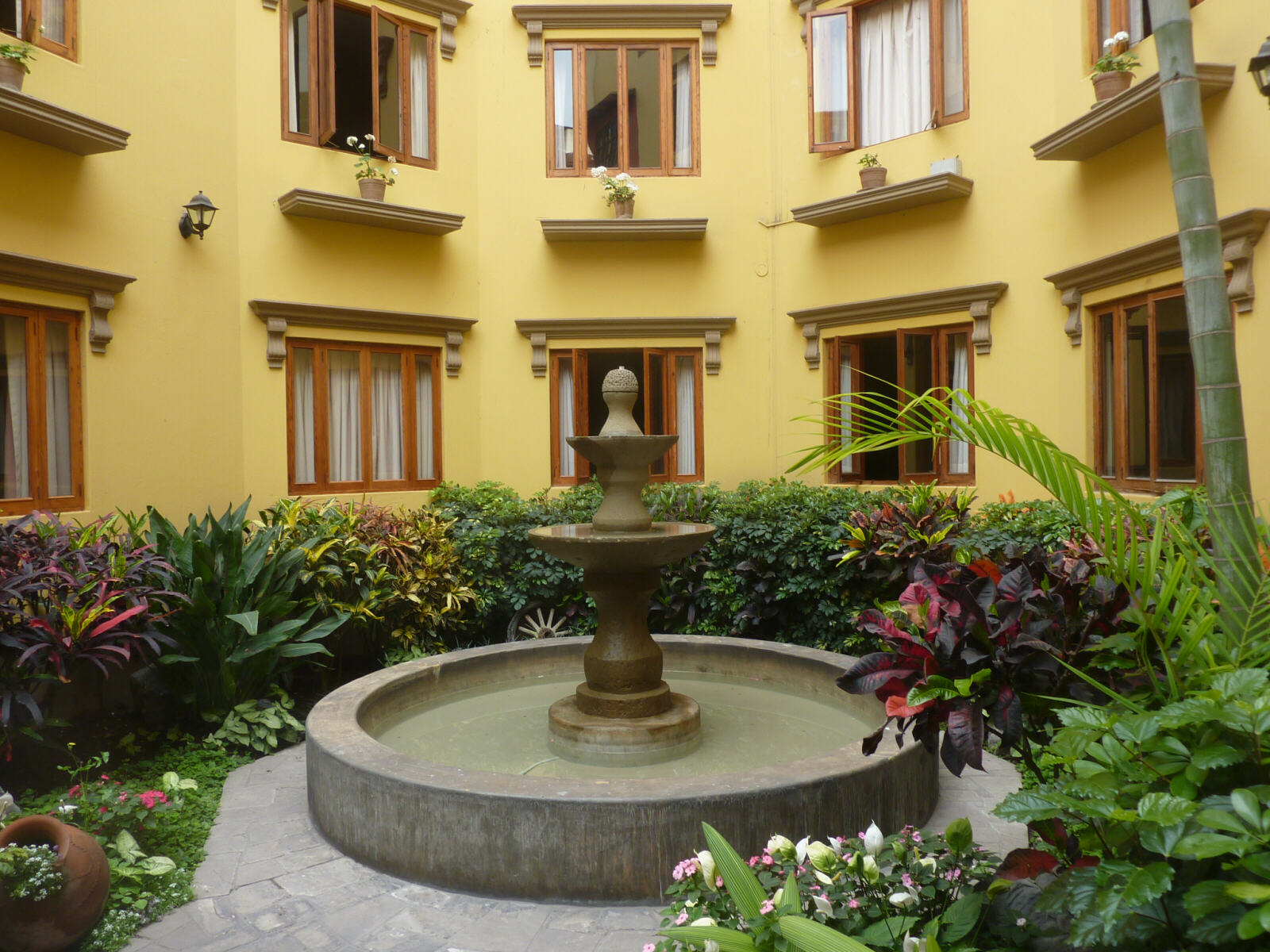
|
We walked around Miraflores district looking at shops and restaurants then got a taxi to Rosa Nautica, a posh restaurant in a series of wooden octagonal rooms built on a pier over the Pacific ocean. It´s the sort of restaurant where the ladies´ menu doesn´t have the prices, but Sheila still managed to pick the most expensive item (how does she do it?). We had an absolutely delicious meal as the surf swished below – salmon carpaccio and tuna tartare to start and seabass with a creamy leek sauce and the special of the day, roast suckling pig, and lovely wine – wonderful!
Weds 28th. After an excellent breakfast at Antigua Miraflores we looked round the shopping streets and went to the Inca market, which was mostly tourist tat, and the Indian market which was more of the same. We stopped in a fast-food place for a basket of frankfurters and chips for lunch, then relaxed in the hotel for a while. I went down to the Parque del Amor on the clifftops overlooking the sea and the Rosa Nautica restaurant on its pier, and watched the parasailers and the waves coming in to the shore. |
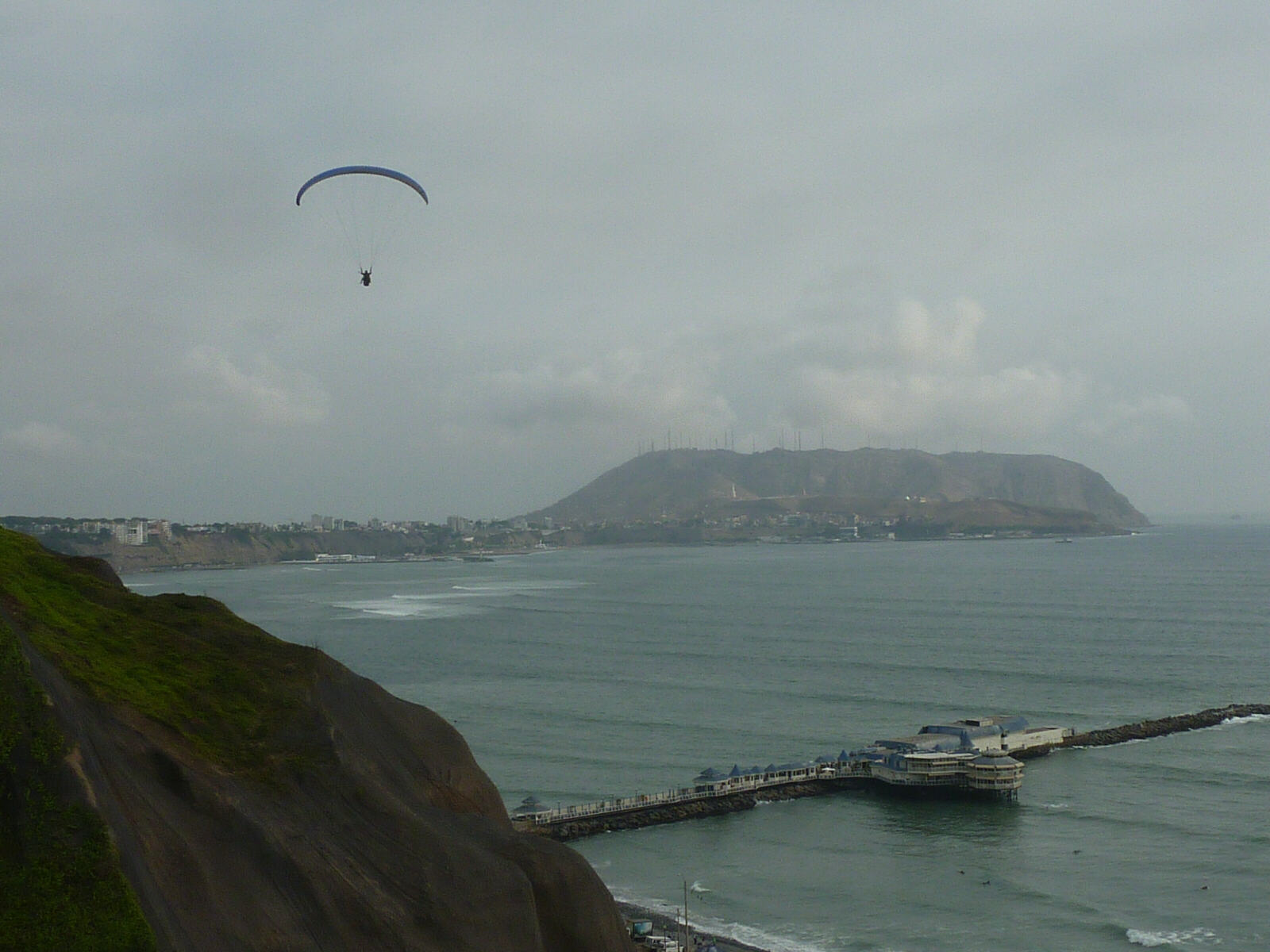
|
In the evening we went to one of the streets of restaurants near Kennedy Park and had garlic bread and tasty stuffed peppers and stuffed avocado. |
Trujillo, Peru
|
Thurs 29th. We spent the day reading and watching films – on a bus, of course! We travelled north to Trujillo for 8 hours and arrived about 11pm when the whole town seemed shut. Even the hotel we´d booked, Las Condes, was locked and deserted although the lights were on. After we had been banging on the door for some time, a nice young man came running up the street to let us in and we had a very clean, modern room with a really good shower.
Fri 30th. Breakfast at Las Condes was very nice, at tables in the small garden outside. Then we spent the day strolling round the pleasant old colonial town. Just as we arrived at the Cathedral to have a look inside, it closed for lunch! |
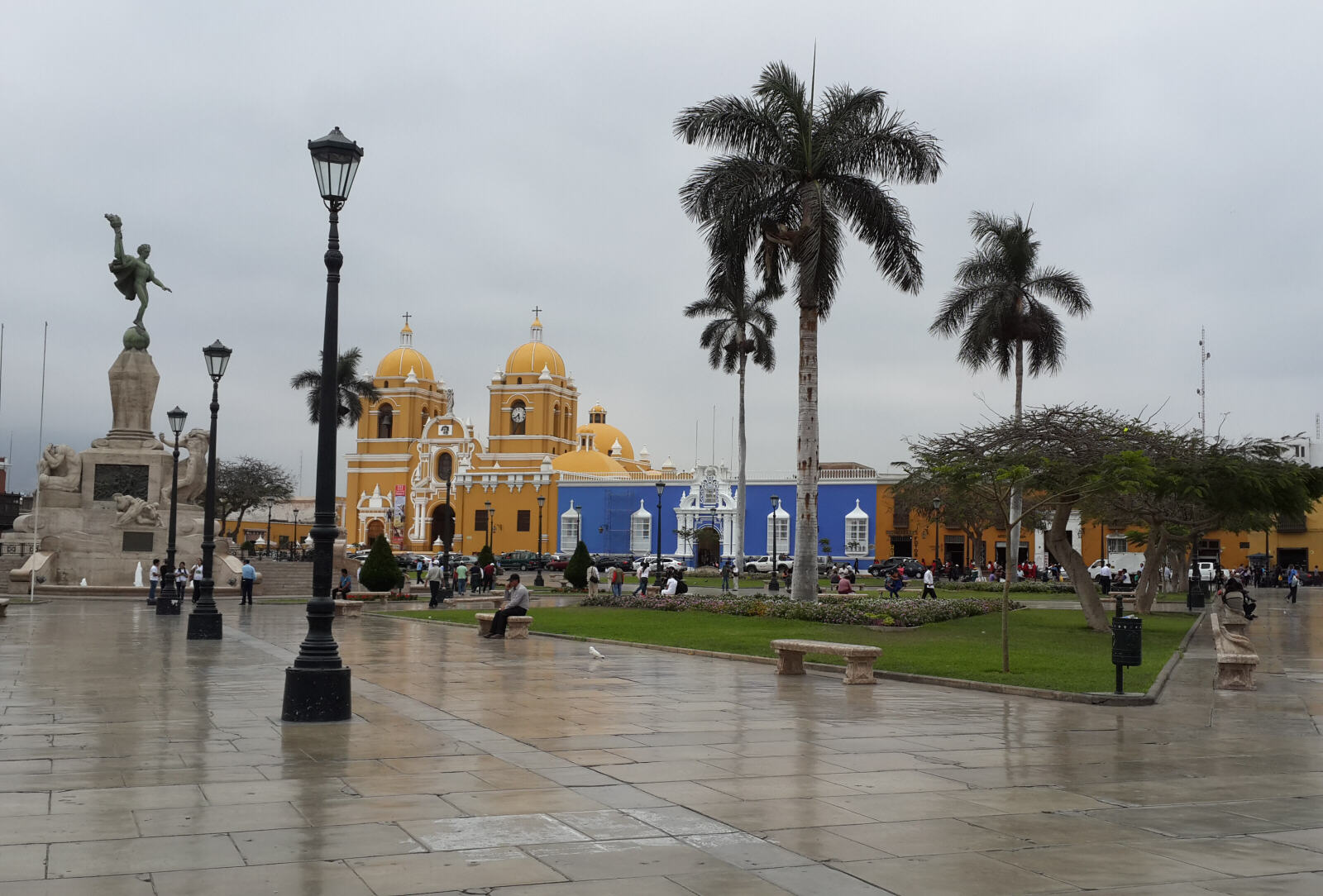
|
We strolled some more then had pizza and sangria in a nice restaurant for lunch. We arranged a very late checkout for half a room rate at the hotel so that we had somewhere to relax until we went to the Cruz del Sur terminal at 11pm. The midnight bus was an hour late arriving from Lima, but once we got going it was a cozy and comfortable 18-hour ride in our big armchairs (cost 458 Soles, £90). |
Peru-Ecuador border
and Guayaquil
|
Sat 31st. At dawn we were still travelling through scrubby desert on the coastal plain as we headed north. Further up the coast changed and for the first time there were boats in little harbours and a couple of villages catering for backpackers and tourists with dusty beach bars and little restaurants. At 3pm we were stamped painlessly out of Peru and into Ecuador, our second new country on this trip. We eventually arrived at Guayaquil bus station about 8pm, several hours late. The bus station was huge, more like an airport terminal, with multiple levels of shops, restaurants and bus booking offices. We decided on the spur of the moment to press on to Cuenca, our actual destination, straight away, on one of the hourly buses. This bus was very much less comfortable than Cruz del Sur, with loud music blaring out all the way, but it was only a 4-hour run.
|
Cuenca, Ecuador
|
When we arrived at Cuenca bus station at 1am we hit a bit of a problem, as all the surly, unhelpful taxi drivers refused to even talk to us until some friendly young people who were also looking for accommodation explained that the big Independence Day celebrations had started and all the hotels in the city were full. We stood around getting cold with several other people caught in the same situation, until one taxi driver took pity on us and took us and a lady who had come on the same bus to Hostel Rio Brabo which did have a couple of rooms and was clean and pleasant but rather overpriced at $50 and a long way from the historic old centre that we’d come to see.
Sun 1st to Tues 3rd Nov. We got a taxi down to the historic centre and started walking about looking for another hotel, and at the third attempt we struck lucky with the Hotel Vieja Mansion, which was indeed in a lovely old mansion with rooms and balconies on two levels around a courtyard. There we met the same lady who came with us last night, and between us we got the last two free rooms in the hotel. Ours was more or less up in the attic, a big room with a large skylight, half of which was clearly the cooking and catering area for the adjacent conference room (Sheila obviously didn’t make use of the kitchen) and the other half was a comfortable bedroom. After a rapid unpack we went for a walk round the nearby main square and into the huge, lovely cathedral which was absolutely packed with people, it being Sunday, all saints day and a festival day all in one. |
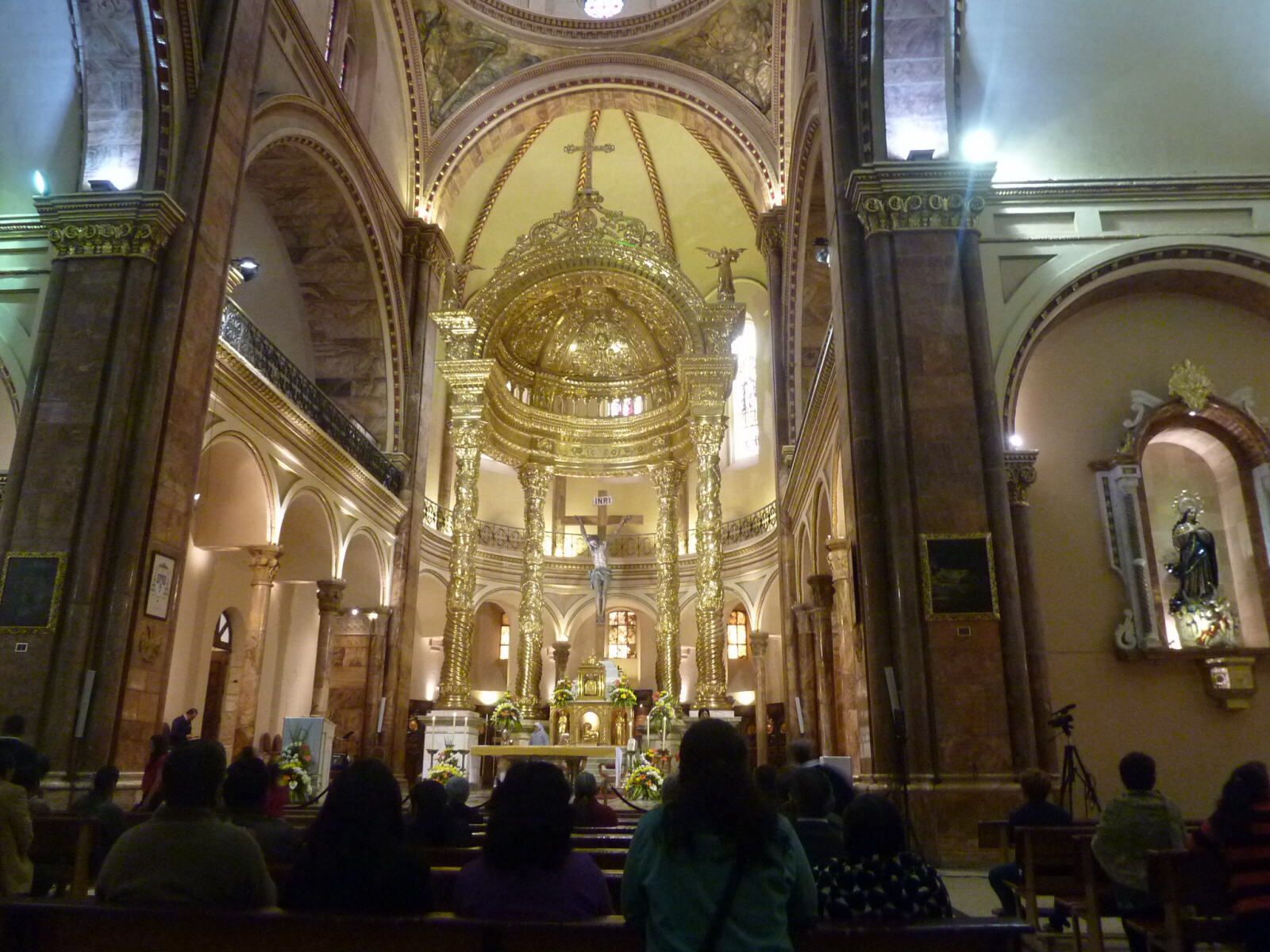
|
We had some much-needed breakfast at a café overlooking the square (we hadn’t eaten since lunch on the bus yesterday) then walked around the streets which were full of markets and stalls selling handicrafts, local produce and flowers where Sheila bought beautiful-smelling lilies for the room, and full of people enjoying the festival atmosphere. |

|
There were several musical entertainers ranging from singers on a big stage set up in one of the squares through various sorts of street musicians to a priest playing an electric harp outside one of the churches. |
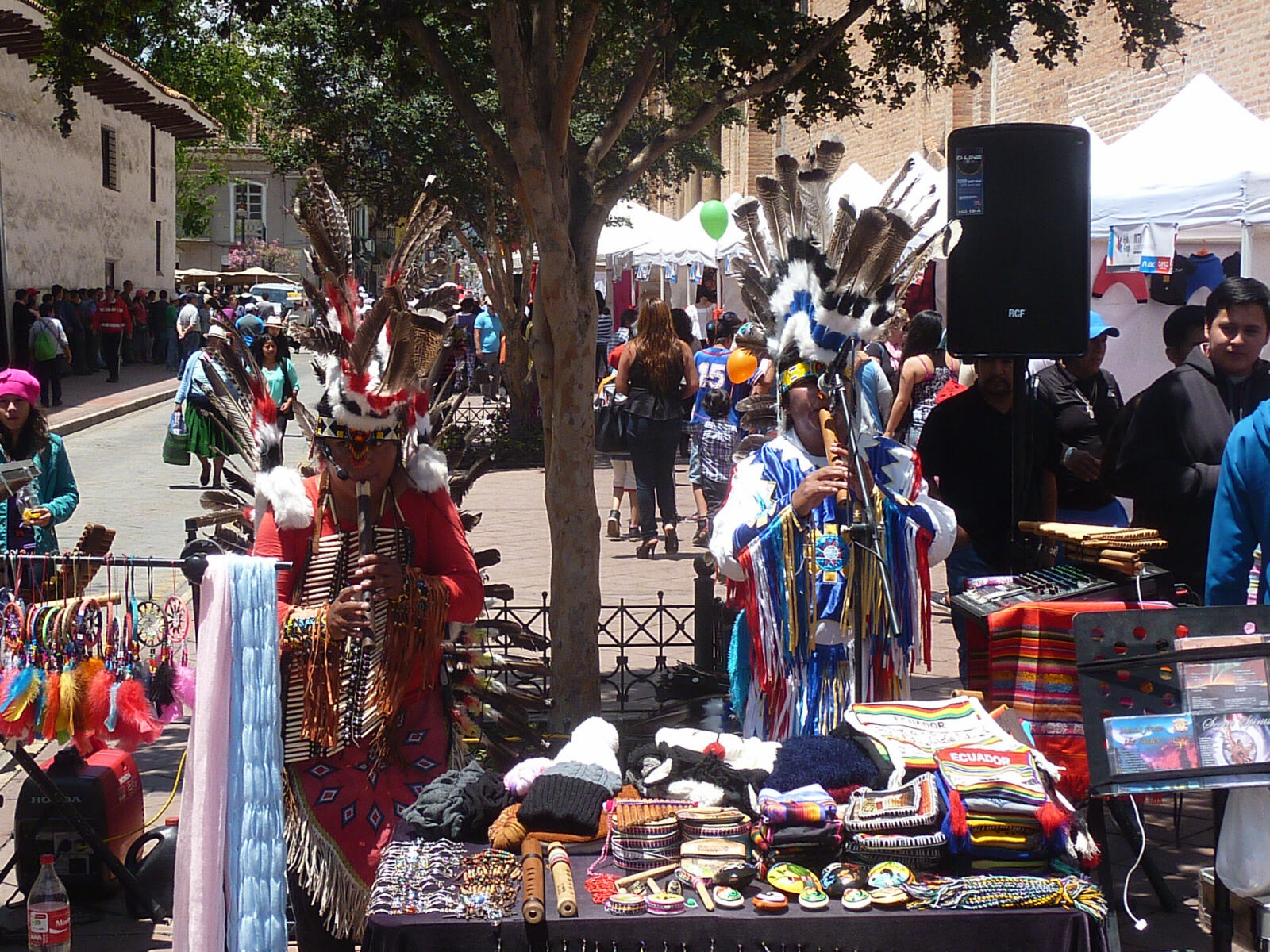
|
There seemed to be quite a few American tourists and quite a few of the local people spoke good American, which made life a bit easier. We formed the impression that in Ecuador, Panama hats are the essential fashion accessory – all the local men were wearing them, but Sheila wouldn’t let me buy one. Apparently Cuenca is the main place in the world where they are made. The weather was beautiful, warm and sunny and the festival in full swing so we walked around the square and nearby streets, then down to the river where the riverside park was full of more artisans’ stalls. After copying our pictures onto a backup DVD at about the only shop in town (which took a lot longer than we expected and cost more than we thought) we ran to the cathedral for our timed tour down to the crypt and up onto the roof .... |
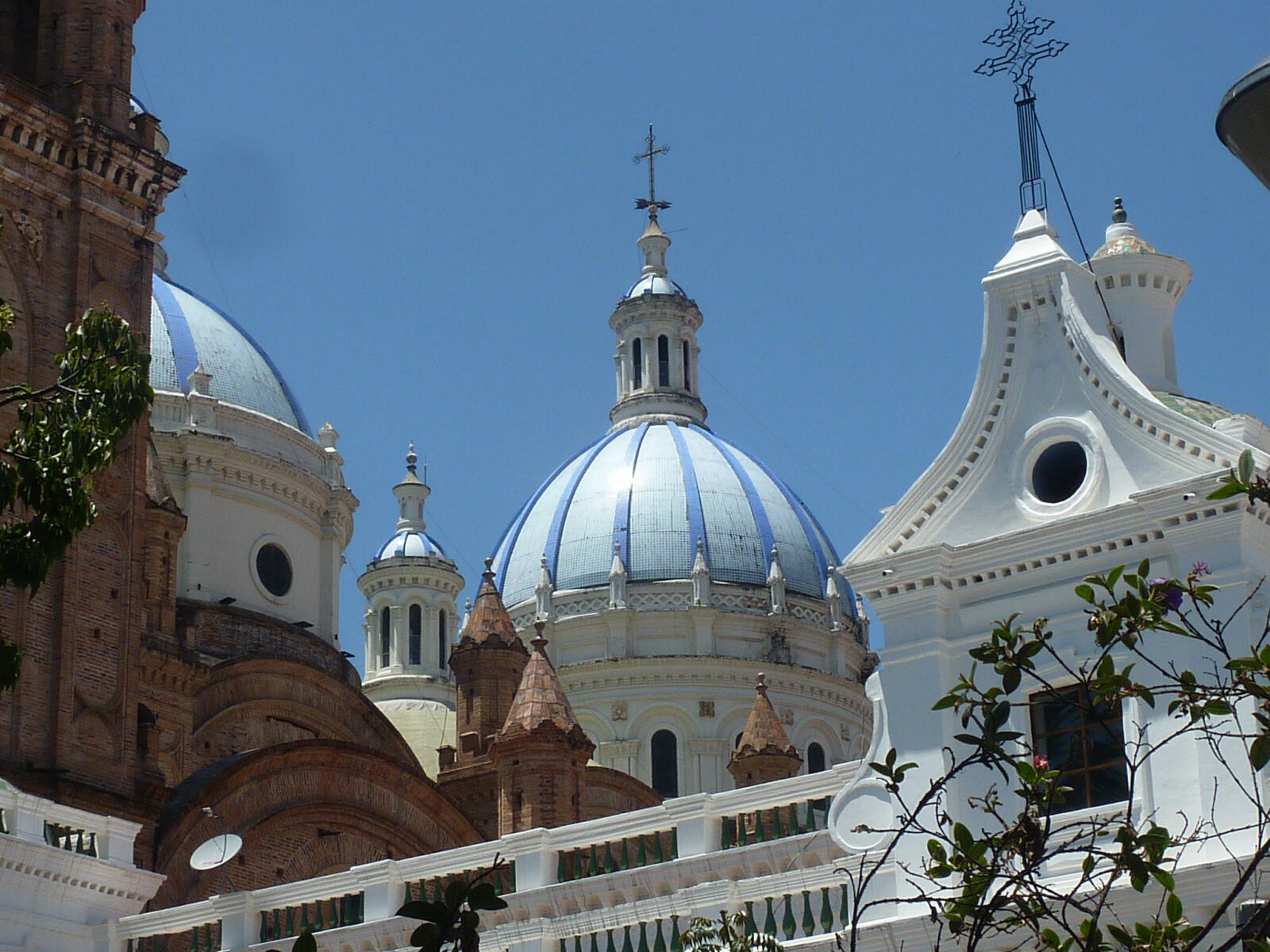
|
.... for a great view of the town.
|
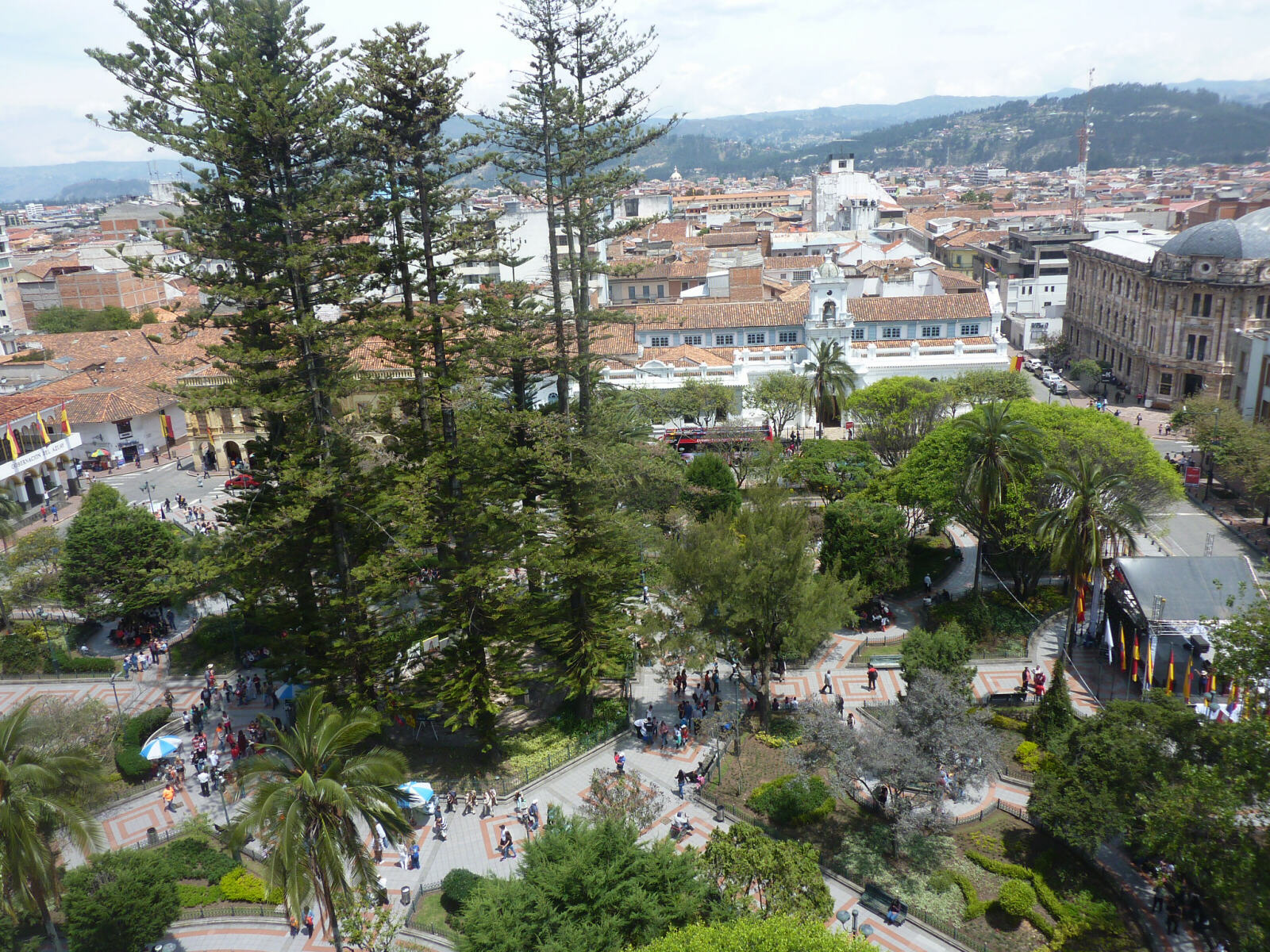
|
Down in the crypt was the mausoleum of all the families who contributed to the construction of the new cathedral in the 1800s, which was largely funded from the profits of Panama-hat making.
One lunchtime we went to the Taj Mahal Indian restaurant just up the street from the river and had tasty veg pakoras with dips and black beer. Another day we had a lasagna and salad for lunch in another of the cafés overlooking the square, then watched the procession which was one of the closing events of the four-day fiesta, but it wasn’t anywhere near as colourful as the Bolivian procession in Buenos Aires. Another time we had some soup and a black beer and returned to the hotel just as a short, sharp shower pattered on our skylight. We got a taxi out to the zoo on a hillside outside town, and had a thoroughly enjoyable two hours there. Zoos can be a bit depressing but this one was laid out along a trail through the forest with a fascinating range of animals in lifelike enclosures that blended in nicely .... |
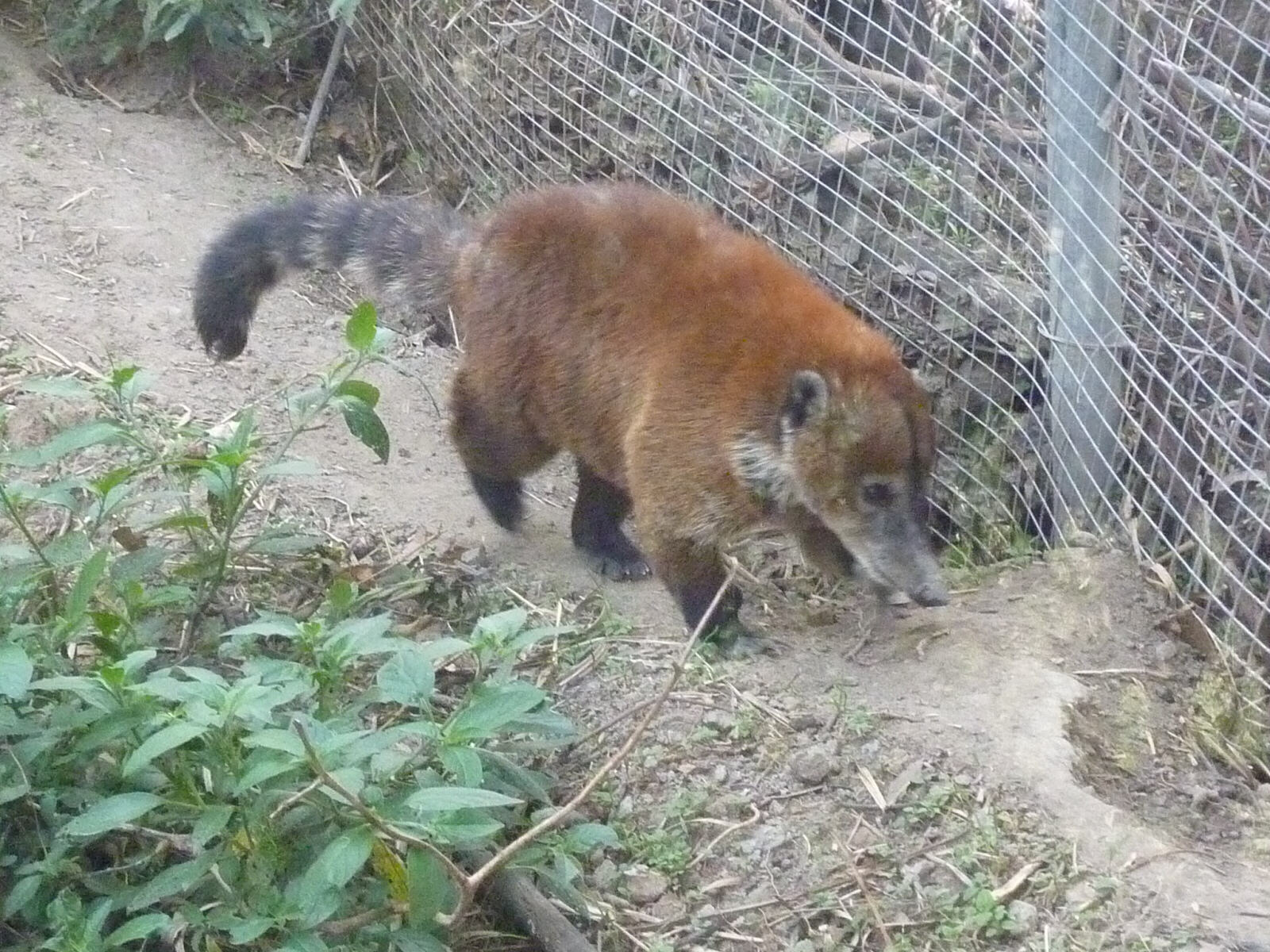
|
.... culminating in a grumpy ostrich and the lion enclosure with two cute lion cubs.
|
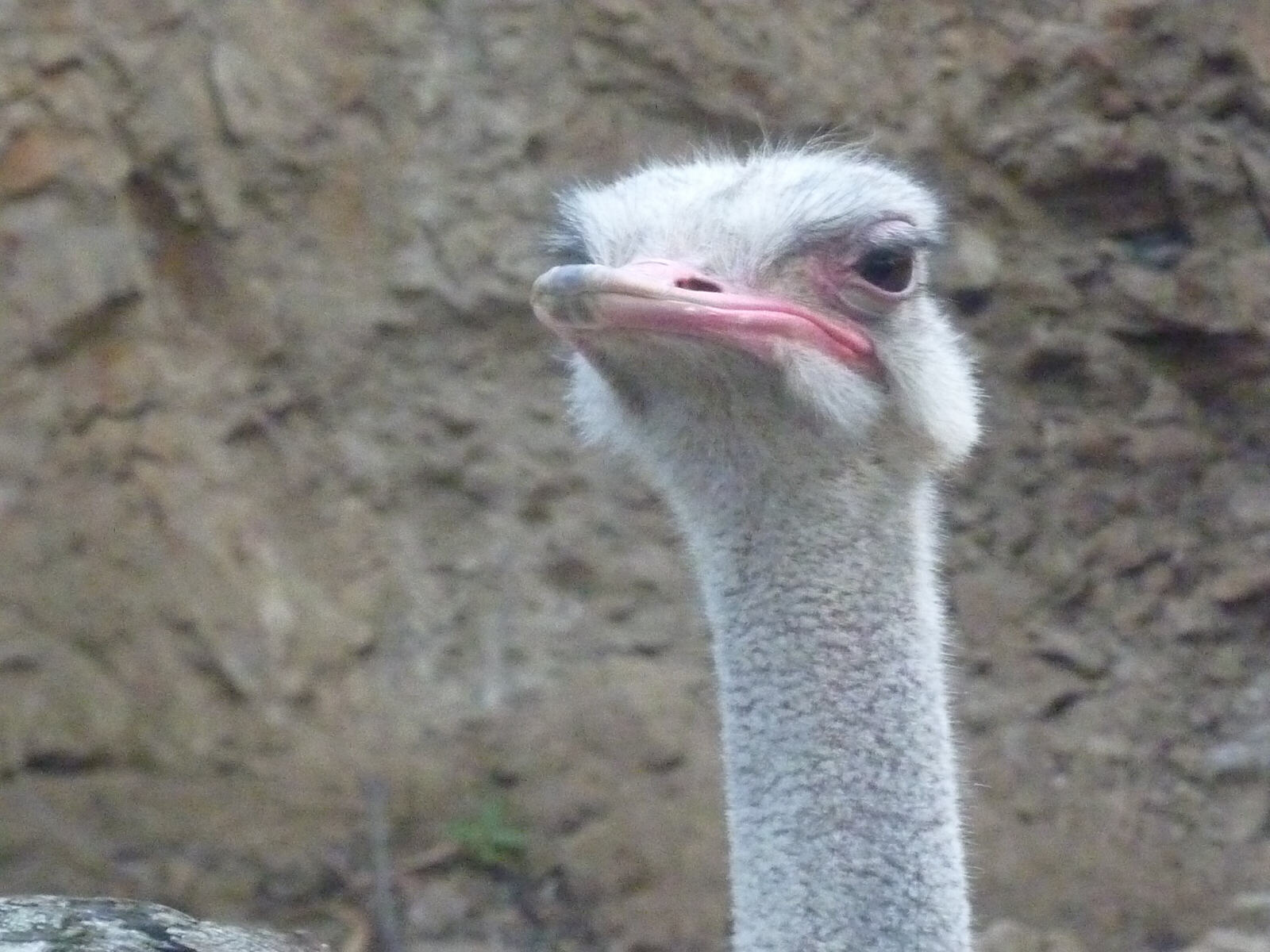
|
In the early evenings we walked round the square again but now it was quite chilly – in Cuenca, four seasons in one day, as a couple of people said to us. We had wonderful if pricey meals at Novocento restaurant in hotel Santa Lucia, another hotel in a characterful old mansion with the dining area in the central courtyard surrounded by plants and wooden balconies. We started with delicious mixed Italian antipasto or ciabatta with smoked salmon, cream cheese and capers, then the most tender and tasty lightly peppered steak with mushroom risotto and a seafood risotto, accompanied by Sauvignon blanc and Merlot. |
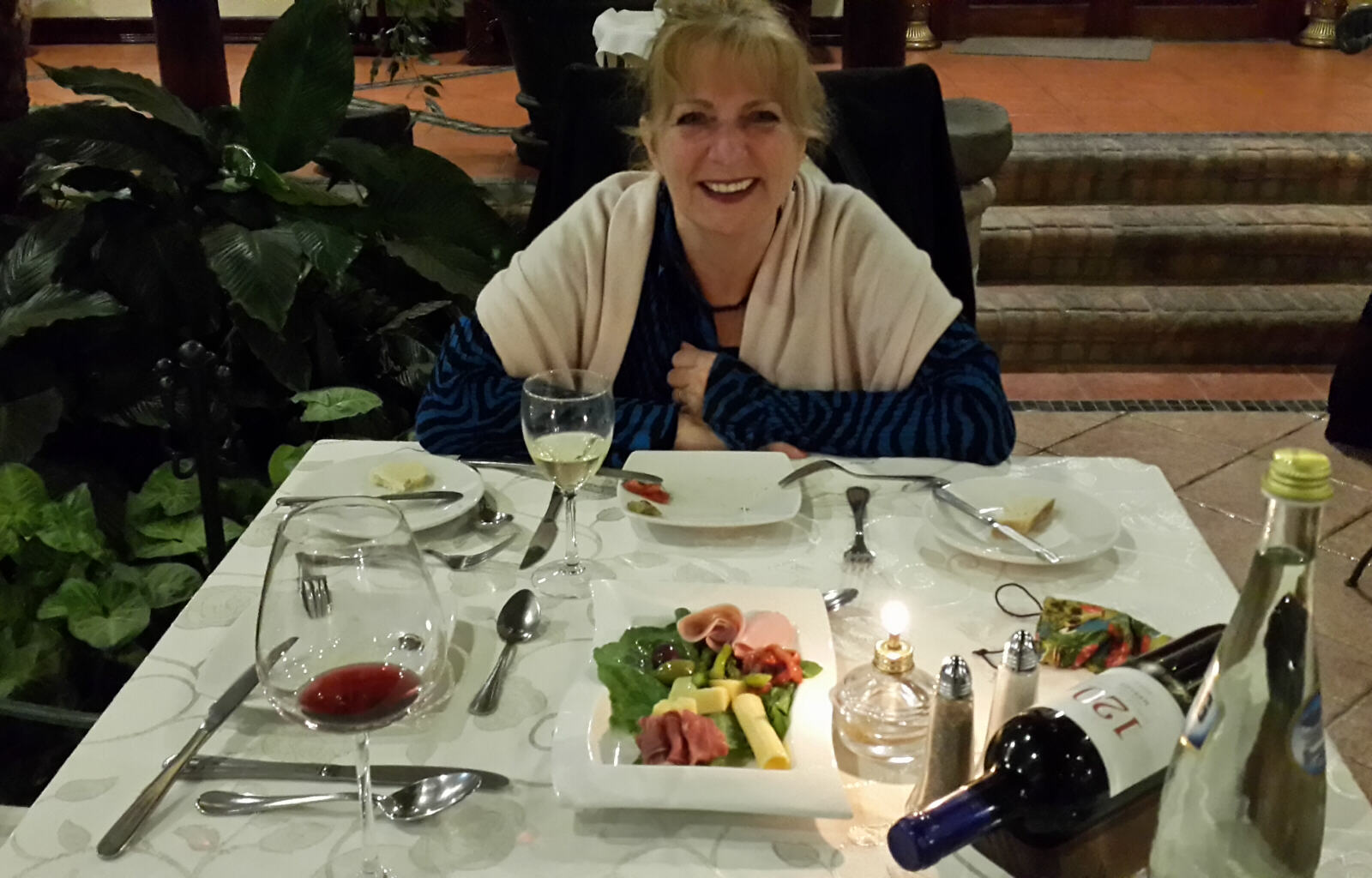
|
Quito, Ecuador
|
Weds 4th. The Express Sucre bus left on time and arrived nine hours later on time at Quito’s big modern bus station ($12 each). The nice man at the hotel said that they were the best bus line with the most modern buses and it was comfortable enough, but not as luxurious as Cruz del Sur first class, and we were besieged by vendors and motor-mouth salesmen at each stop. Along the way we saw the red-hot lava on the hillside of the volcano that the man in La Paz had warned us about. We had booked the Huasi Continental hotel in the middle of Quito’s historic old town but that was a mistake because the old town shuts up completely in the evening and there were no cafés or restaurants open at all. Unlike the other historic towns we’ve visited, where life revolves around the central plaza, Quito historic town (a Unesco world heritage site) shuts up like a museum and at night it is dead and dangerous. The hotel was a bit grubby and not nearly as nice as advertised.
Thurs 5th – Fri 6th. We moved from the old town to Mariscal, the ‘travellers’ district’ in the new town and straight away everything seemed better. By luck we found the Yellow House, a friendly hotel in a nice old house near Plaza Foch in the center of the restaurants, hotels and bars district. We went across the road to Magic Bean café for a tasty, substantial breakfast, then put some laundry in to the nearby Lavanderia and went to a travel agent and bus office to find out about buses to Colombia. Pleased with this we went to one of the restaurants on Plaza Foch for a steak sandwich and rather watery ‘artisan’ black beer for lunch. While Sheila had a snooze I swapped travel information with an Irish couple staying in the hotel, went for a walking tour of the new town down to El Ejido park and back and had a couple of cups of coffee in a couple of cafés.
The next day we went on the walking tour of Quito old town. We got the trolleybus from Santa Clara, a few blocks from our hotel, down to Plaza Grande in the centre of the old town, for 25 cents each (a taxi would be about $5). We walked through squares and along streets lined with wall art and interesting old houses, and looked in churches although the main churches all charge an entrance fee of $3 or $4 each. |
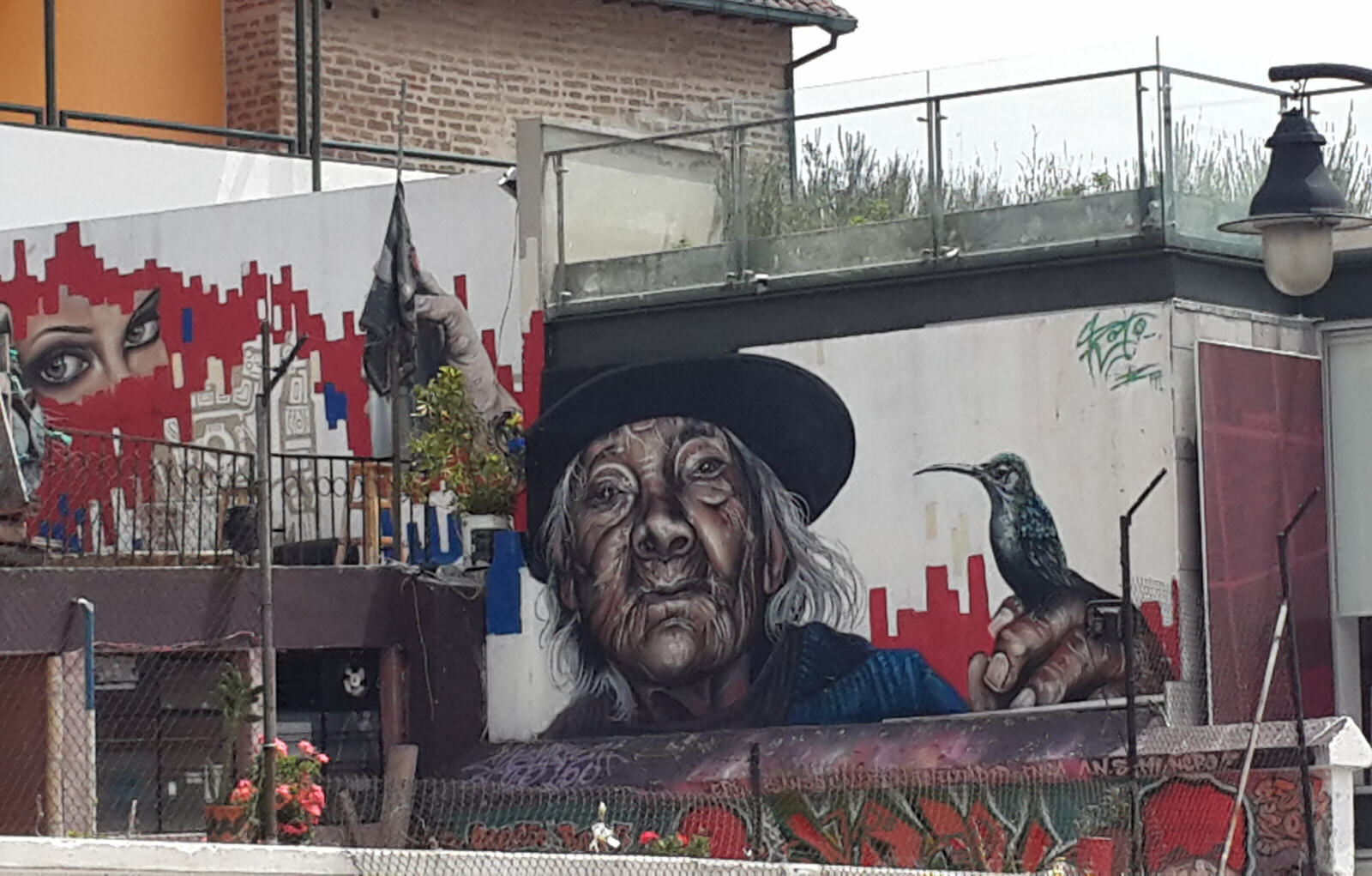
|
We went down Calle de la Ronda, a historic street with some of the best-preserved colonial, balconied houses, and stopped in a chocolate shop/factory to watch the presentation about how Ecuador’s cocoa is the most pure and makes the best chocolate in the world. We tried a few samples and it certainly was good. |
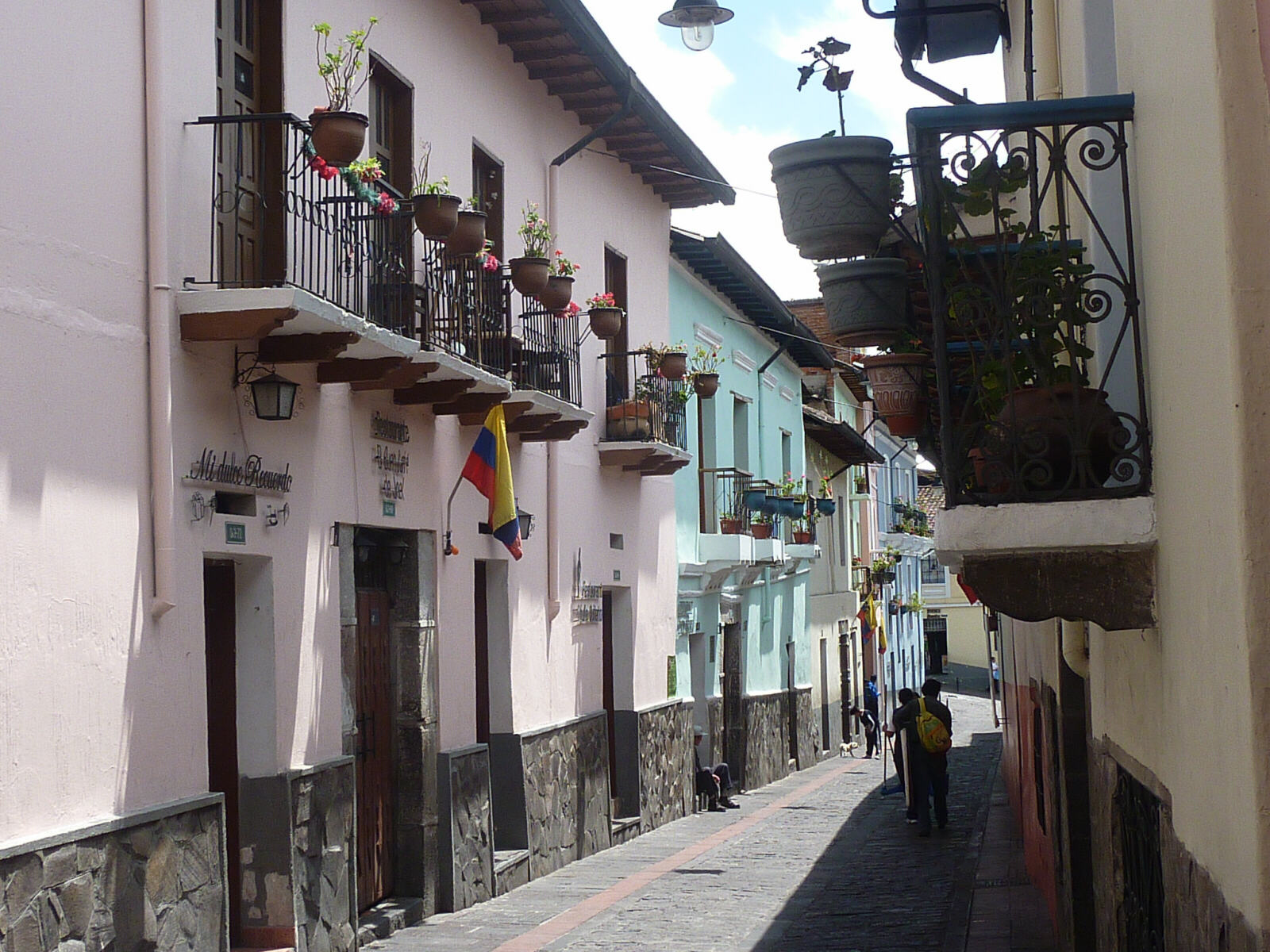
|
So far it had been sunny but it suddenly clouded over and a thunderstorm blew up. We had sausage and chips in a café until the worst of the rain had blown over, then walked back to Theatro Plaza dodging the rain and got a taxi back to Plaza Foch. We sat in the Brau German bar by the plaza people-watching for a while then returned to the hotel. In the evenings we went to La Boca restaurant just down the road from the Plaza, an interesting place decorated to look like the coloured houses in La Boca suburb in Buenos Aires .... |
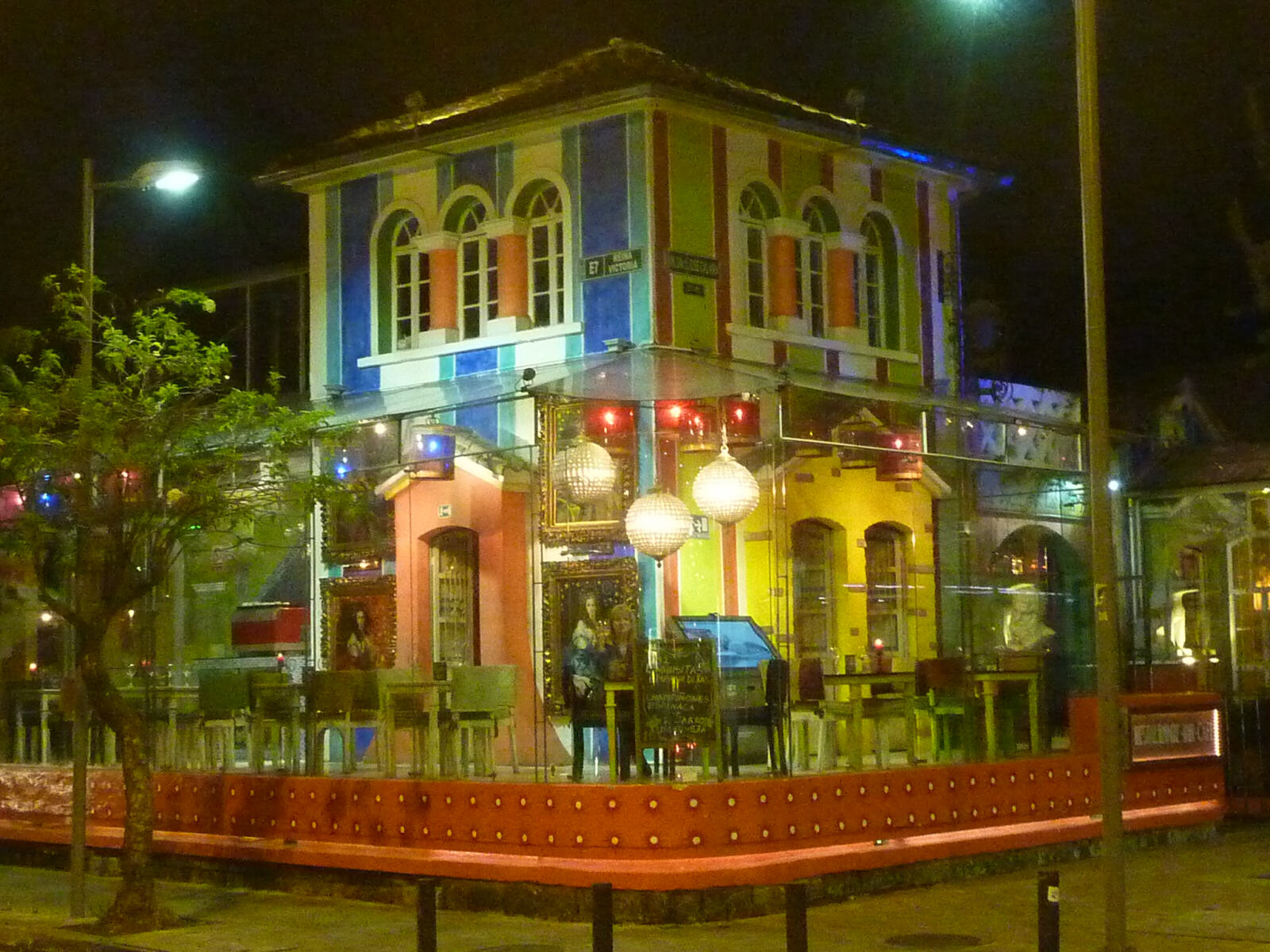
|
.... and had plates of tasty mini-empanadas with nice wine followed by ‘furious chicken’, chicken wrapped in ham in a tarragon cream sauce, sitting in the prime window seat and listening to the live band in the next room.
|
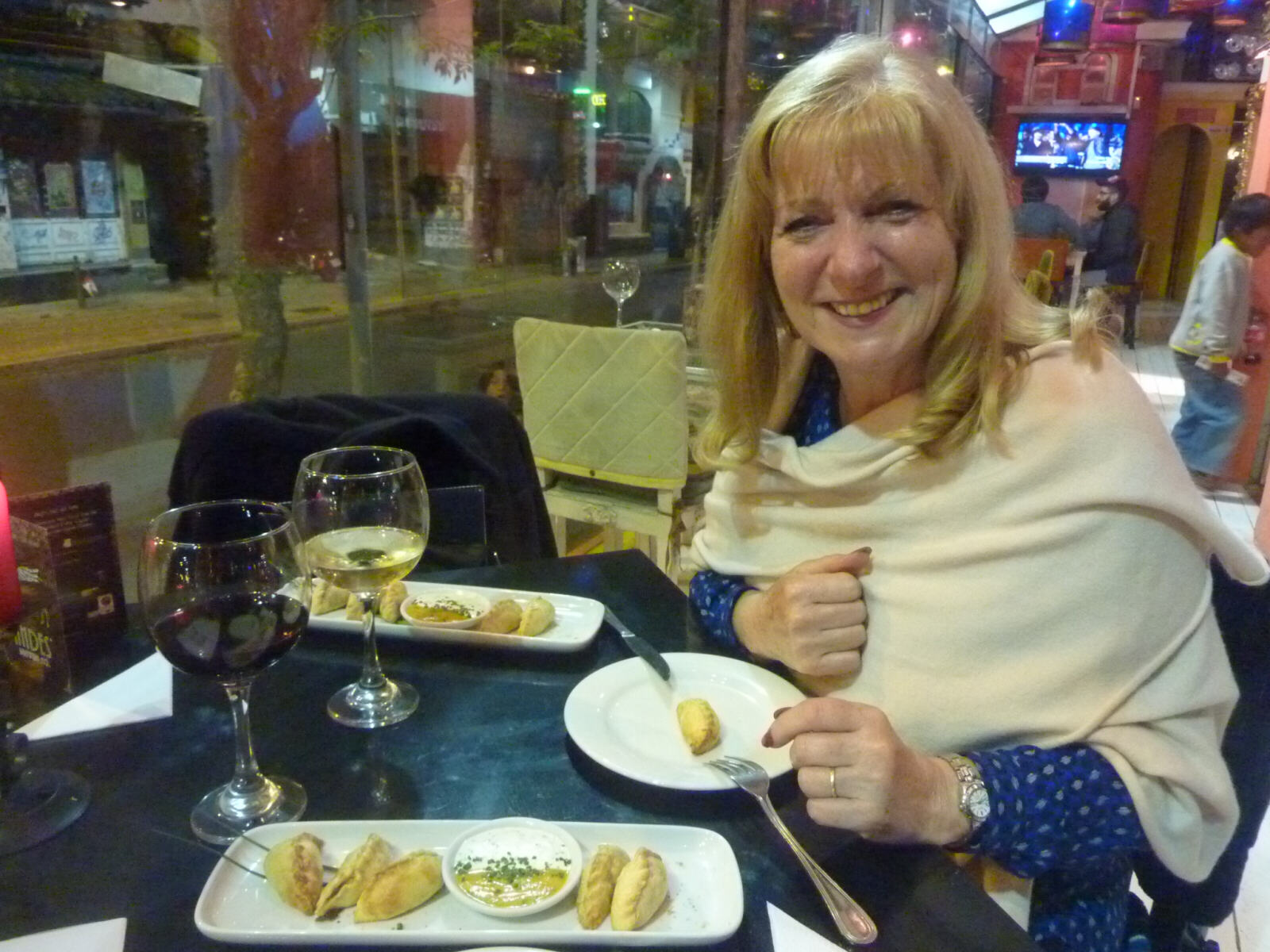
|
The Equator and Otavalo, Ecuador
|
Sat 7th. We knew it was the rainy season and we expected thunderstorms and sudden downpours like yesterday, but we weren´t expecting the continuous rain that lasted all night and through most of today. Nevertheless, we set off as arranged just after 7am with Wilson, a nice Ecuadorian driver who will take us to the Saturday market and on to the Colombian border, as arranged by Gabriela, the nice lady at Yellow House hotel. We stopped at a viewpoint to see a volcano but all we could see was cloud. Our next stop was on the equator as we passed from the southern to the northern hemisphere, but we felt that the equator was colder and wetter than it should have been! |
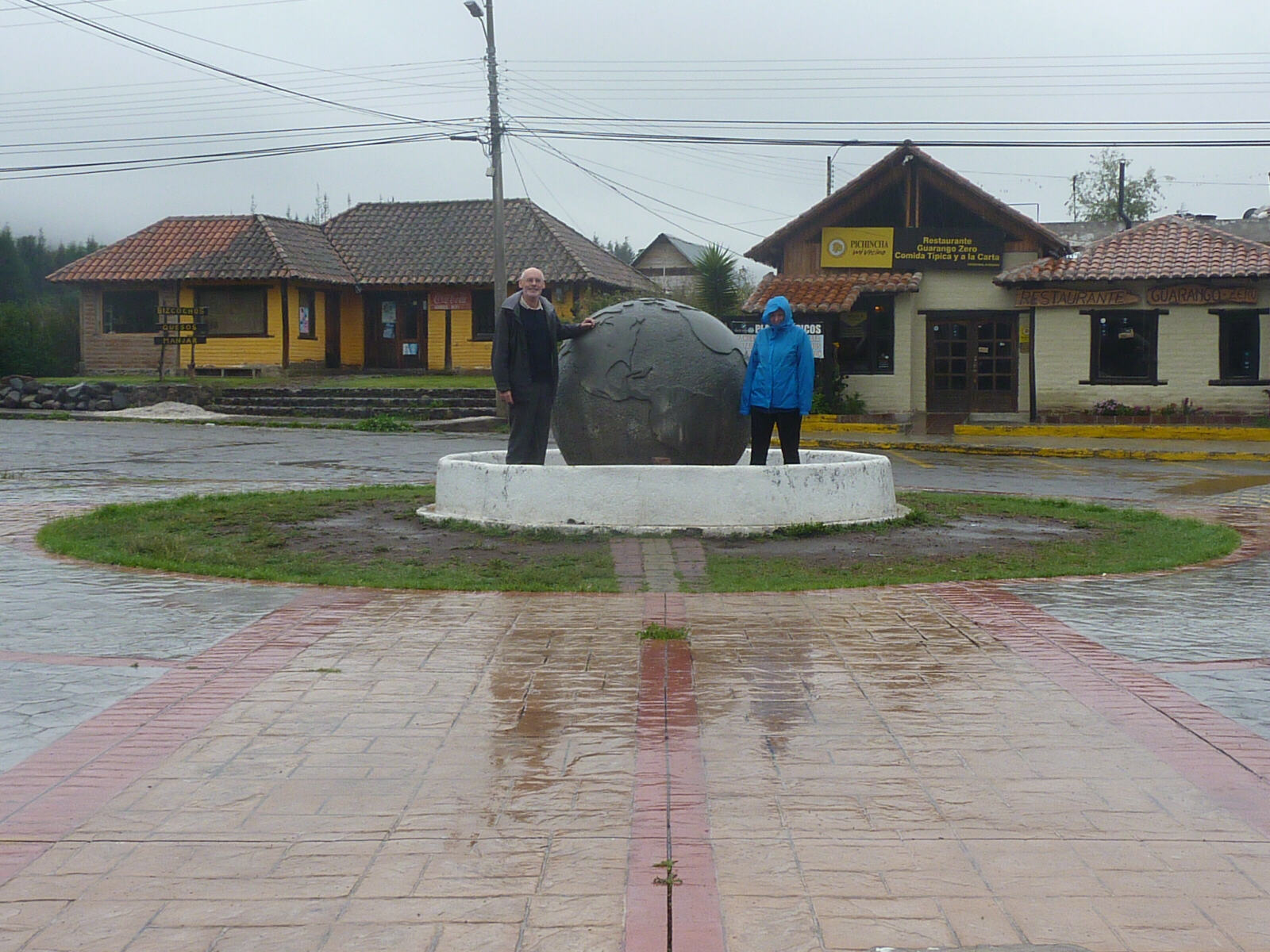
|
There was lots of agriculture and greenhouses for flowers along the way, but it seemed ironic that greenhouses on the equator had to have hot air piped into them. We stopped at Otavalo and walked round the weekly indigenous people´s market and this was a real treat – everything was so colourful and there were lots of fascinating indigenous people selling and buying things .... |
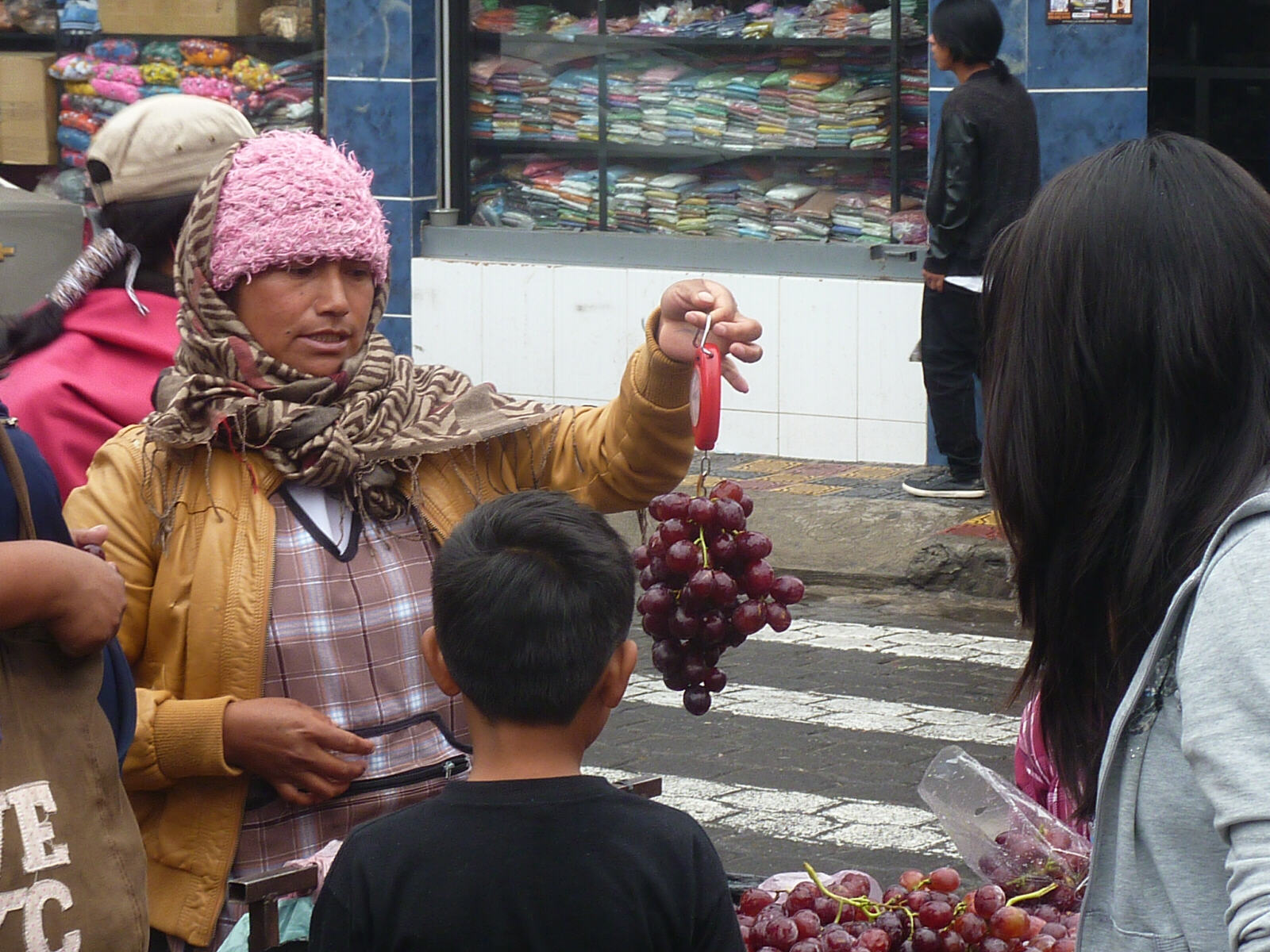
|
.... and having their lunch. We arrived well before the tour groups and for a couple of hours we seemed to be the only foreigners amongst the throngs of locals.
|
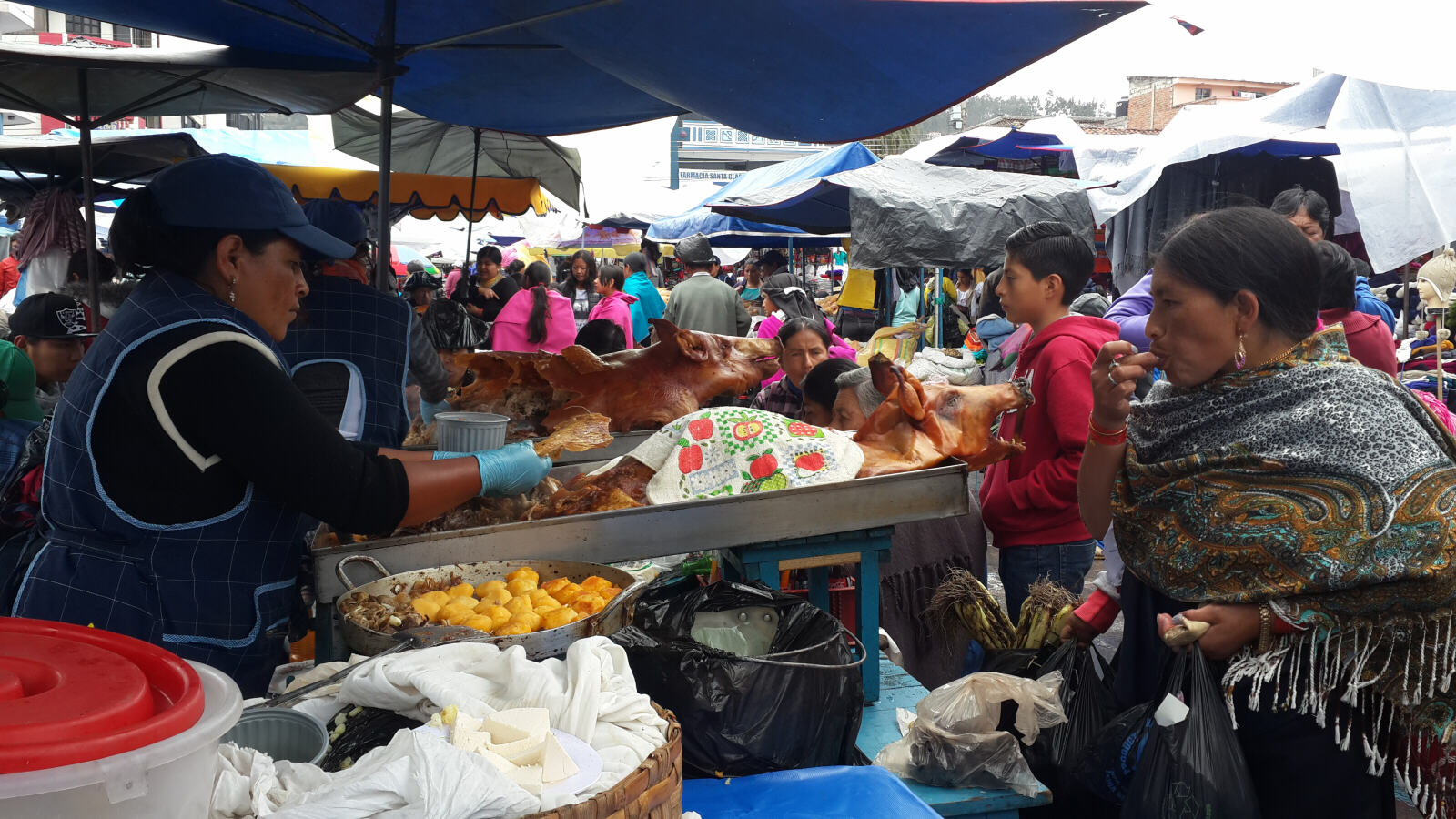
|
We walked out to the edge of town where the animal market was just winding down .... |
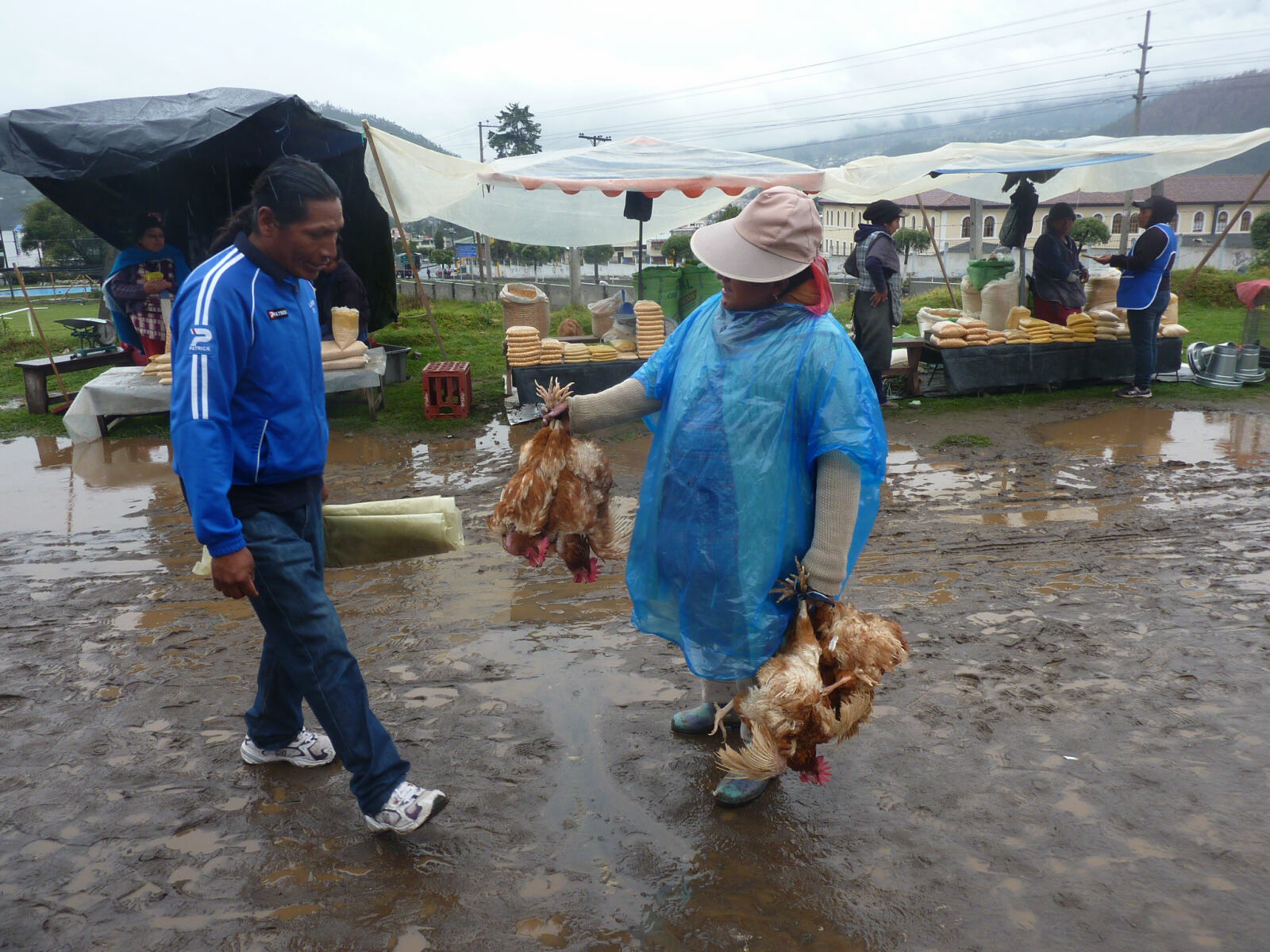
|
.... and people were selling squealing pigs from the backs of trucks ....
|
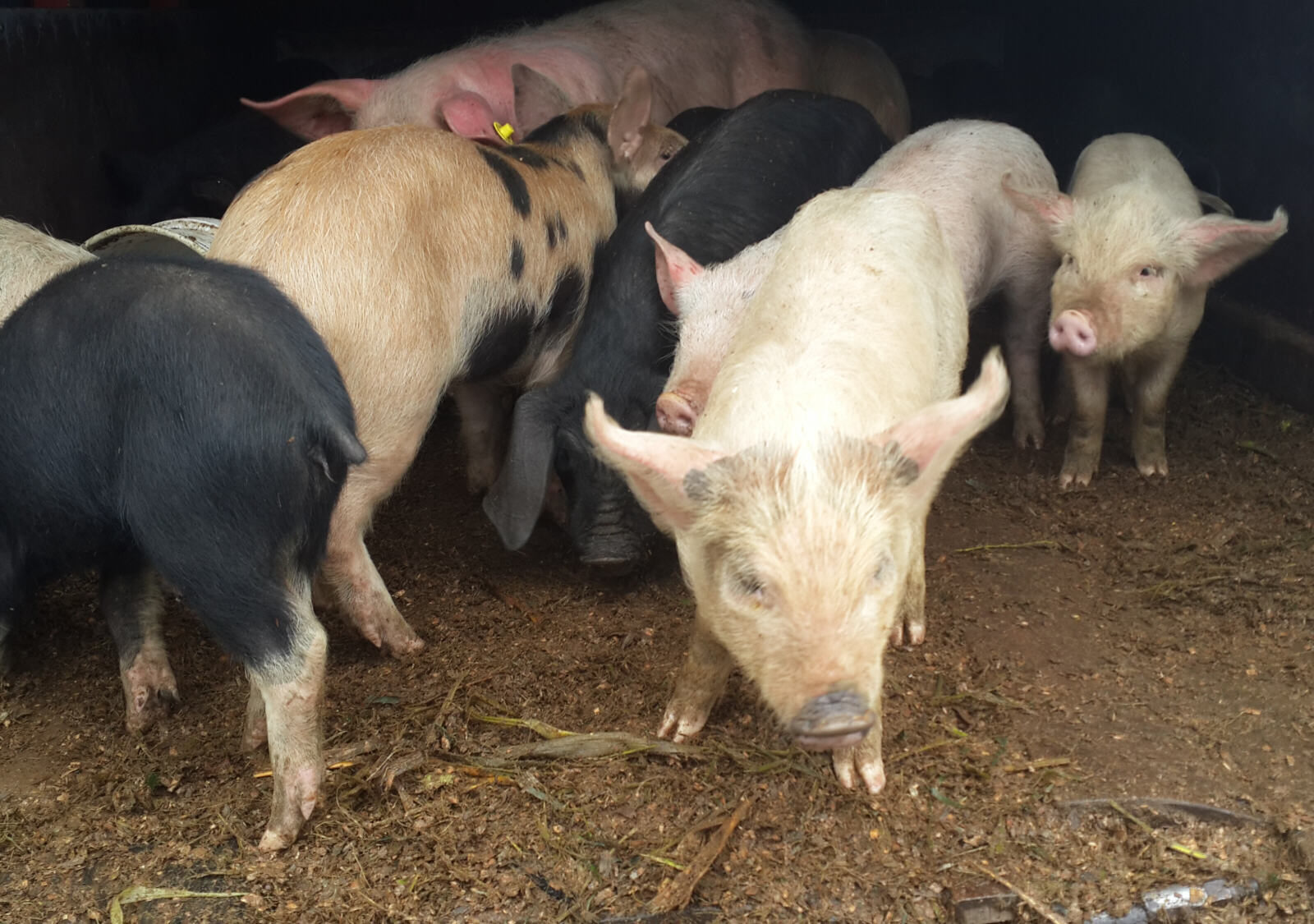
|
.... and carrying sacks of live guinea-pigs around. After three hours we dragged ourselves away and Wilson drove us another couple of hours to the border.
|
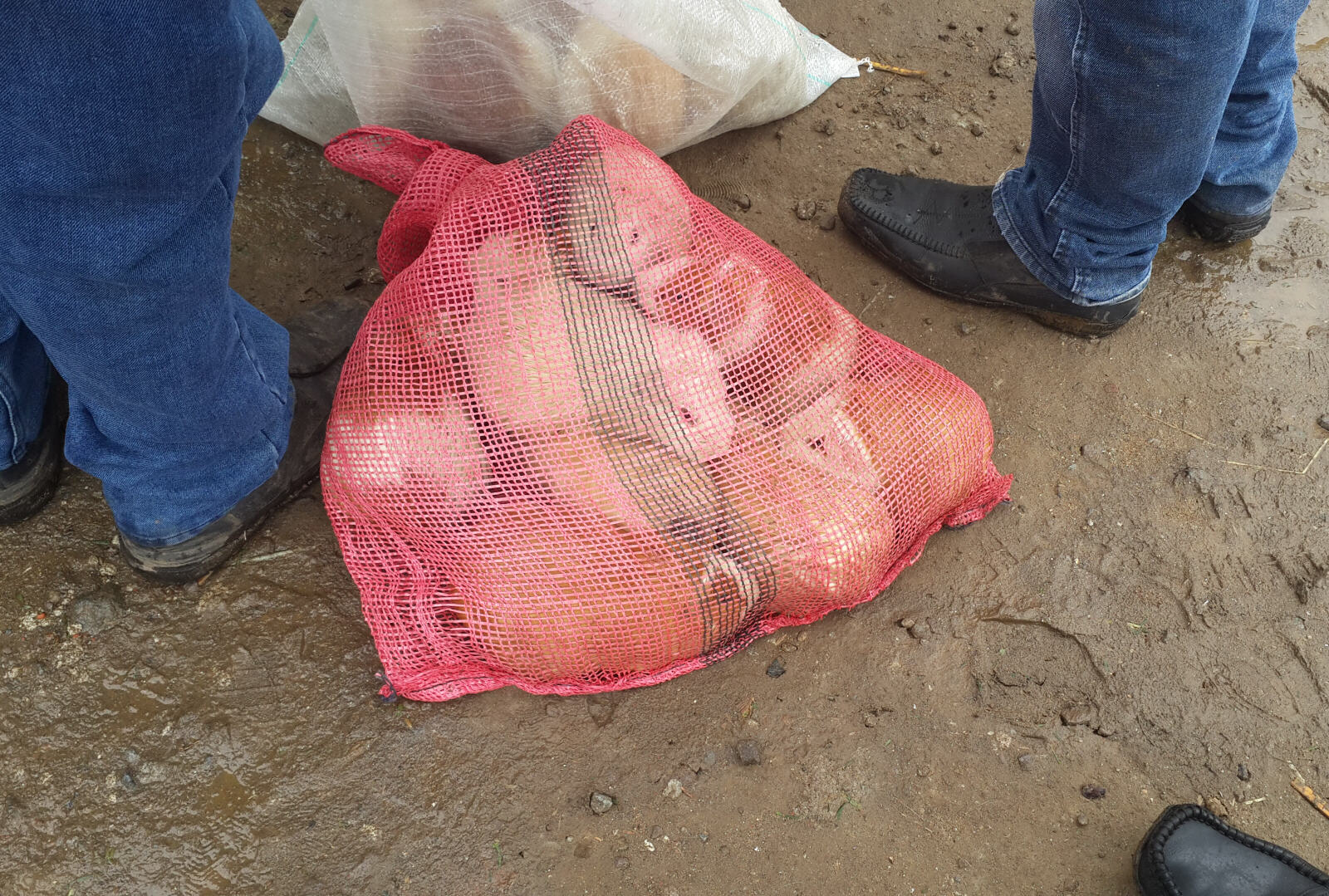
|
Ecuador-Colombia border
and Pasto, Colombia
|
Again the formalities were very straightforward and before long we were in Colombia. We changed some dollars at a reasonable rate with the very helpful moneychangers who were standing around outside the immigration office, then got a taxi to the bus terminal for 4,000 pesos (one pound – the money is tricky here because the numbers are so huge, it´s easy to be out by a factor of 10 which can be an expensive mistake). At the bus terminal we immediately booked onto a minibus for £2 each to Pasto, the next town two hours up the road, and ten minutes later we were on our way. At Pasto bus terminal we booked our next bus for tomorrow, then got a taxi to the Sello Dorado hotel, chosen at random, which was clean and adequate for £12. The choice of restaurants nearby was limited to one, Mister Pollo, a chicken fast-food place where we had an extremely nice chicken fajita with guacamole and refried beans, and a rather chewy steak (Sheila’s mistake but she more than helped me with the fajita), with a couple of local beers. A full day!
Sun 8th. The Sello Dorado was clean and nicely decorated, but was the noisiest hotel we´ve stayed in. Every sound echoes throughout the building and all night long people were talking, doors were banging, televisions on and phones ringing – at 4am Sheila went to sort them out which helped a bit. We were glad to get to the bus station, have a cup of coffee and a bun and get the 9:30 Transipiales bus to Popayan (6 hours, £2 each). It was a spectacular ride through the mountains with the road snaking down through steep valleys and up over passes, with the sun shining on little farms clinging to the hillsides, although this section has the reputation of being quite dangerous and there were plenty of armed police along the way, who gave our driver a thumbs-up to show there were no bandits in their vicinity. |
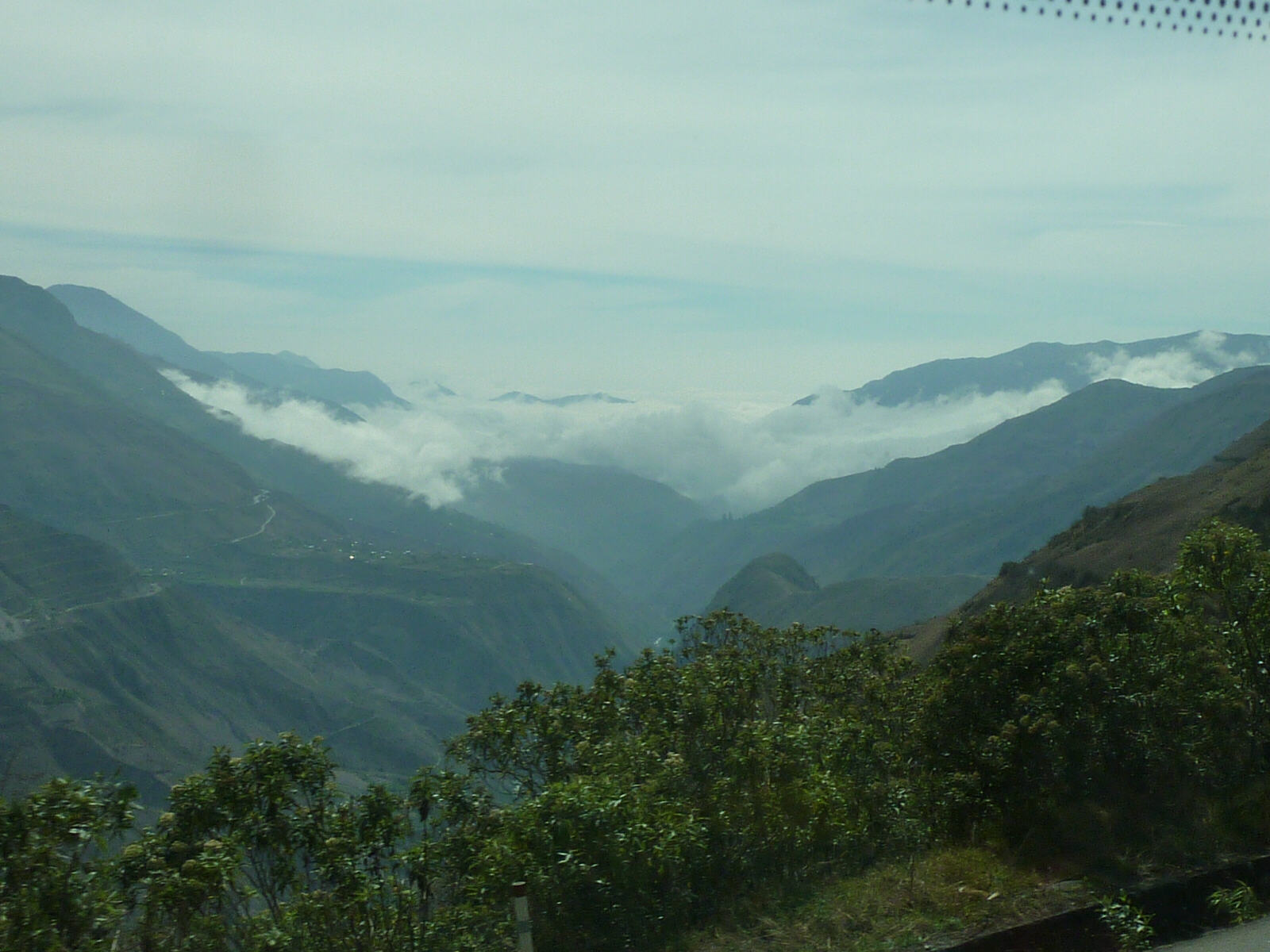
|
There was one lunch stop where all the passengers dashed madly to order food and get it eaten before the driver started hooting to get going again – by pointing at what people were eating at a nearby table we managed to order a tasty Wiener schnitzel with refried beans and a big bowl of soup with potatoes and corn-on-the-cob in it. |
Popayan, Colombia
|
At Popayan we went to the hotel Camino Real which was a great choice, in a nice old historic mansion with rooms around central courtyard gardens, just off the main square. We had what seemed like the best room, 209, for £30, a nice big room with wooden shutters on windows overlooking the garden. It had clouded over and was spitting with rain but we ambled round the square, stopped for a spiced chai in a trendy little café and enquired at tourist information where there was a good restaurant. They directed us round the corner to another great choice, La Cosecha Parilla (grill) where a helpful chap, one of the waiters and our translation app combined to translate the extensive menu. We had patacon con guacamole to start, rather dry plantains with delicious guacamole dip, then chateaubriand, not like normal chateaubriand but still delicious steak with garlic butter, and lomo emparador, another delicious, tender steak topped with asparagus sauce and huge prawns. All of this was accompanied by a selection of dips including more guacamole and a tangy, herby Argentine-style chimichuri. To wash it down I had a half-bottle of Gato Negro (black cat) cabernet sauvignon while Sheila had a big jug of Sangria, which was actually ¾ fruit salad and ¼ wine. When she ordered it there was a lot of puzzled conferring behind the bar and we´re sure it´s the first one they´d ever done. So all a bit eclectic but still a wonderful meal.
Mon 9th. Popayan is another lovely colonial town so we did a bit of strolling round the streets and the main square until it clouded over and began to rain, when we did the traditional thing and went for lunch. |
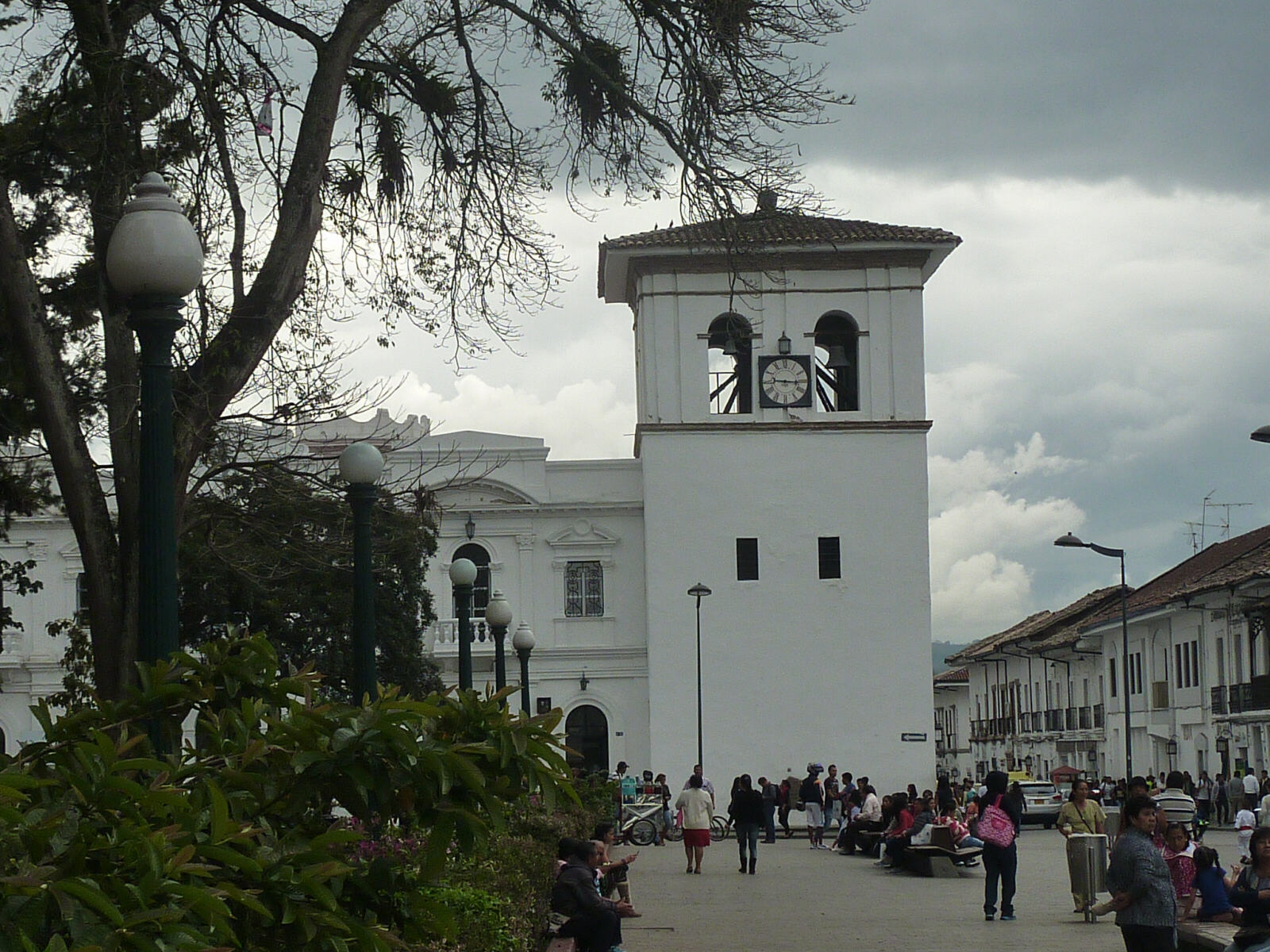
|
The restaurant in our hotel was highly recommended and seemed popular with business people so we had two huge and filling soups there, one French onion soup and the other Sopa del Pacifico, which had just about every kind of seafood in it and was winner of a Unesco prize! |
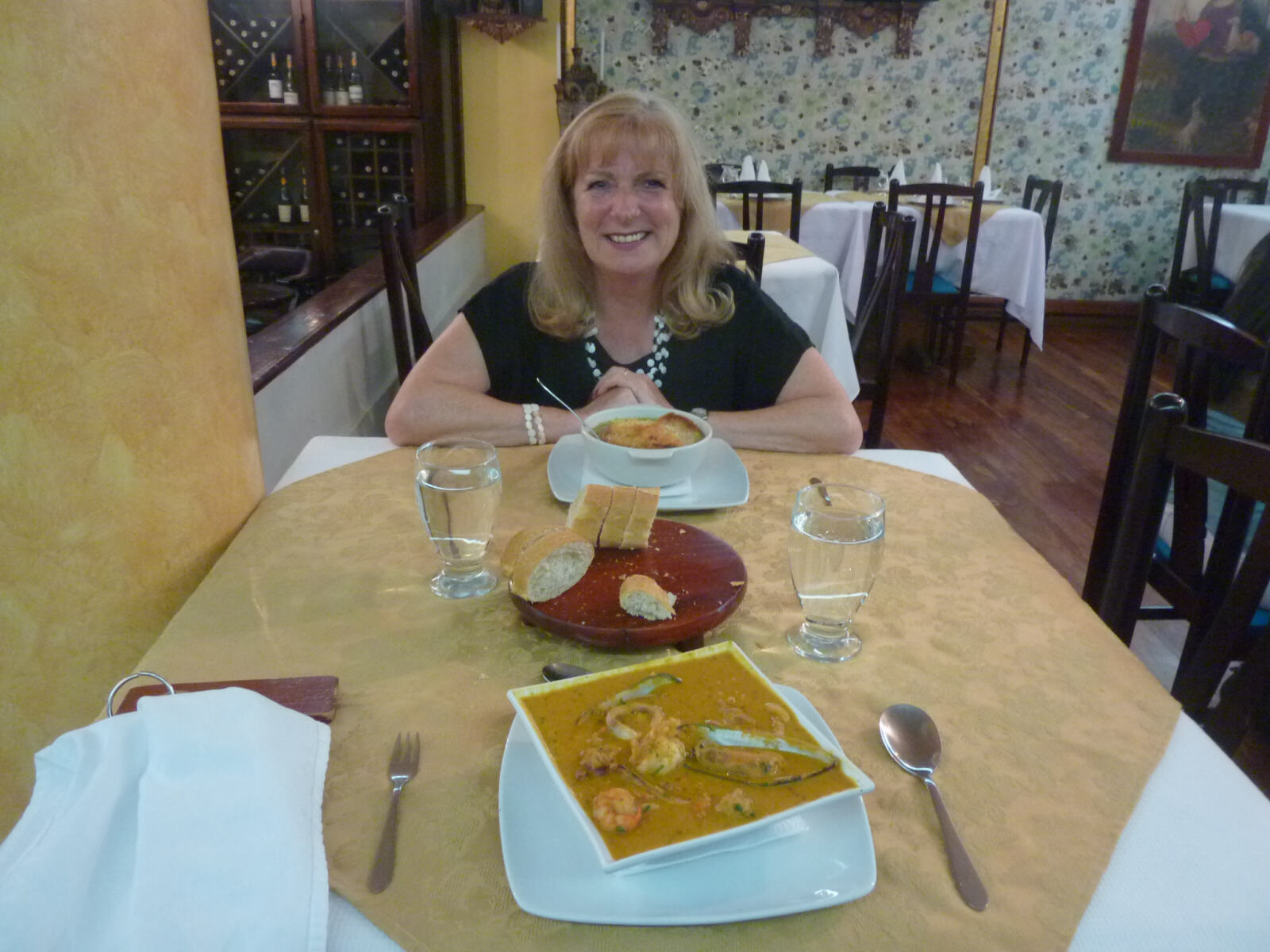
|
In the evening we returned to the restaurant at Camino Real and had a couple of huge steaks – mine was very tasty with a mustard and mushroom sauce but Sheila was very disappointed with her Roquefort sauce because there was hardly any of it.
Tues 10th. On the spur of the moment we decided to go to the Tuesday indigenous people´s market at Silvia, a town up in the hills about 50km away. The hotel arranged for Maria, a driver/guide to take us (170,000 pesos, about £42) and she was a really nice person and a good driver. |
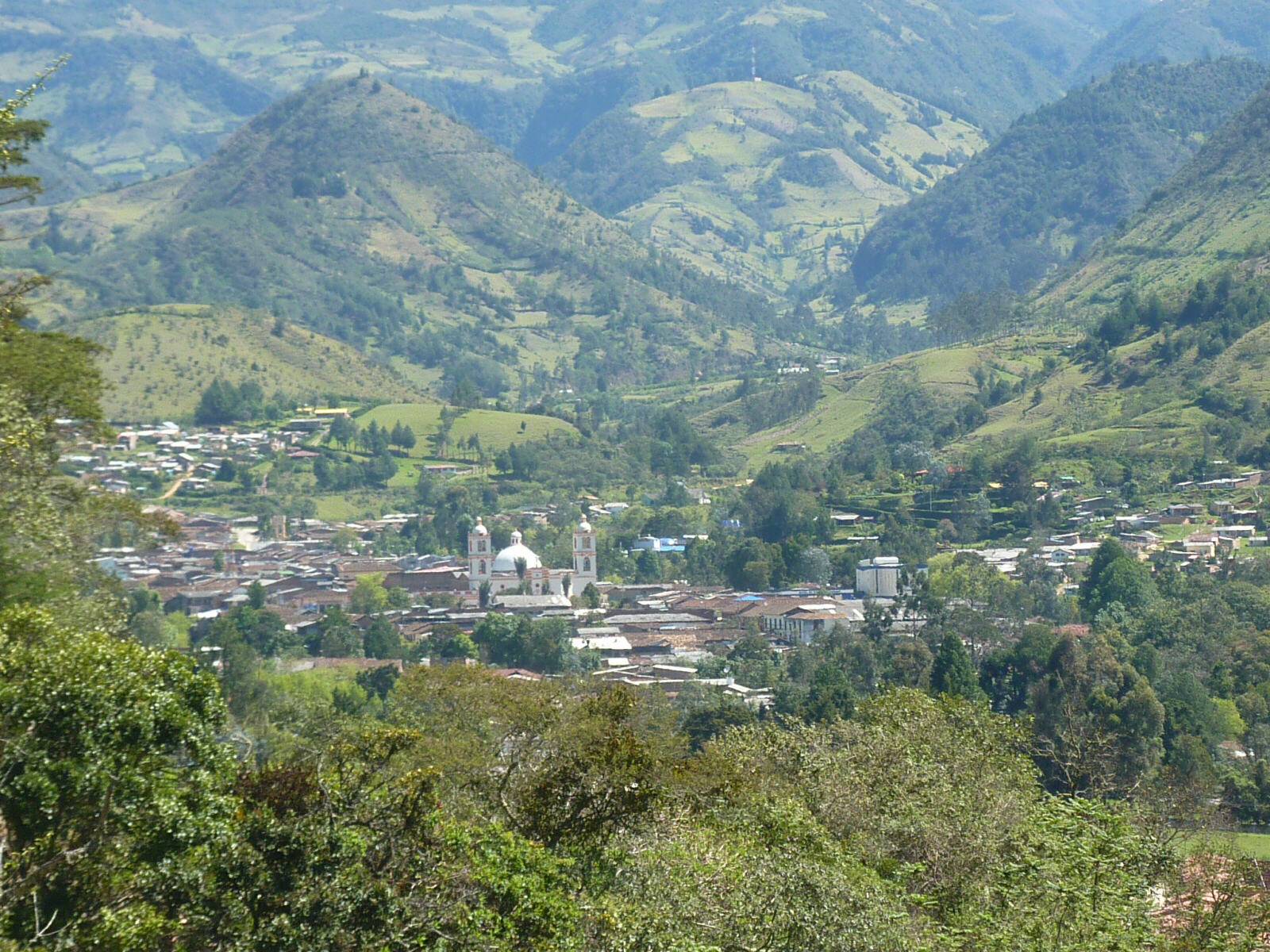
|
The scenery was lovely as we went up into the mountains, and the market at Silvia was absolutely fascinating .... |
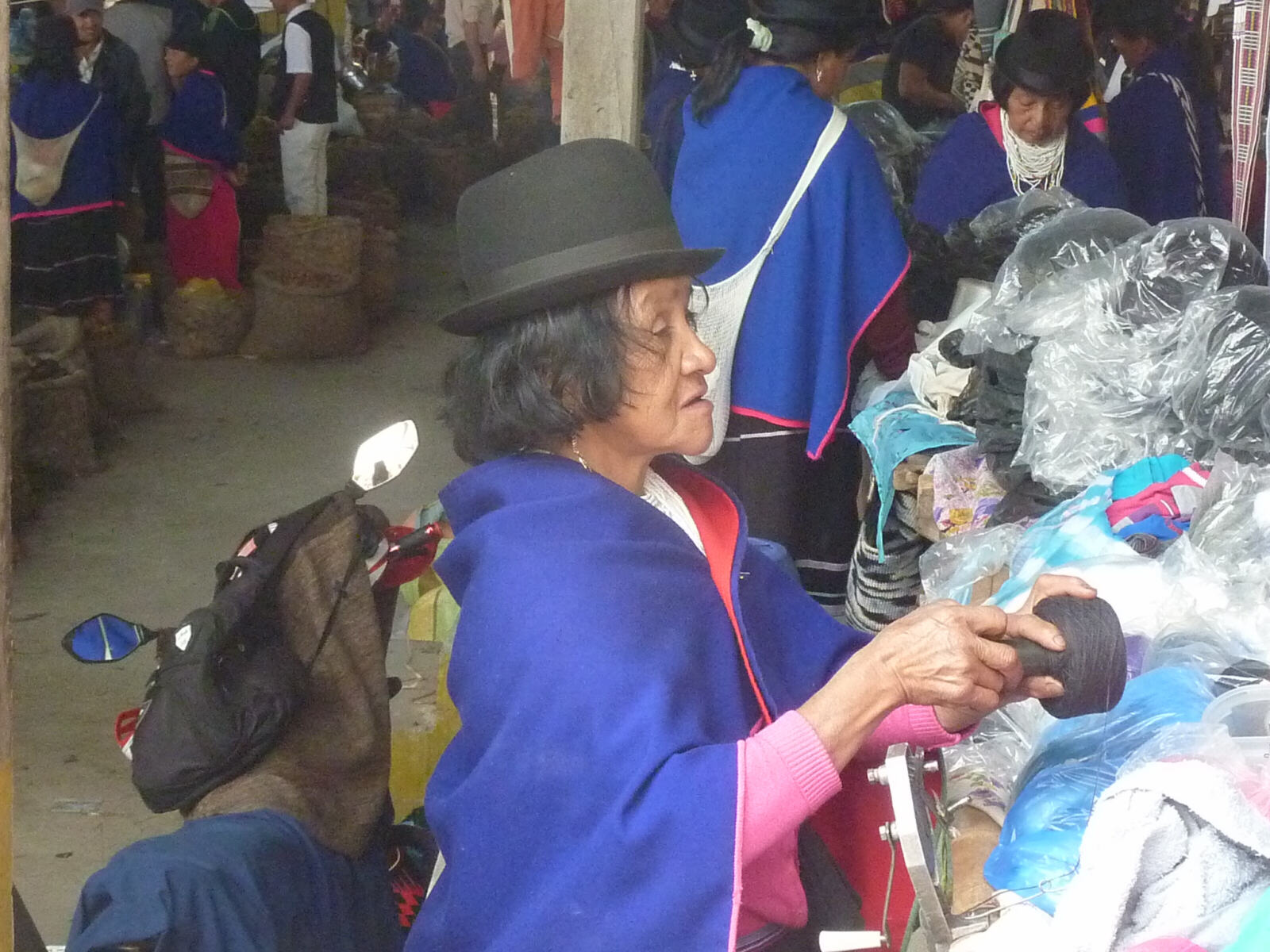
|
.... full of interesting local people in colourful clothes and big boots and with black hair in a ‘pudding’ cut.
|
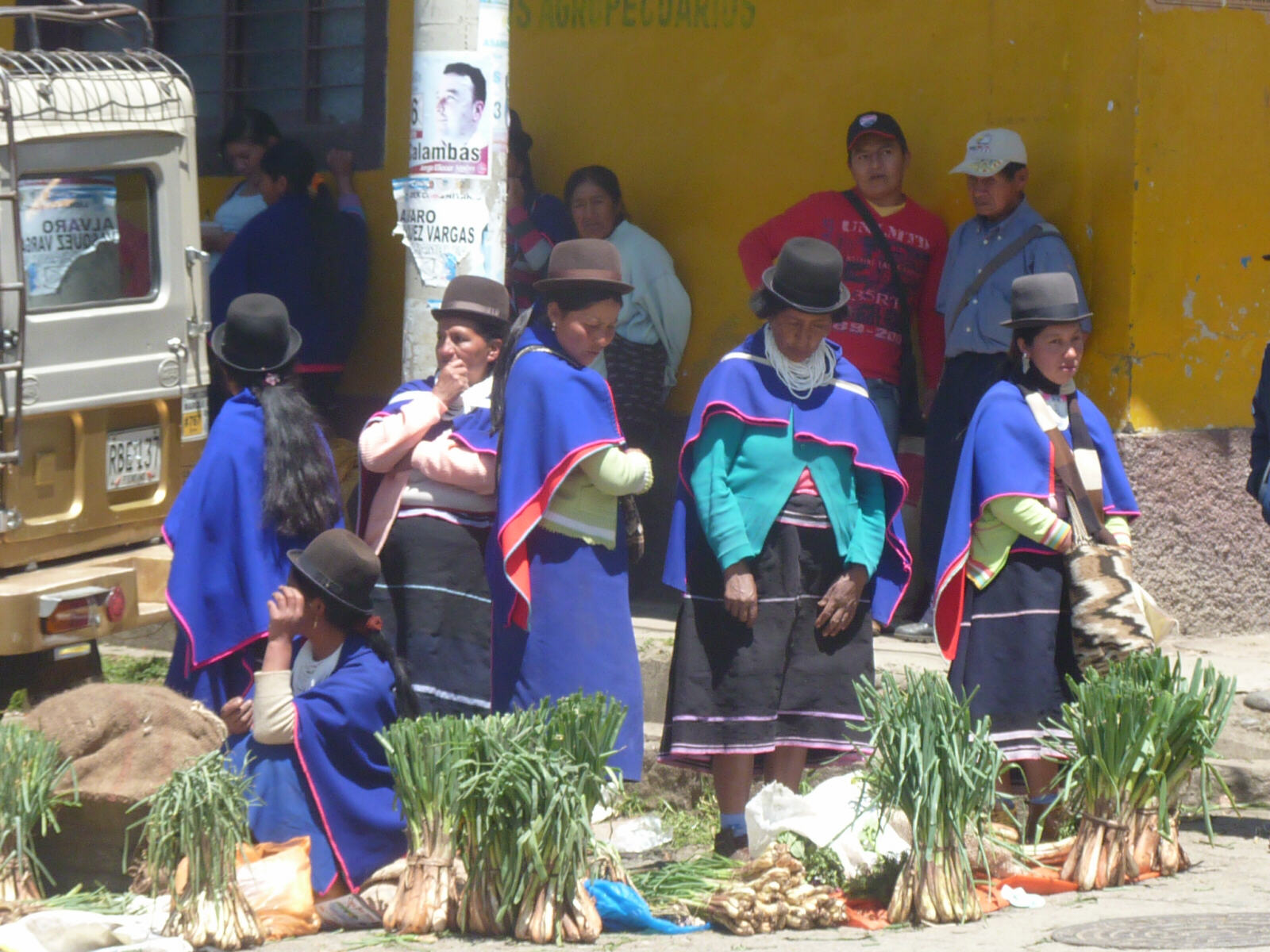
|
The meat stall was particularly grisly, with a chap skinning a pig´s head and another cheerful chap waving sheep´s heads and feet at us, but they liked having their photos taken unlike the indigenous people who foiled most of our attempts at photos. |
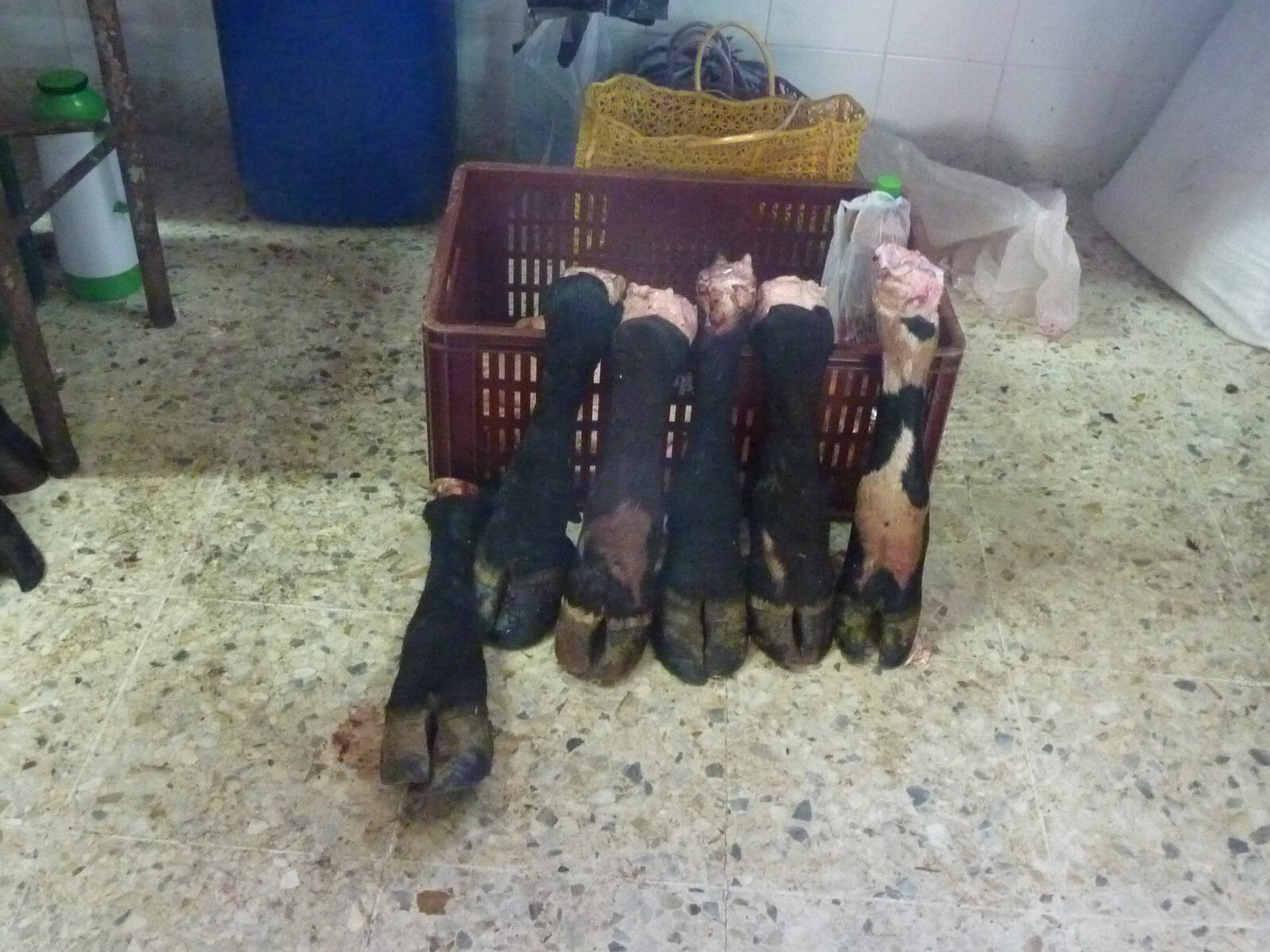
|
Around the square were the antiquated buses that take the people and their purchases back to the villages when the market is over. |
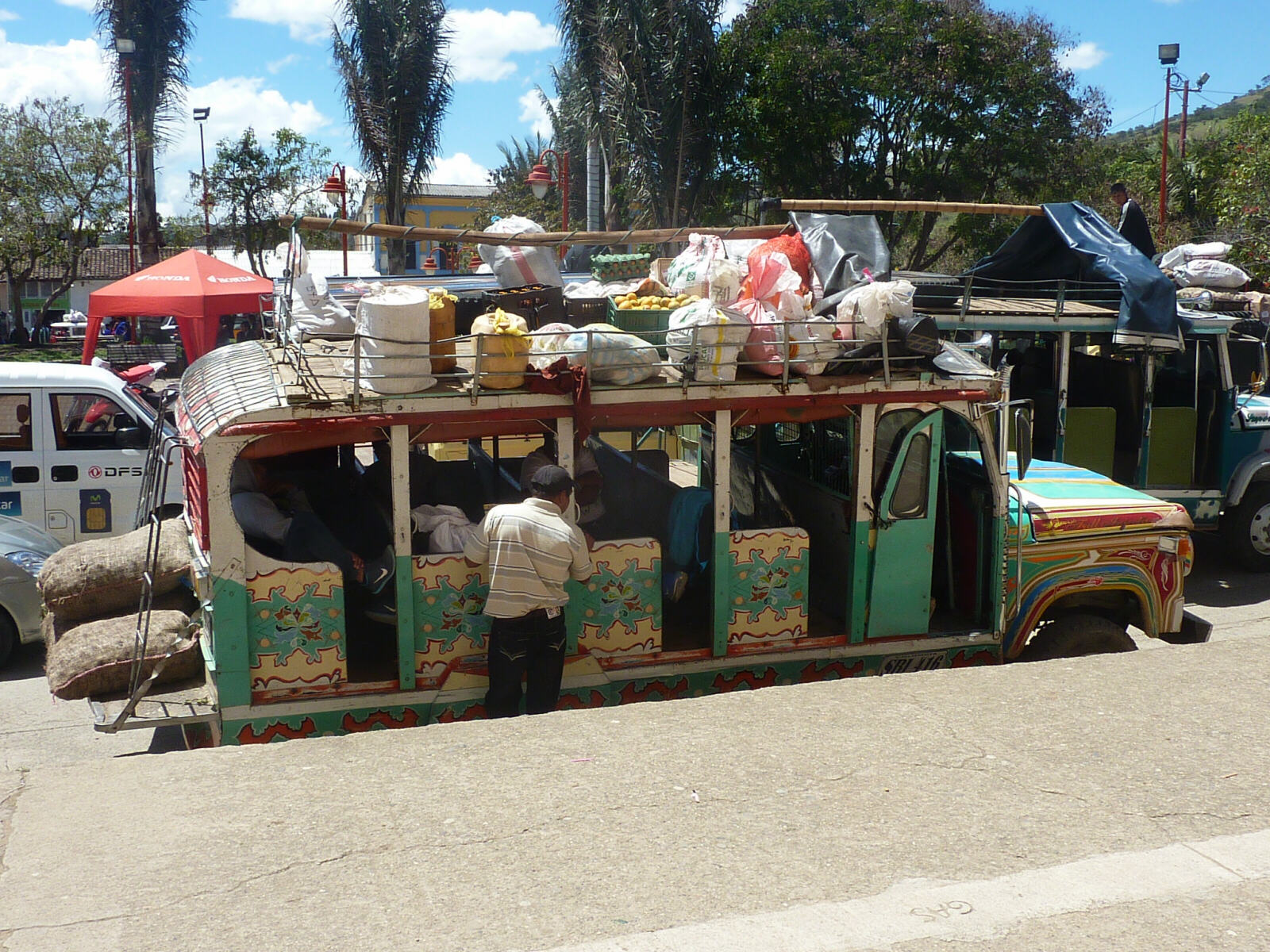
|
The weather was beautiful and we wandered around until it was time to go back. We checked out of the hotel and went for late lunch/early dinner at La Cosecha Parilla and had mini-empanadas with spicy dip (very nice) and some sort of fruity thing covered in several different sorts of cheeses (very peculiar). We set off at 6pm to go to the bus station but all the taxis were full and when we eventually got one, the traffic was completely snarled up. We just got there in time for the 7pm bus to Bogota (12 hours, £23 each). |
Bogota, Colombia
|
Weds 11th. Although not as luxurious as the Cruz del Sur buses, the Frontera bus was comfortable and quiet and we both got quite a bit of sleep. The bus seemed to be timed to arrive in Bogota just at morning rush hour and we had a slow drive across the city in another traffic jam. We had more traffic jams in the taxi on the way to the hotel, the Hotel Regina, a very nice hotel with friendly staff, conveniently located not far from the Candelaria historic district. They very kindly gave us a free breakfast because we were so early, then we did a little bit of walking about down to the main square and the cathedral and a couple of the historic old streets. We also had a look at part of the gold museum (free for over 60s) which was full of fascinating pre-Colombian gold artifacts. |
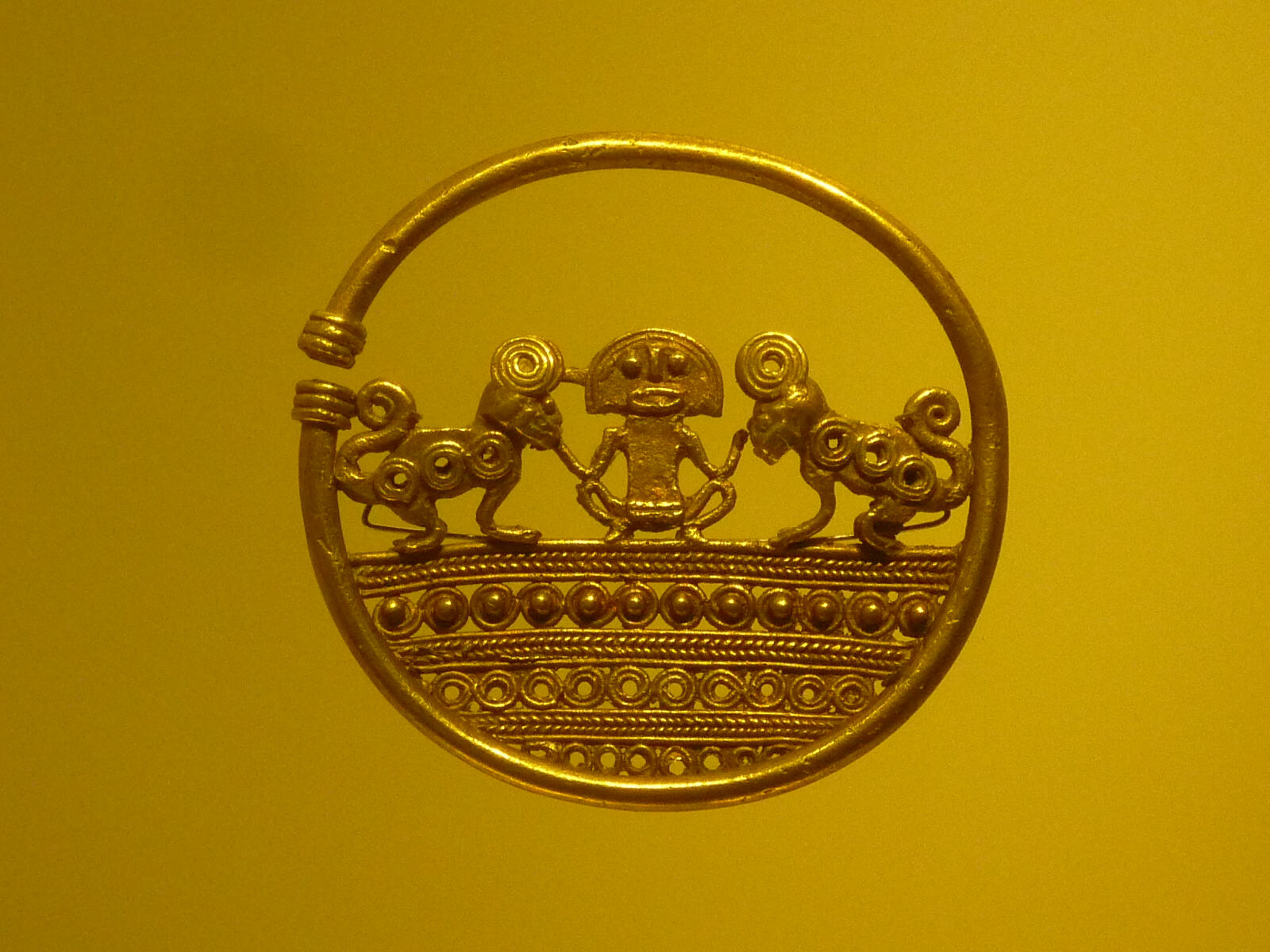
|
In the evening we got a taxi way across town to the Retiro district and Andres DC restaurant, an amazing ´happening´ place on four floors with a 32-page menu with 800 options. The place was packed and despite having a booking we had to wait quite a while at the bar but it was fascinating to watch all the revellers (mostly large parties of 20 or more diners), the ambling brass band who played a tune to each party who were celebrating some occasion, and the mime artists and Charlie Chaplin impersonators draping themselves on the staircases or sashaying around tables. |
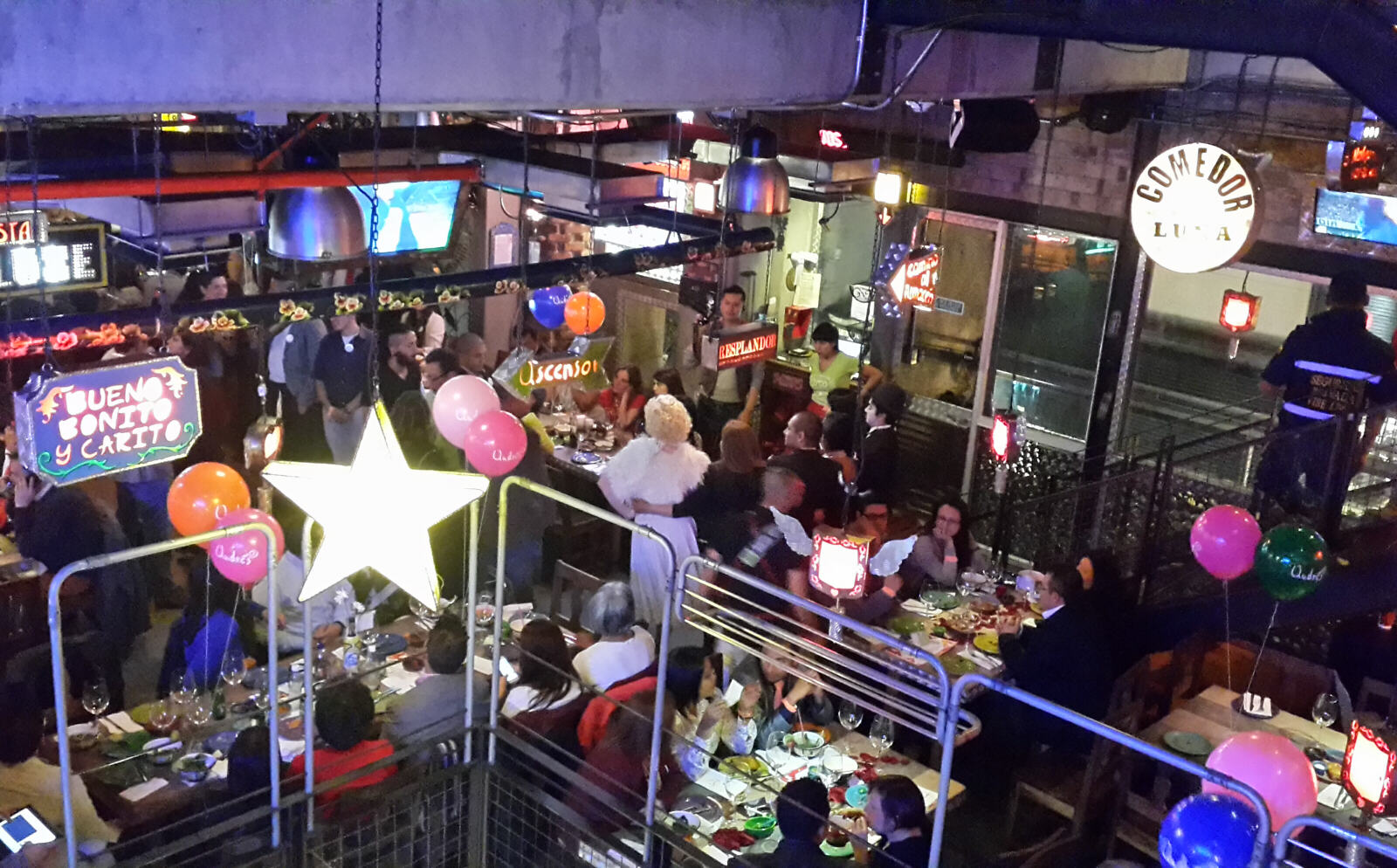
|
Eventually we got a table at the side with a great view of the goings-on – by now lots of the diners were dancing to the music in any available space – and had a wonderful meal of empanadas with a tangy guacamole dip, a chateaubriand which was much better than the last one, and tender Argentine-style sliced fillet steak. Delicious and great entertainment. |
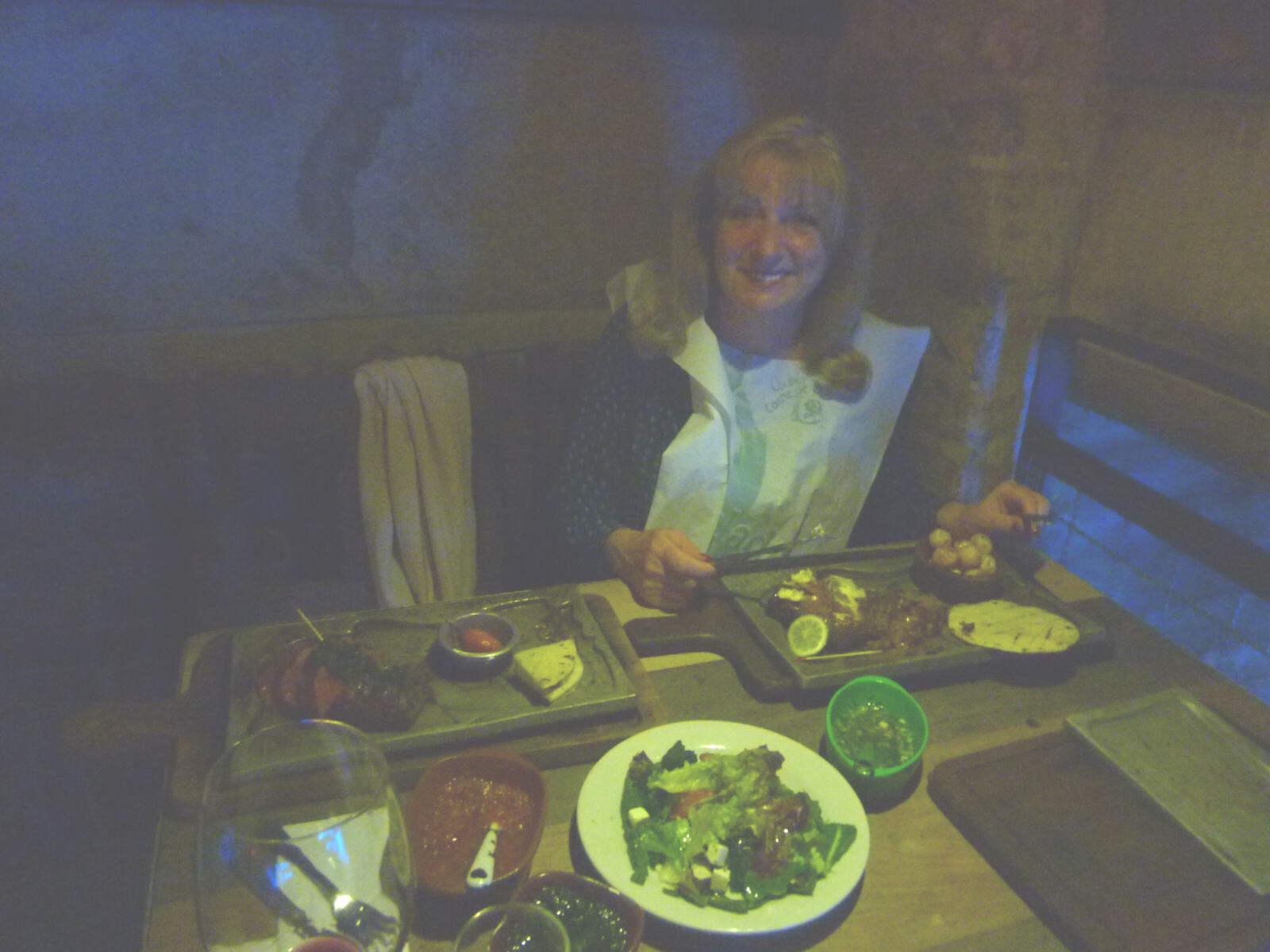
|
Thurs 12th. We had another stroll around the historic district then got a very annoying jerky taxi driver to the north bus terminal. We were early so we had a tasty sandwich and a coffee in a small café there, in a corner table where we could guard our luggage from the thieves and vagabonds who are reputed to roam the terminal, although they appeared to be well outnumbered by the patrolling police armed with AK47s. We got a minibus for the four-hour ride to Villa de Leyva (£6 each) through a wide fertile valley full of farms, crops and hundreds of cows. |
Villa de Leyva, Colombia
|
It was dark and had been raining when we arrived and everyone in town was huddled round televisions watching a crucial World Cup qualifying match between Colombia and Chile, so we started to stumble across the wet cobblestones up the main street when a lone taxi driver out and about stopped and took us the short ride to Casa Terra, our hotel. Casa Terra is absolutely beautiful, a lovely house in a colourful garden. The nice lady there recommended El Rincon Gourmet, a restaurant and piano bar just off the main square a few blocks away. As we were walking towards it there was a power cut for a couple of minutes and apparently at that precise moment Chile scored the first goal, so people were a little bit glum when we arrived. Nevertheless all the people in El Rincon Gourmet were so friendly and welcoming and everyone there seemed to be friends and family (except the two armed policemen peering in through the door to watch the match), and when Colombia scored the equalizing goal we cheered heartily along with them. The meal was delicious, we had a starter of Spanish salamis and hams, then Sheila had a lobster tail with lime ghee and I had grilled salmon, all wonderful. From time to time Jorge the proprietor expertly played a tune or two on the piano, when the football action wasn´t too attention-grabbing. |
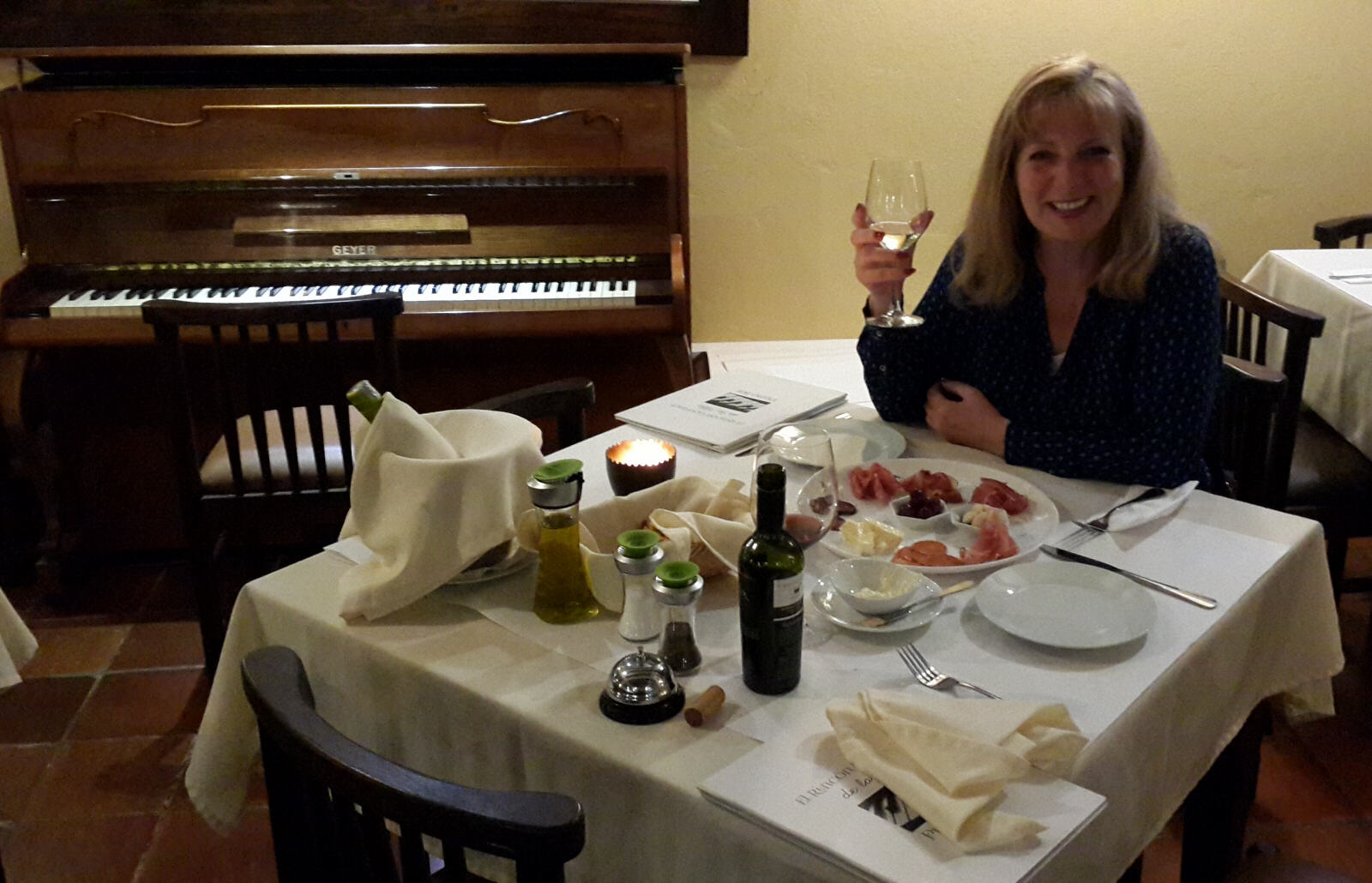
|
Fri 13th. We had a nice breakfast sitting out in the sunny, tranquil garden at Casa Terra .... |
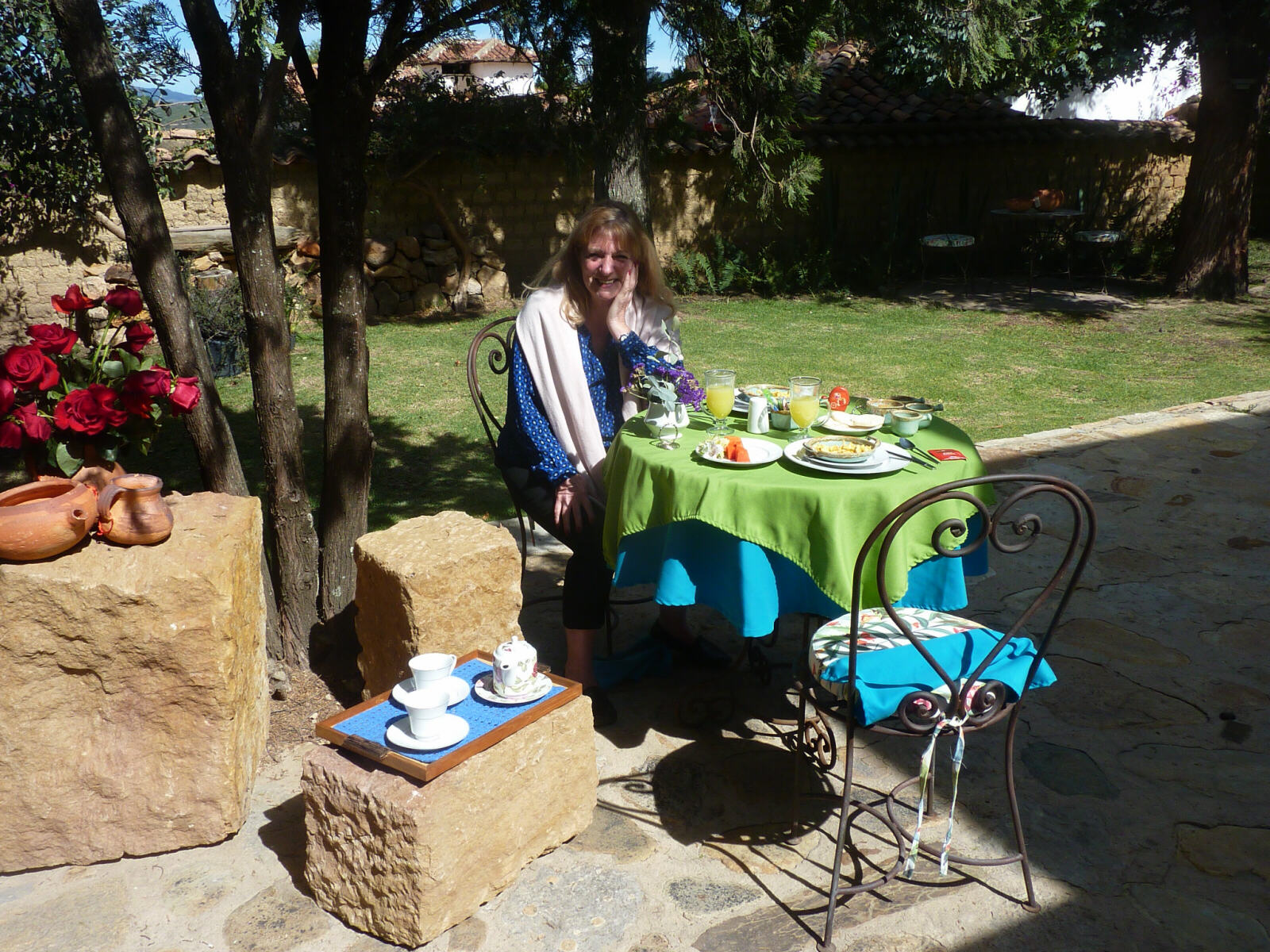
|
.... watching the hummingbirds at the bird-feeder ....
|
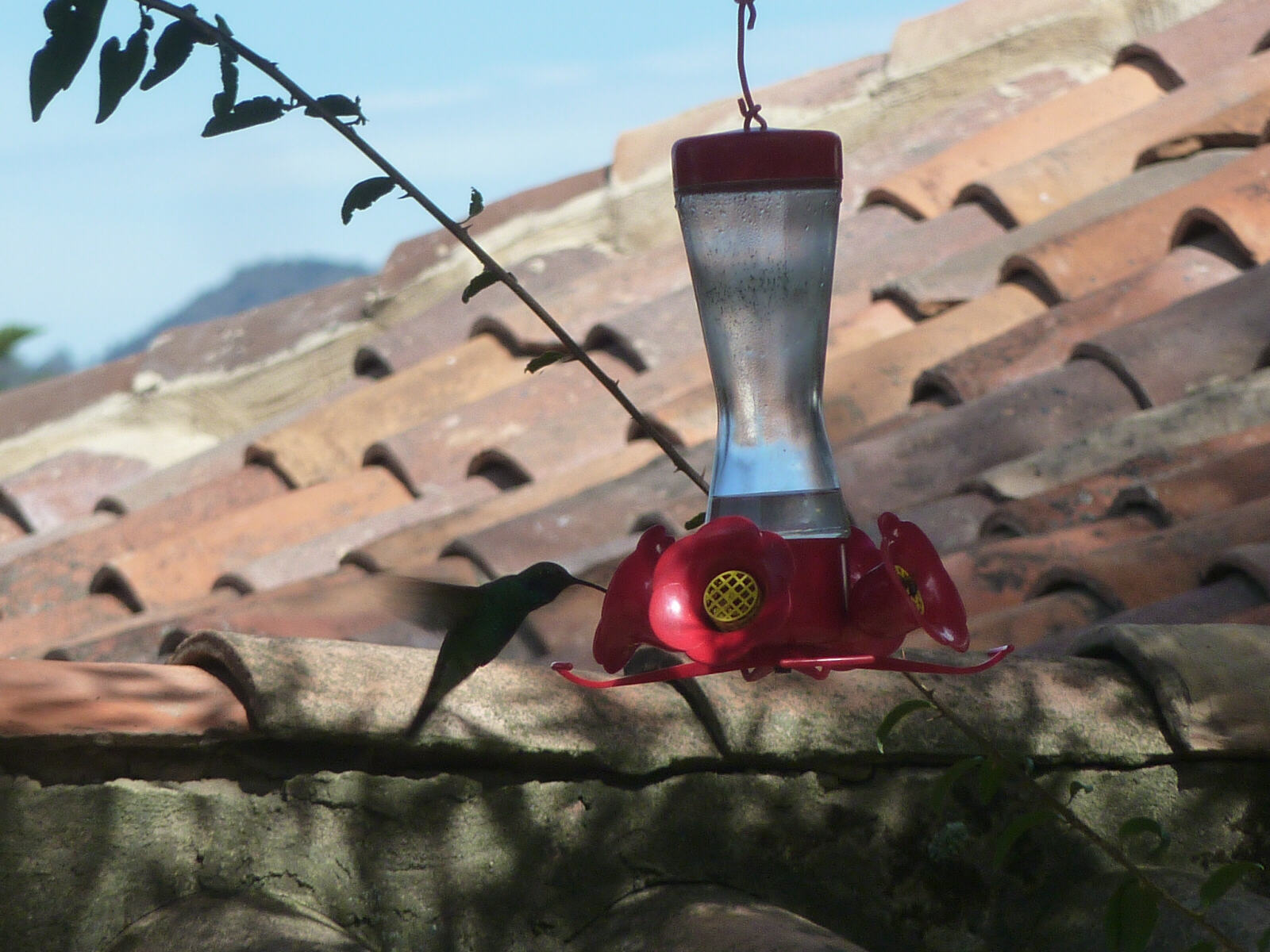
|
.... and talking with Lucia, the nice lady who, it turned out, did all the lovely interior design for the hotel. She showed us some of the other five rooms, all beautiful, all with views over the peaceful garden. We set out for our walking tour of Villa de Leyva and spent several hours just strolling around the cobbled streets and plazas, all surrounded by pretty, old-fashioned balconied houses with nice interior courtyards and colourful flowers.
|
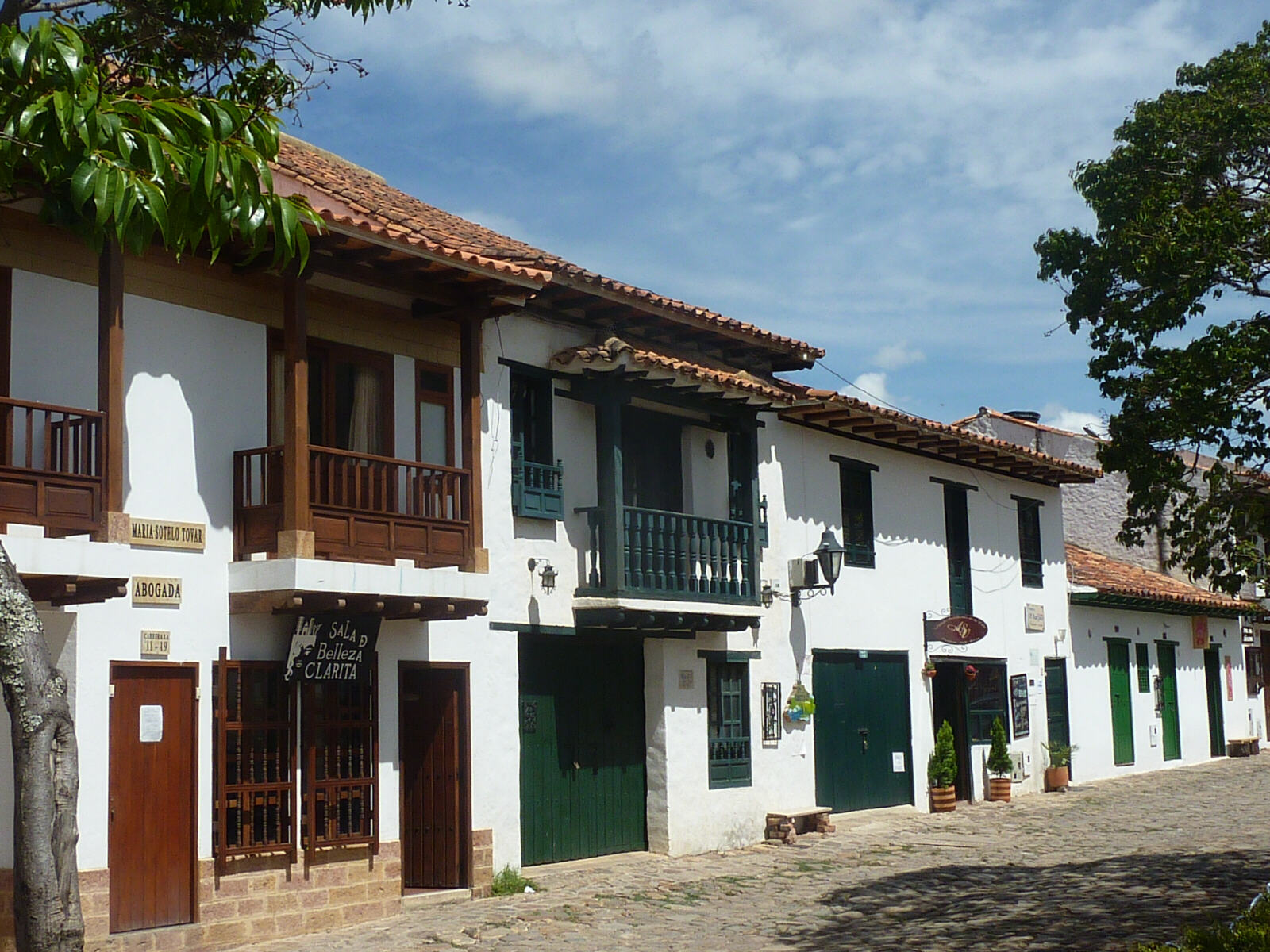
|
A nice man in the tourist office told us that nobody can build a house anywhere in Villa de Leyva unless it strictly conforms to the old-style designs, so that the character of the town remains unspoiled. |
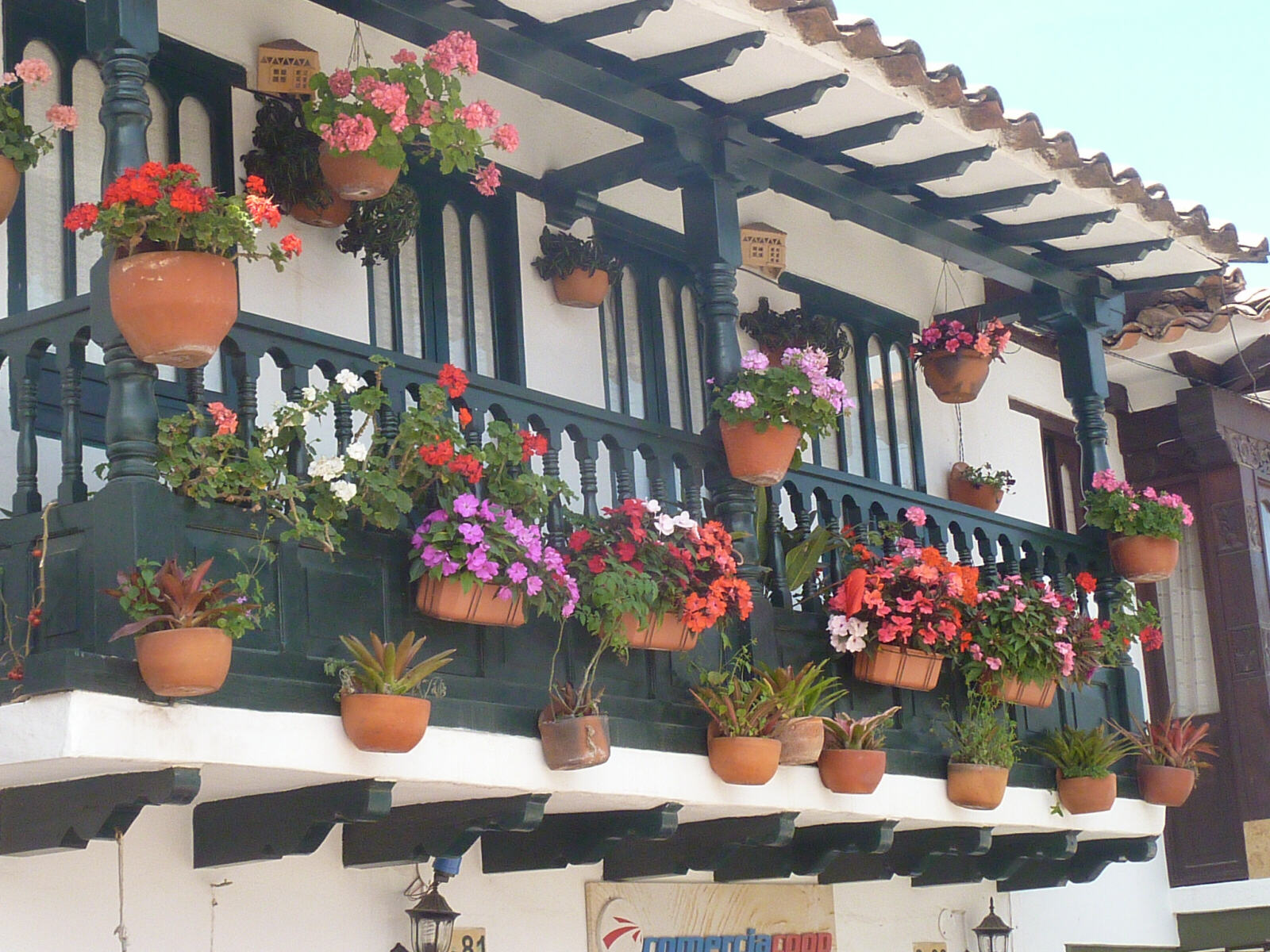
|
We stopped at El Rincon Gourmet again and had their good value, tasty set lunch. While Sheila napped off the effects of lunch I walked about, looked in the church on the square which had been closed before and stopped for a tea (which turned out to be Twinings Russian Caravan, a favourite) at a little coffee-shop in one of the colorful patios. In the evening of course we went back to the piano bar where we were welcomed like old friends and had another fantastic meal.
Sat 14th. After a nice lazy morning in the garden at Casa Terra we went by rather expensive taxi (one hour, £25) to Tunja bus terminal, where we got a Concorde line bus for the 20-hour ride to Cartagena (£35 each). It wasn´t exactly Concorde class but it was comfortable, except for the usual full-volume films in Spanish and then from 1am the equally loud music. |
Cartagena, Colombia
|
Sun 15th. By 6am we were on the Caribbean coast and it was hot and steamy outside, although the bus was still over-air conditioned and rather chilly. We stopped for an hour and a half at Baranquillo bus terminal and had a coffee, but decided not to fill up on the deep-fried snacks which seemed to be the only breakfast option. Now everything (except the language) has changed from Spanish style to totally Caribbean; the people, the culture and the climate. As a typical example, the bus (a long-distance good-quality coach) now stopped on every street corner to pick people up or let them off just like a local bus and it took us three hours altogether to get out of Baranquillo which was rather frustrating. Sheila kept going by scoffing food and ice lollies from the vendors who came on and off the bus. We eventually got to Cartagena bus station at 11am and got a taxi to Casa Santa Ana boutique hotel in the old town, which was lovely; it´s like an oasis with palm trees and exotic plants. We had the most wonderful suite that Sheila had insisted we book weeks ago. It was about 50 feet long and the same high, on two levels with a vast living room downstairs the full height of the house with two big shuttered windows, and a bedroom up a spiral staircase to the next level which looked over a balcony down to the living room. There were three fans, air-conditioning and an enormous TV with a channel that shows endless Top Gear repeats! |
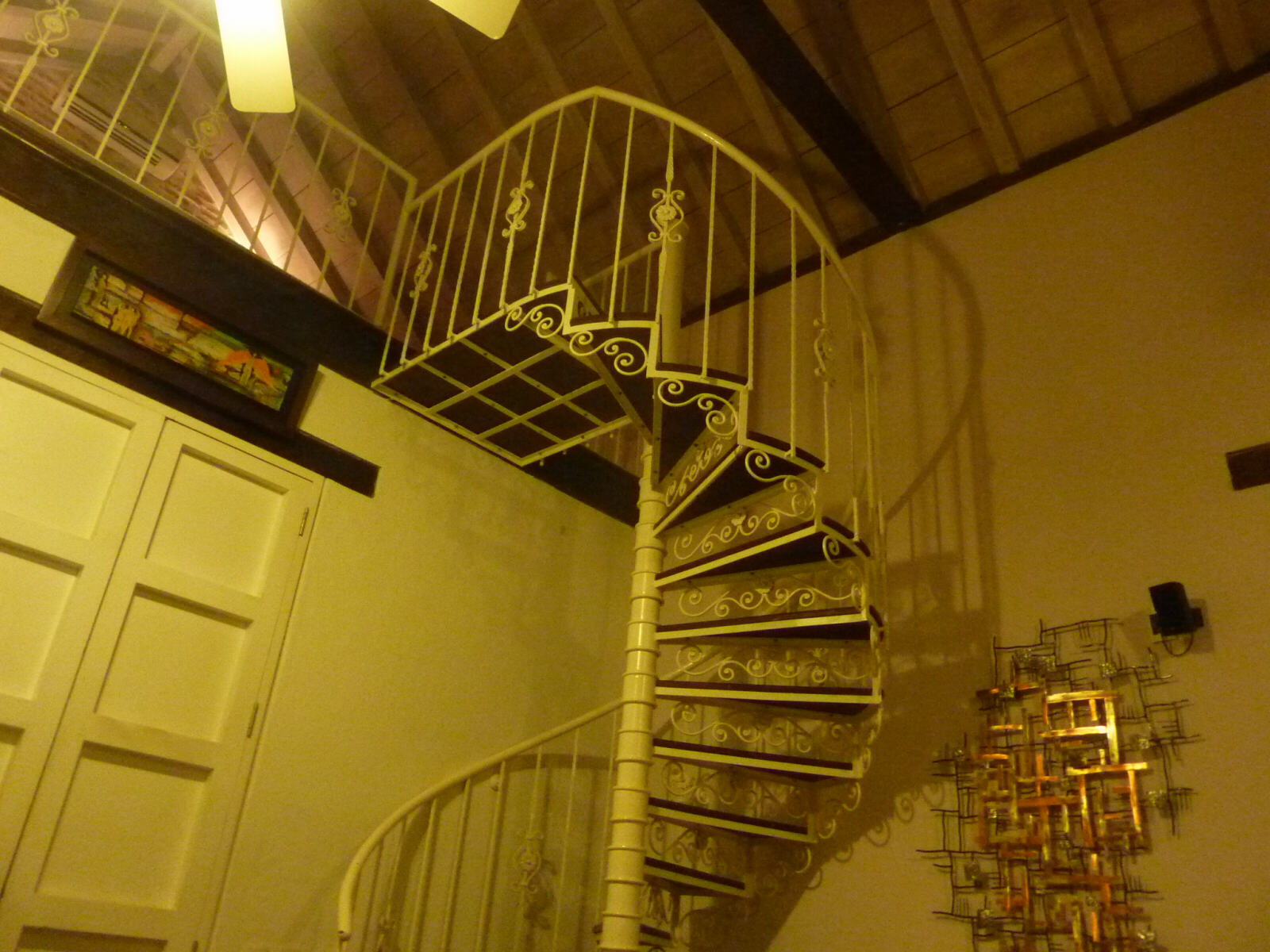
|
They made us the most delicious cold lemon cocktail drink while we waited for the room to be ready (should have got the recipe), then we moved in and made ourselves at home. We were starving, having not eaten since yesterday lunchtime (although we could have kept going on the fat we’ve put on in the previous weeks), so we went down the road where many of the restaurants were closed because yet another festival was in progress, and found a nice place called Castellana on the corner opposite a plaza where we had fried potatoes with chorizo and iberico ham with fried eggs on top (good and healthy!). We went out in search of the festival but it wasn´t as pleasant as the previous ones, the music blaring from huge speakers on the street was a physical assault, the people weren´t very friendly and the big joke was to spray some sort of foam from cans over each other and us if they got the chance. We went back to Castelana and had a nice meal with a big jug of cold Sangria to wash it down.
Mon 16th to Weds 18th. There was a good choice of breakfasts at Santa Ana, sitting beside the nice garden. Later we went for walking tours all around the historic old town, looking at shops, restaurants, churches .... |

|
.... and mostly the pretty houses with balconies with colourful flowers draped over them.
|
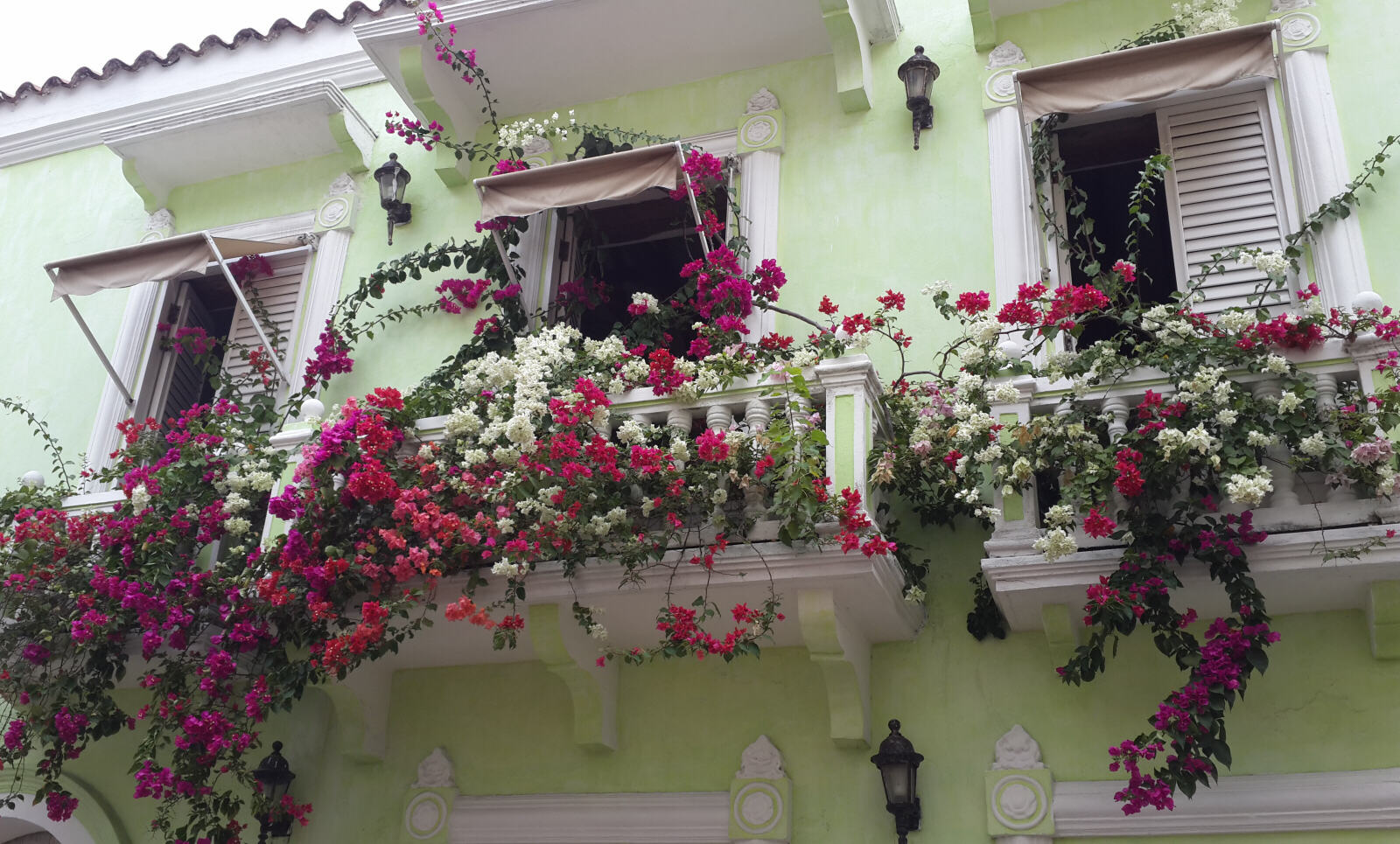
|
Just as we were heading back for some lunch a thunderstorm broke and the most torrential rain came down so we dived into the KGB bar, a Russian-themed place with all sorts of Soviet Union memorabilia all over the walls. |
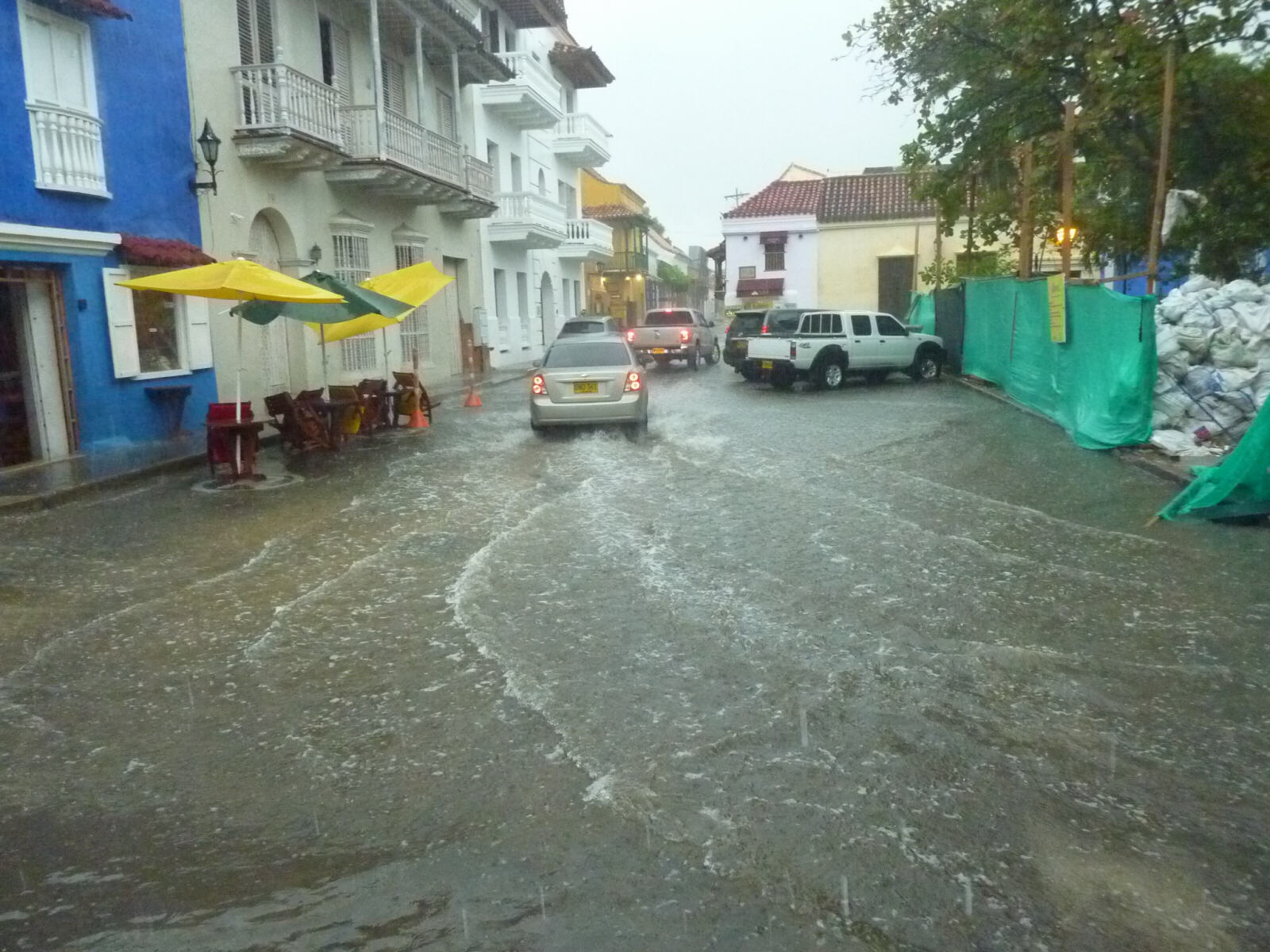
|
We sat at a window table watching the road outside turn into a torrent of water and had several beers with the only food they offered, a very tasty cocktail glass full of ceviche (raw prawns) in a lemon juice, onion and coriander sauce. |
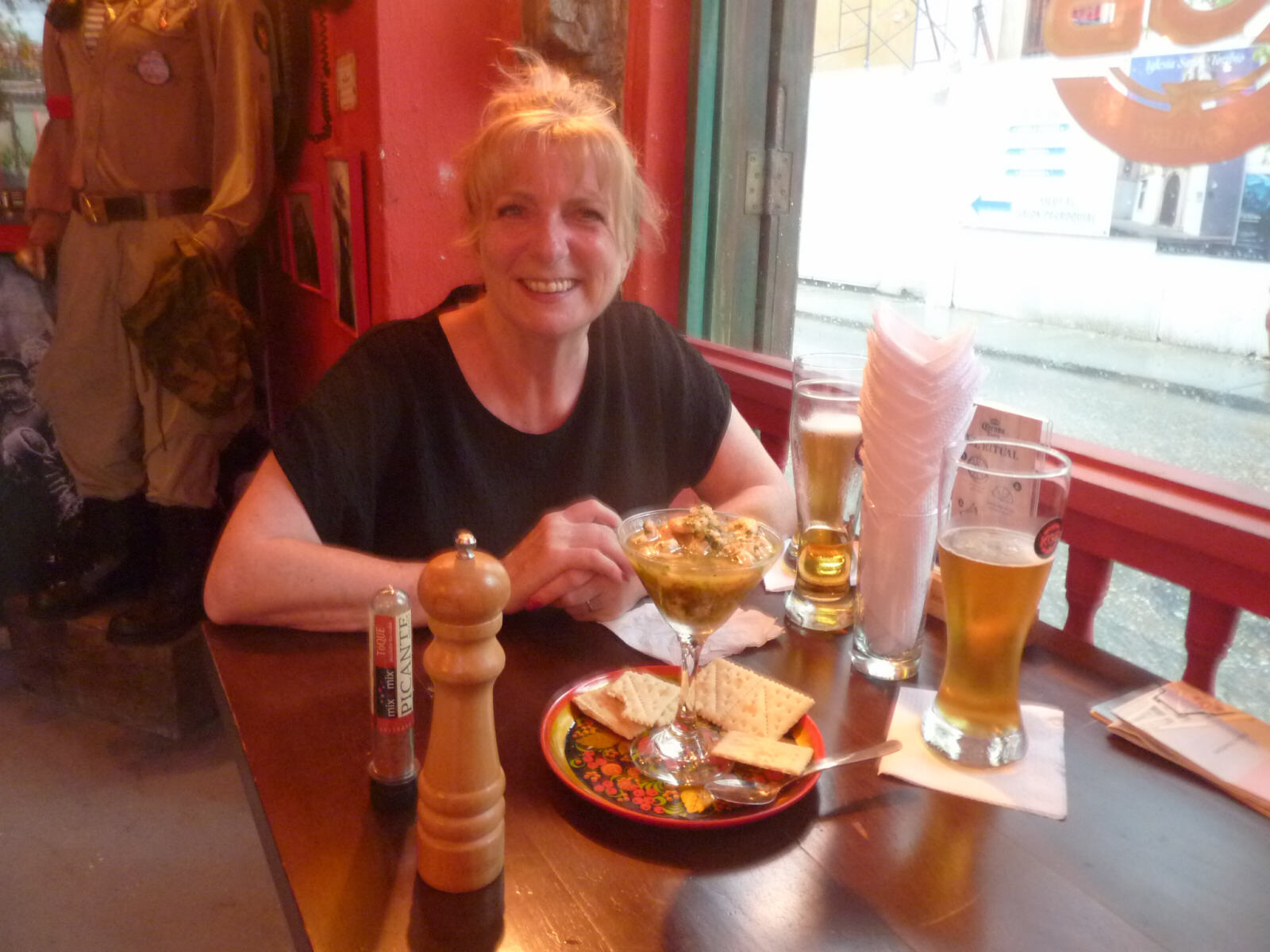
|
Another afternoon the rain more or less stopped so I went for a walk round some of the well-preserved city walls and bastions, built to keep Francis Drake and the English out, and stopped for a coffee at Mila´s patisserie. |
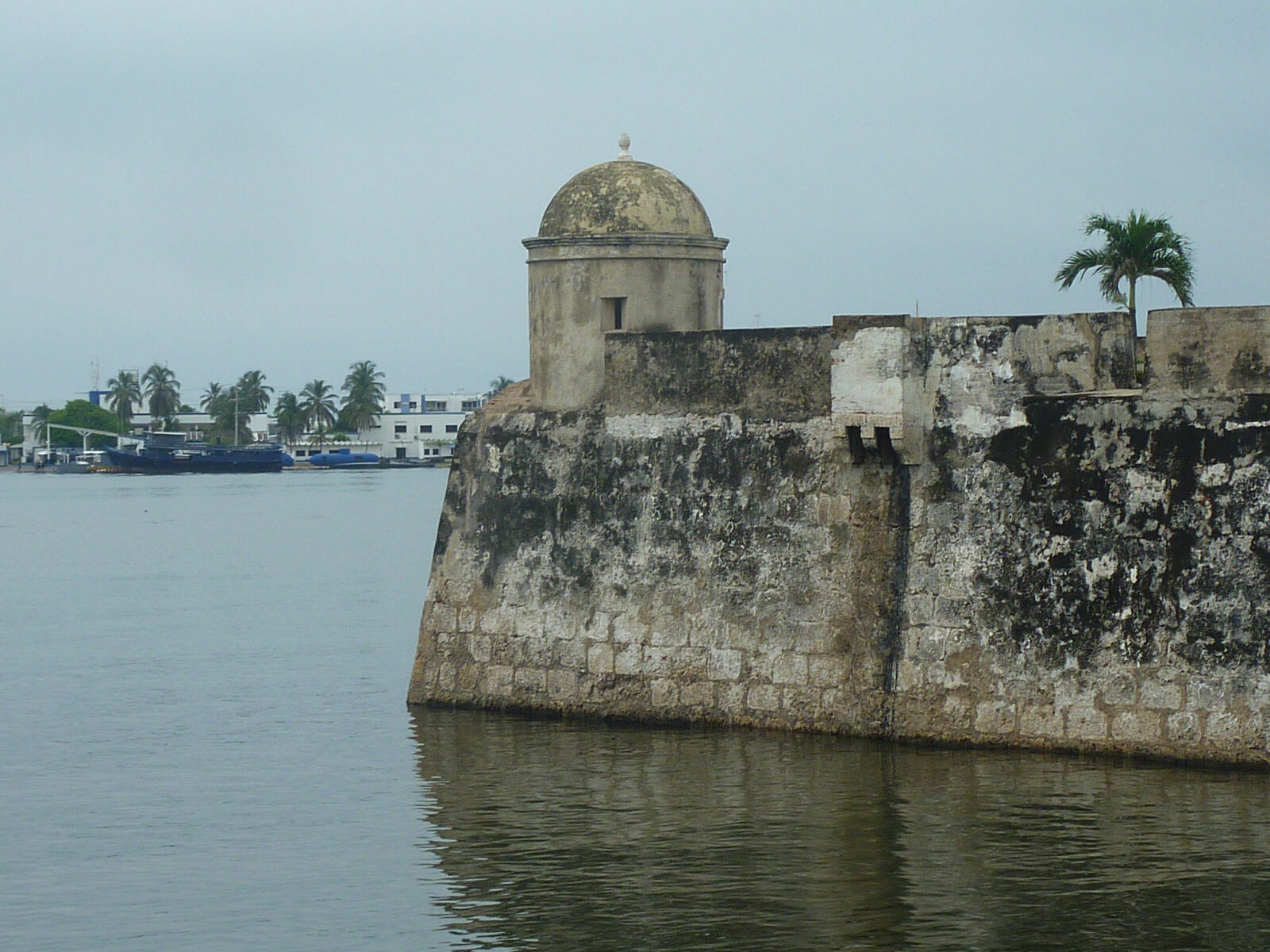
|
Sheila wanted lobster and we had been recommended to go for dinner to La Langosta just outside the city walls. It was a big, smart restaurant but almost empty, there was only one other friendly couple there from New York, who also didn´t speak Spanish. This was tricky because the menu was only in Spanish, but we managed to order three lobster halves with different sauces, thermidor, tamarind and gratin for Sheila, and a nice fish with prawns and mushroom sauce for me. Unfortunately the lobster was awful and the glasses of wine were measly, we thought they were tasters but no, that was it. Sheila was most disappointed. The next evenings we decided to ignore all recommendations and walked about the old town until a restaurant took our fancy and we went into Marzola Parilla, an Argentinian grill place that was great fun, and had spicy sausages followed by tasty Patagonian lamb. The sign on the wall outside translates roughly as: We don't have wifi, talk to each other! |
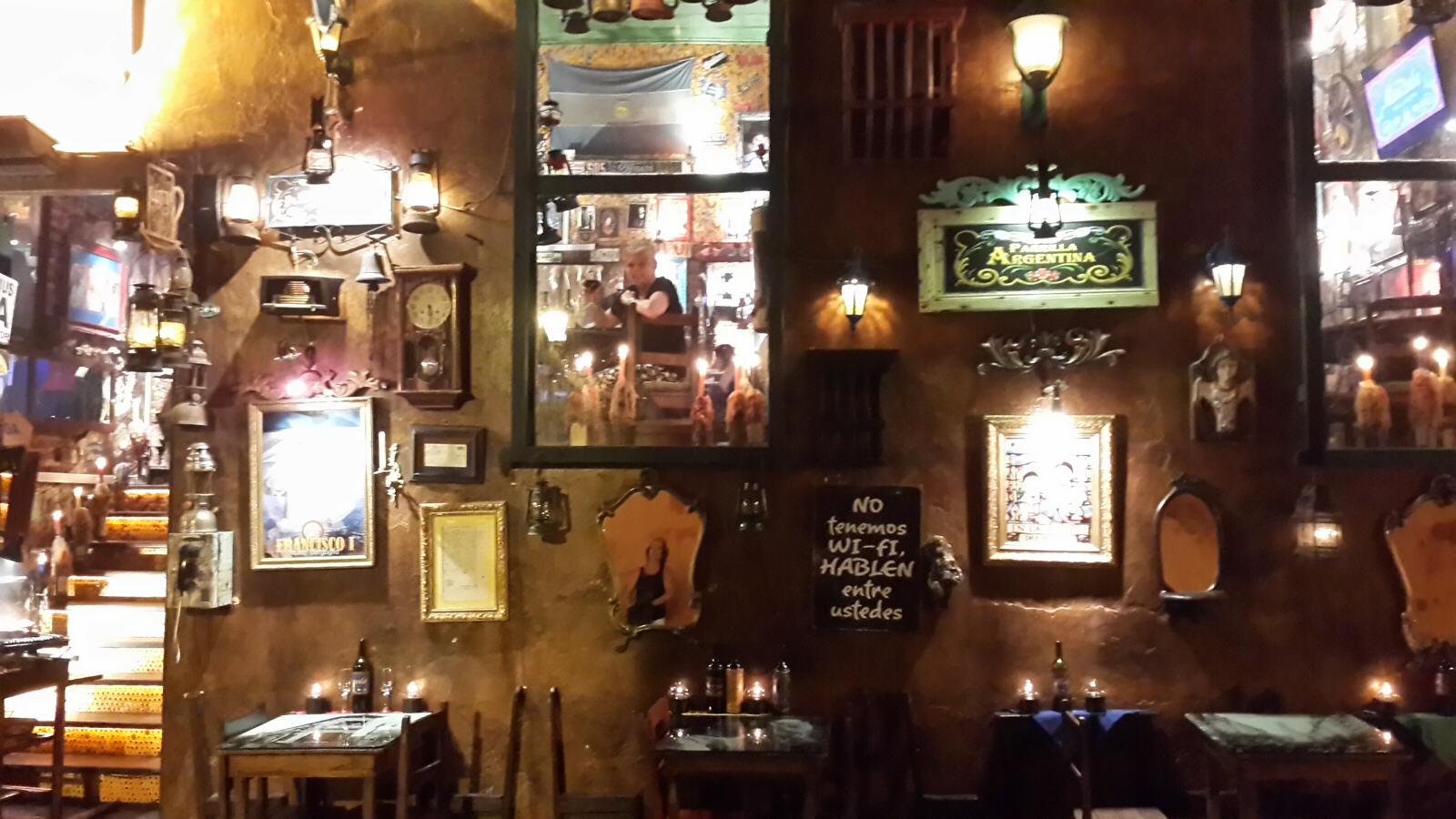
|
On our last day we went for lunch at Castellana – well, two lunches actually. We had a big 1½ litre jug of sangria and three tapas – manchego cheese, chorizo and acorn-fed Iberian ham, then because we´re having such a good time, we had exactly the same again! We eventually retired to the hotel about 4:30 feeling pleasantly woozy. |
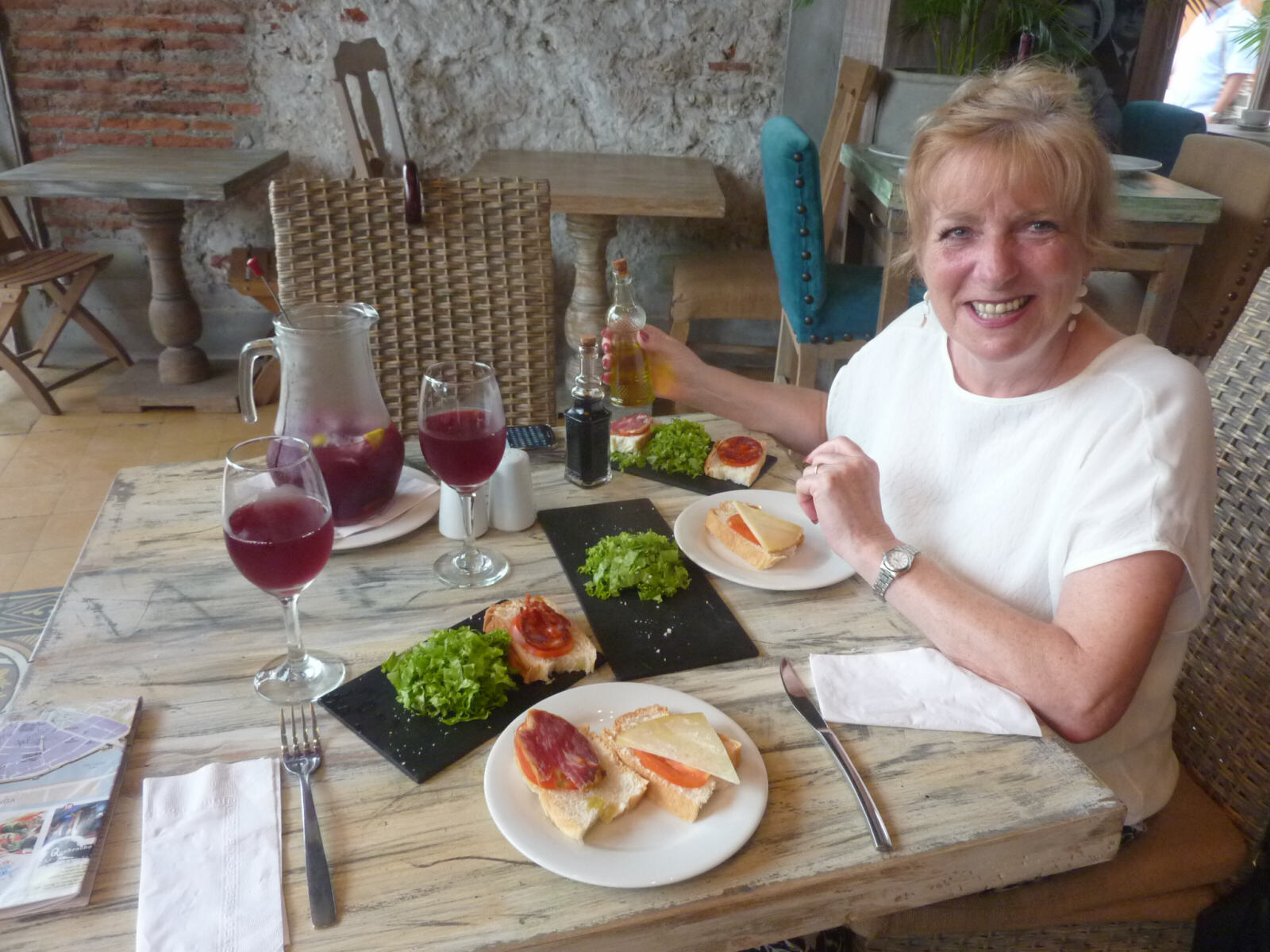
|
Bogota again
|
Thurs 19th. It was a bit of a rush to get to the airport but in fact we had spare time and had a relaxed flight back to Bogota. Our room at Regina Hotel (room 505, far enough from the intrusive muzak from the lobby but plagued by the annoying yappy dog in the adjacent courtyard) wasn´t ready so we set straight off for Sheila´s hair appointment in the Zona Rosa (Pink Zone) shopping district which was not so far away but it took an hour in the gridlocked traffic. In fact she went for the full works – hair, nails, waxing and false eyelashes (which she didn’t get on with and took them off the next day with a cotton wool pad soaked in nail varnish remover!) – while I read a book in a café, and by the time she´d finished it was nearly time for dinner. We were only a few blocks from Andres DC restaurant where we had a reservation so we walked through shopping streets and malls where all the Christmas displays were in full swing. |
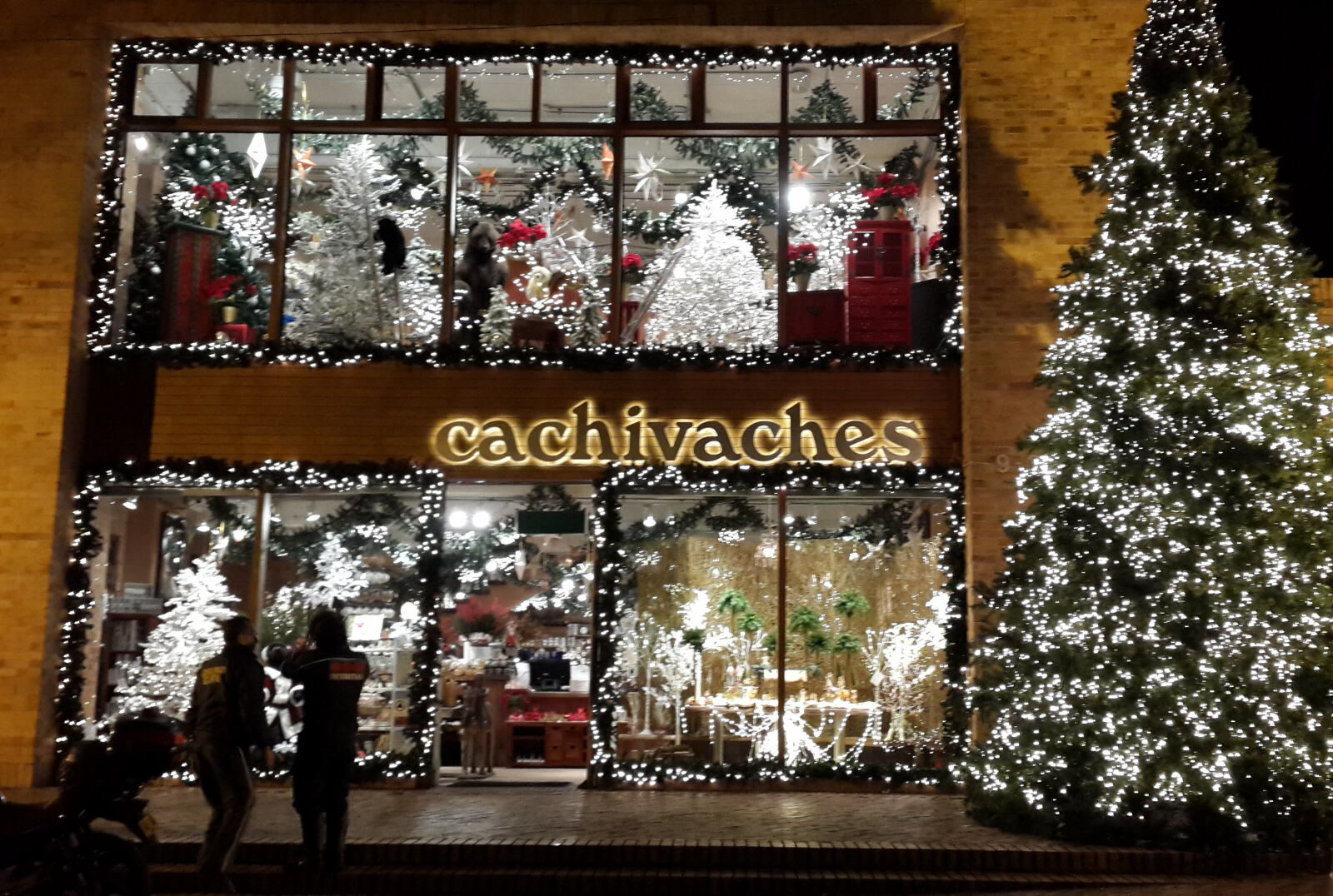
|
Andres DC was buzzing as usual with masses of atmosphere and people dancing between the tables and my steak was delicious, but Sheila´s roast suckling pig (supposed to be their speciality) was so awful she had to send it back.
Fri 20th. It was a lovely clear, sunny morning so after breakfast we got a taxi to the funicular which goes up the steep mountain that rises above Bogota, to Monserrate monastery right at the top. Before we could get to the funicular Sheila spotted a llama saddled up for tourist rides, and had her long-awaited llama ride that she’d been waiting for the whole holiday. |
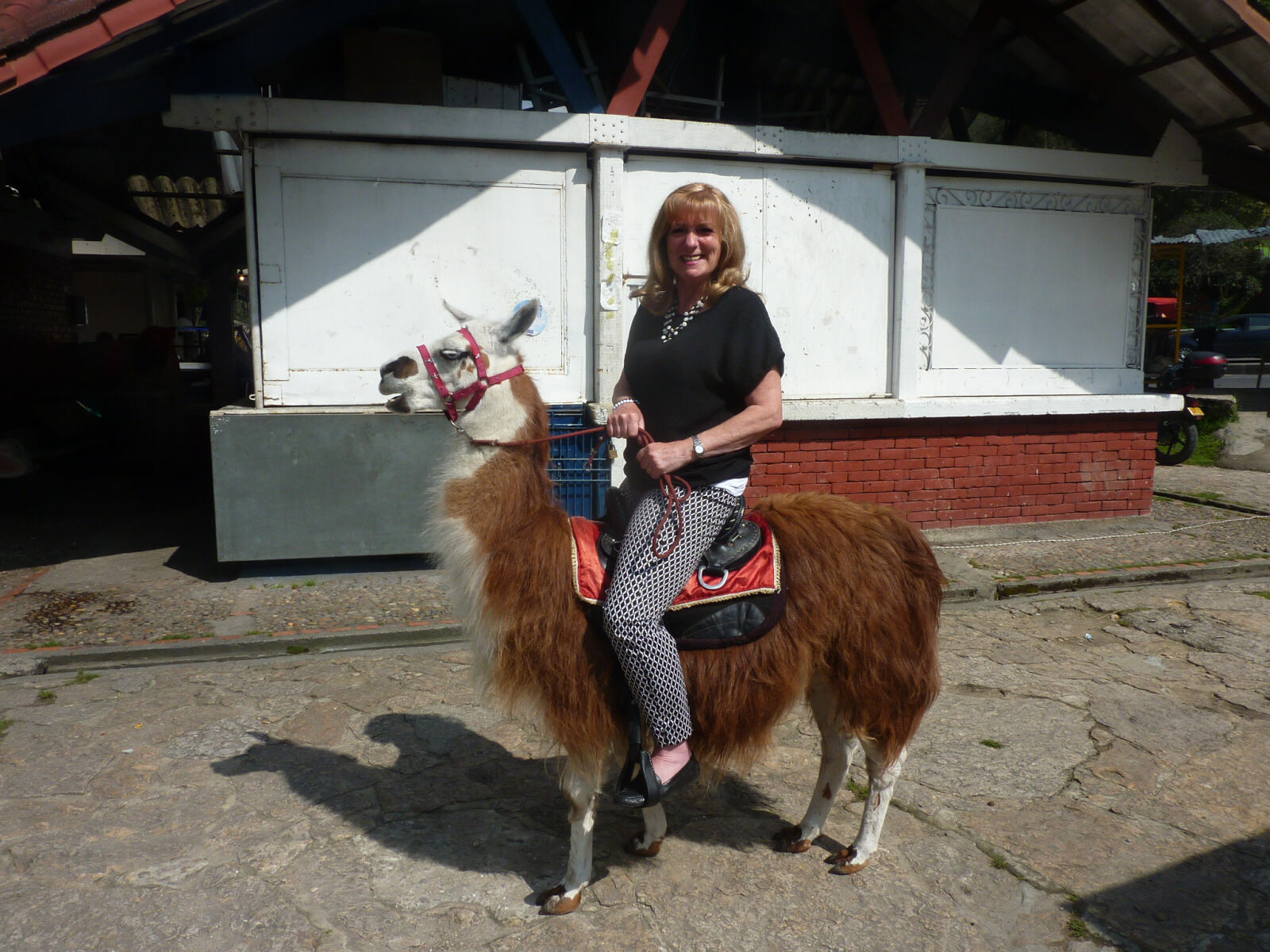
|
Eventually we got the funicular up to Montserrate, a picturesque spot with fabulous views of the city below. |
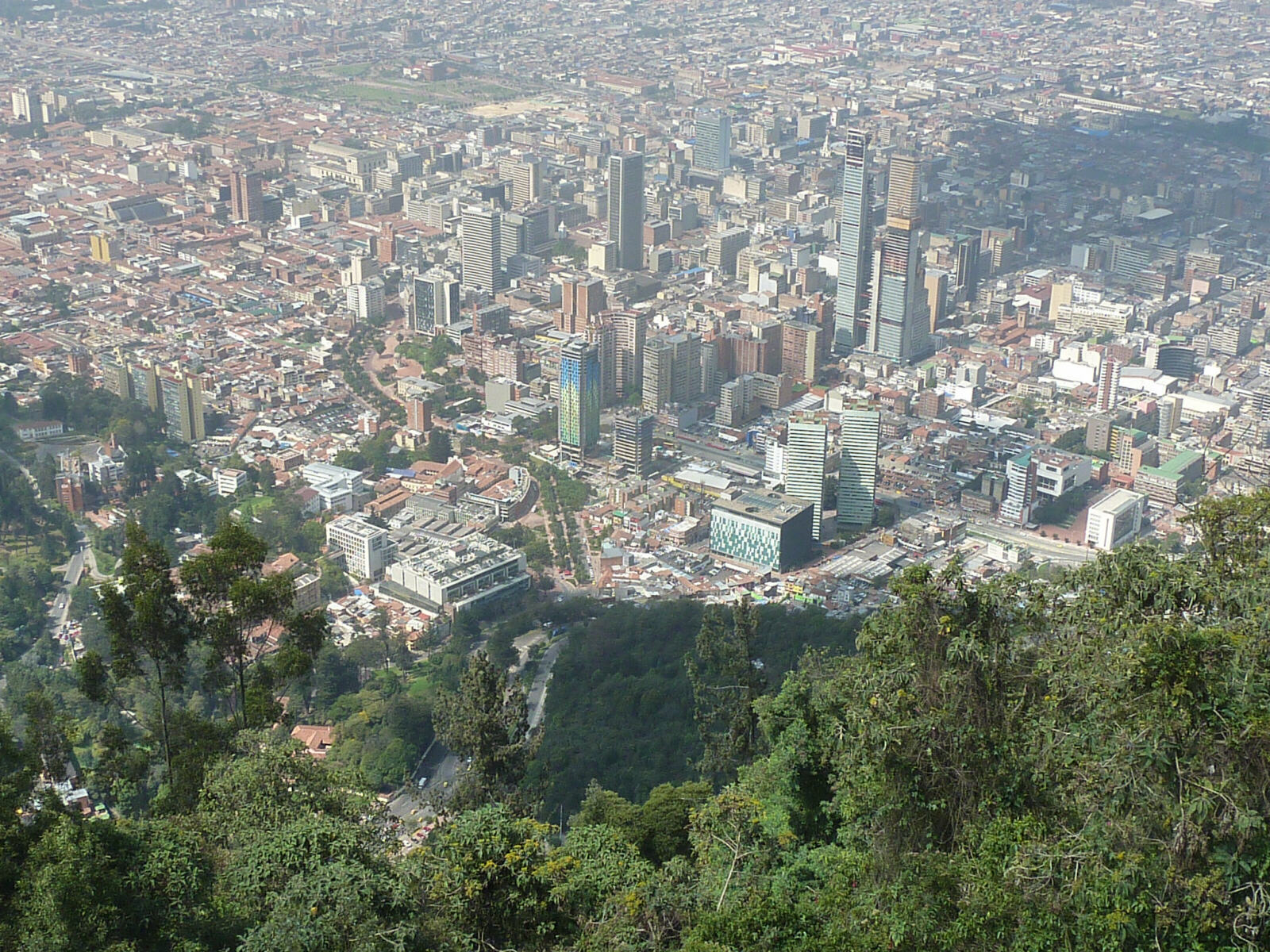
|
Next we got a taxi over to the Pink Zone where we ate last night, to revisit the shopping malls before running to the Hard Rock Café for lunch just as a huge thunderstorm broke. We originally sat outside under the awnings but the rain and wind was so fierce we had to retreat inside as all the outside tables got soaked. Once again we were told the ´four seasons in one day´ story as we had heard in several other places this trip. We had nice empanadas to start followed by very tasty pulled pork sandwiches.
Sat 21st. We started our journey home with nice wine and nibbles in the lounge at Bogota airport, courtesy of our ‘Priority Pass’ and had a good flight home via Madrid, arriving at midday on Sunday.
And finally, at last, someone who speaks my language! |
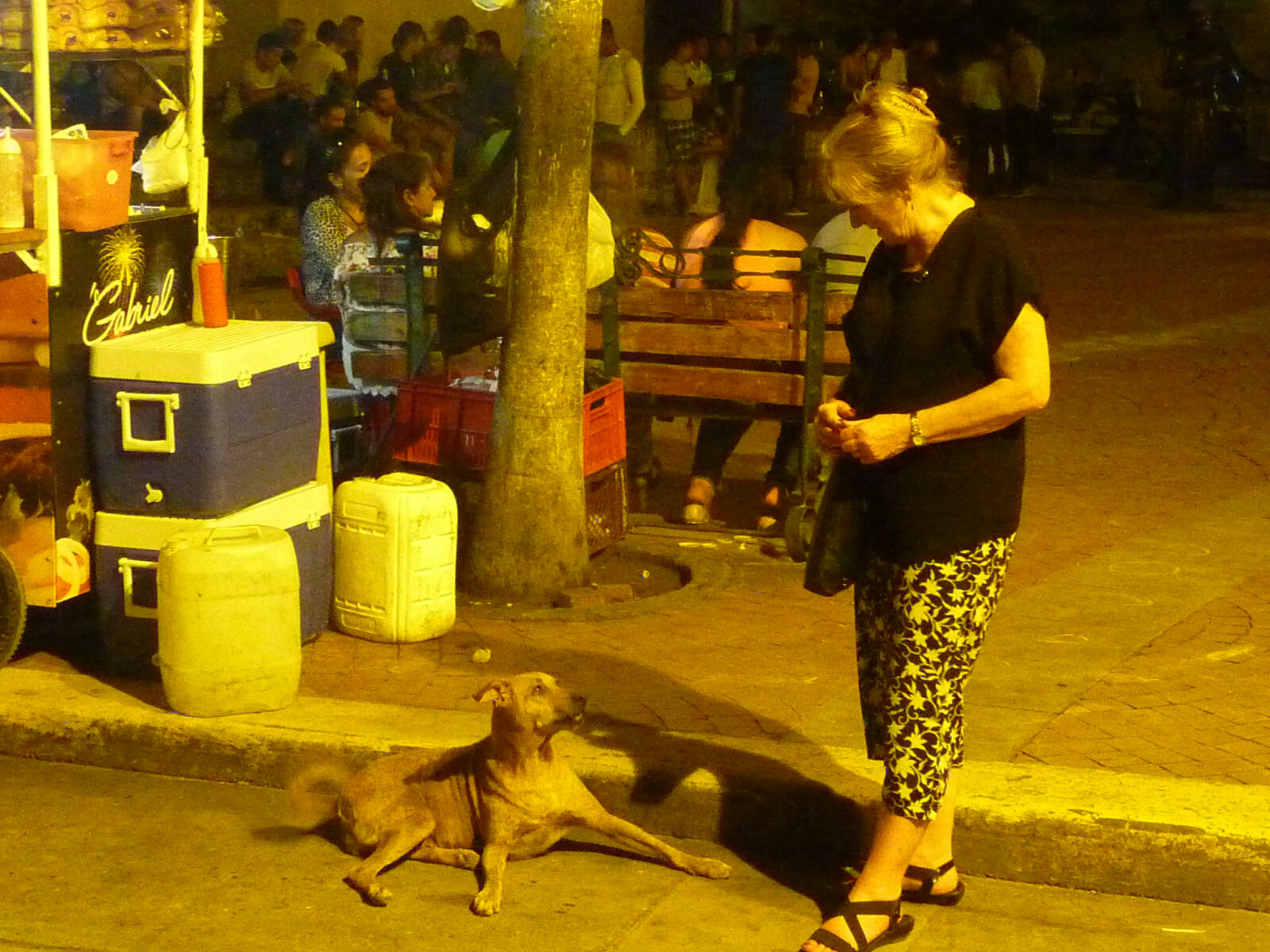
|
If you would like to see more of our travels just click the map.
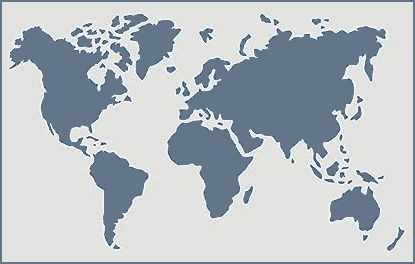
|